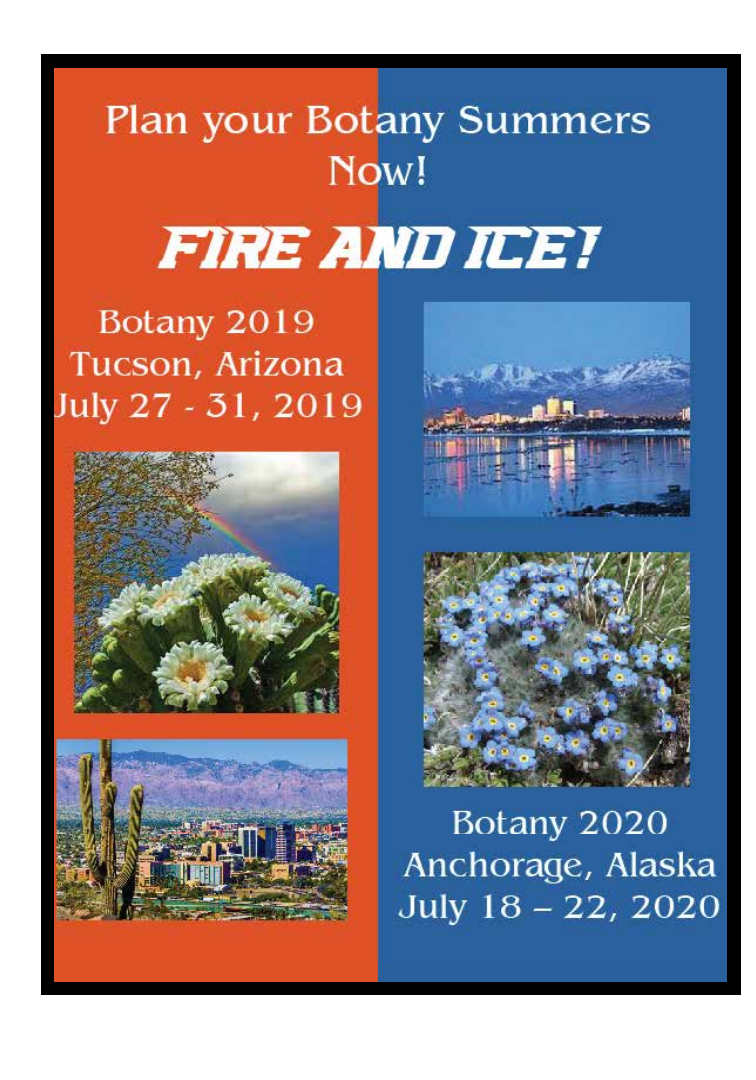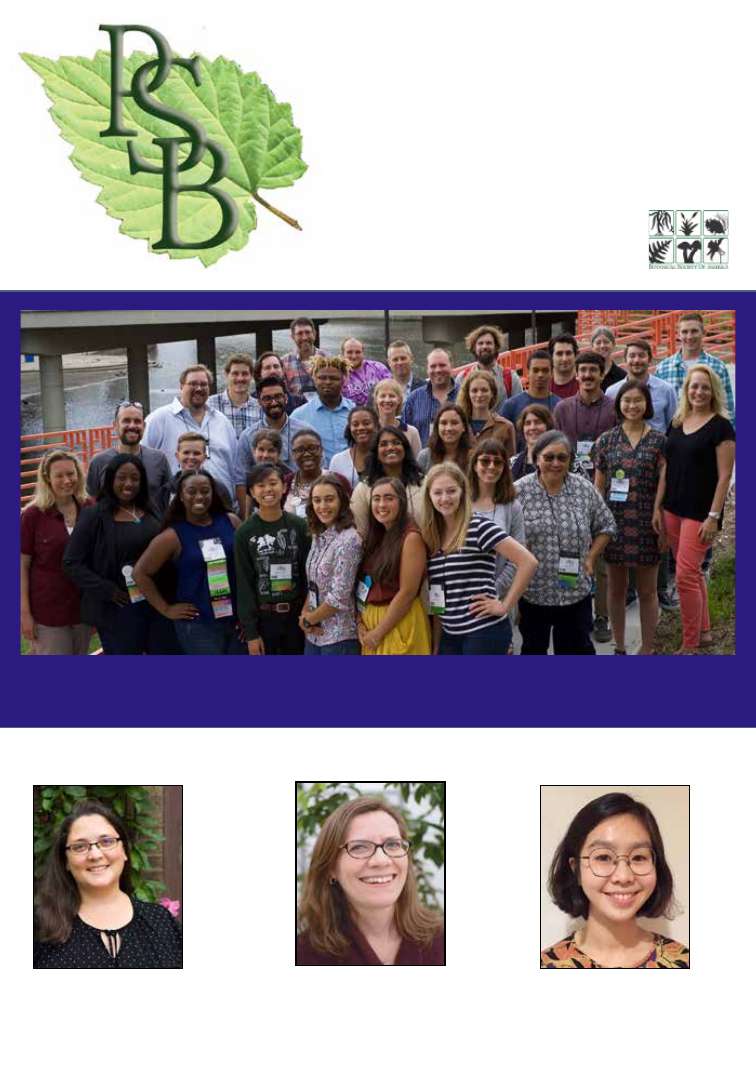
IN THIS ISSUE...
FALL 2018 VOLUME 64 NUMBER 3
PLANT SCIENCE
BULLETIN
A PUBLICATION OF THE BOTANICAL SOCIETY OF AMERICA
Theresa Culley on publishing tips for
junior researchers...p.167
Get to know new BSA student rep,
Min Ya....p. 192
Meet Amelia Neely, BSA’s new member-
ship/communications manager...p. 147
PLANTS Grant Fellows and Mentors at BOTANY 2018
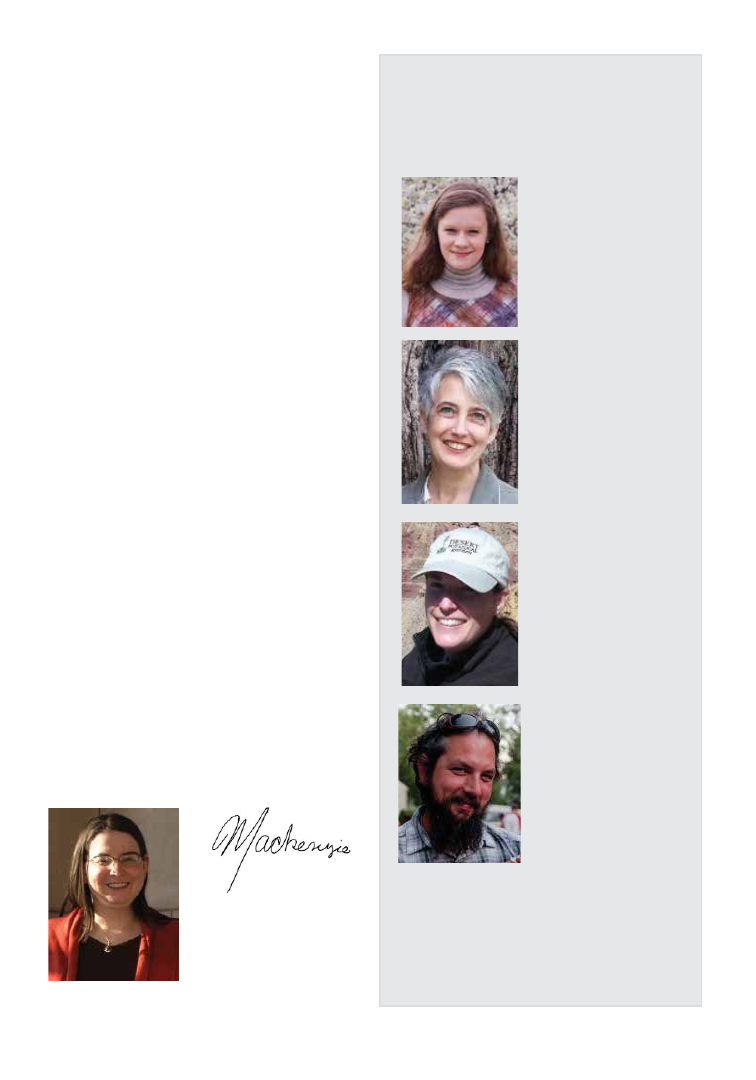
Fall 2018 Volume 64 Number 3
PLANT SCIENCE BULLETIN
Editorial Committee
Volume 64
From the Editor
Kathryn LeCroy
(2018)
Environmental Sciences
University of Virginia
Charlottesville, VA 22904
kal8d@virginia.edu
Melanie Link-Perez
(2019)
Department of Botany
& Plant Pathology
Oregon State University
Corvallis, OR 97331
melanie.link-perez
@oregonstate.edu
Shannon Fehlberg
(2020)
Research and Conservation
Desert Botanical Garden
Phoenix, AZ 85008
sfehlberg@dbg.org
David Tank
(2021)
Department of Biological
Sciences
University of Idaho
Moscow, ID 83844
dtank@uidaho.edu
Greetings,
Happy autumn to all in the northern hemi-
sphere. The fall of leaves means that, in the
United States, we are drawing close to a crit-
ical mid-term election. It is hard for me to
forget this since I am bombarded by cam-
paign ads from both Iowa and Nebraska. We
all know that elected officials have a tremen-
dous impact on scientific research and on
how science is incorporated into public poli-
cy. Yet, it can be overwhelming to attempt to
effect change as a citizen, especially in a time
when there are so many pressing politicized
issues.
In this issue, the public policy committee sets
out a framework for participating in civic life
as a scientist that we hope you will find useful.
We also present an article from the winners
of the 2018 Botanical Advocacy Leadership
Award. This important award provides fund-
ing to support local efforts that contribute
to shaping public policy. For a more histor-
ical perspective, we bring you remarks from
BSA President-Elect Dr. Andrea Wolfe, who
surveyed science policy under the last four
presidential administrations as evidenced by
newspaper articles and discusses why science
really does matter. I hope that you find these
articles both educational and inspirational!
Cheers,

135
SOCIETY NEWS
We live in a technological era where information
can be used, abused, misinterpreted, and virally
shared for presenting ideological viewpoints
without regard to accuracy of content. When
this involves science and government policy,
the potential for major consequences to the
environment, society, scientists, and future
generations exists.
Several years ago, I started using Merchants
of Doubt (Oreskes and Conway, 2010) for a
supplemental textbook in my “Society and
Evolution” course. The subtitle for this book
is “How a handful of scientists obscured
the truth on issues from tobacco smoke to
global warming.” The book describes how a
small number of scientists could be used by
political entities to misrepresent the majority
opinion of other scientists with regards to the
causes and environmental impacts of acid
rain, atmospheric ozone holes, global climate
change, as well as the health effects of tobacco
use and environmental consequences of
pesticide use. What struck me as particularly
By Andrea Wolfe
The Ohio State University
Department of
Evolution, Ecology, and
Organismal Biology
E-mail: wolfe.205@osu.
edu
Science—It Really Does Matter
Remarks from BOTANY 2018
by President-Elect Andi Wolfe
dangerous was how politicians and political
lobbyists use small bits of scientific studies
that agree with their ideological viewpoints to
influence public policy that may affect several
generations after regulations are enacted or
rescinded.
My “Society and Evolution” course focuses on
trying to understand why some populations
of the USA are anti-evolution and, in general,
anti-science. My students do several research
projects where they mine databases to look at
trends of acceptance or denial of evolution,
based on stories covered in local, regional,
national, and international newspapers. One
of the outcomes of these projects is a better
understanding of the role of religion and
politics in science education and science
literacy.
The newspaper databases offer one a chance
to see general trends about a society’s reaction
to specific opinions, policy, and scientific
research. Thus, I found myself turning to
newspaper archives when I decided to talk
about why science matters in society. I wanted
to investigate how government leadership
can affect science policy and debate, and I
was interested in seeing how government
policies impact scientific research and science
education. Also, I was curious about how
political biases may have an impact on science
literacy, and how this might affect efforts for
science communication.

PSB 64 (3) 2018
136
How government leadership
impacts scientific research
and debate
My focus was on the most recent U.S.
administrations, straddling the end of the
20th- and into the 21st-century. This included
the administrations of Bill Clinton (1993-
2001), George W. Bush (2001-2009), Barack
Obama (2009-2017), and Donald J. Trump
(2017-current). I searched the Newspaper
Source database with the following
words in the all-text mode: science (and)
president’s name (and) policy. The number
of articles returned ranged from 756 (Trump
administration, covering 1.5 yr) to 1,974 (Bill
Clinton administration); there were 1,319 and
1,564 articles returned for Obama and Bush,
respectively. Not all of the articles referred
to science policy, but there was a sufficient
number of articles with repeated themes to
take the pulse of an administration’s attitude
about science, and the role of science in
administrative policy.
Headlines from each administration are listed
in Table 1, along with either quotes from,
or notes about, the article. There are very
clear trends regarding an administration’s
attitude about science, and the effect it has
on policy decisions. First, from 1993 to 2018,
administrations with a Democrat as president
were pro-science, pro-environment, and used
advice from scientists before making decisions
about policy. For example, Clinton expanded
wilderness areas and enacted environmental
protections aimed at reducing pollution and
greenhouse gas emissions. Clinton was also
concerned about the declining test scores for
U.S. high school students on standardized
tests for math and science. Obama started
his administration by recruiting well-
known scientists to fill cabinet positions for
departments that need science expertise. He
also implemented strategies for increasing
funding for science, reducing the nation’s
need for fossil fuels, enforcing environmental
regulations on greenhouse gas emissions, and
releasing restrictions on scientific research
that were based on conservative ideology.
In contrast, both Republican presidents
during this period had a pattern of
ignoring or misusing science, reducing
funding for basic research, and rolling back
environmental regulations to benefit the fossil
fuel energy industry. Under both Republican
administrations, climate change denial was
systematic throughout federal agencies.
The Bush administration focused its efforts
for science research on homeland security,
and implemented restrictions on science
research that offended the conservative right
population. This had impacts on basic research
in that scientists had restrictions about who
could work with them, what topics could be
studied, and how, or if, scientific results could
be disseminated. Trump’s administration is
anti-science, and this is reflected in the sheer
number of articles that address his “war on
science,” his campaign to turn public lands
into opportunities for businesses to exploit,
and his enabling the federal government,
particularly science and environmental
agencies, to implode due to mismanagement.
The role of government in
scientific research and
science education
Given the above information about the major
differences the political party of a president
has on American science, I wanted to know if
the government has a role in scientific research

PSB 64 (3) 2018
137
President
Date(s) Headline
Publication
Notes
Bill Clinton
(Democrat) 1993-2001
03/08/1995
Endangered Species
Act faces its own dan-
gers
Christian Science
Monitor
The recently formed Senate Republican Regu-
latory Relief Task Force put the ESA at the top
of its “Top Ten Worst-Case Regulations.”
05/19/1995
The GOP needs a bit
more R&D on its sci-
ence and technology
policy
The Washington Post
Congress had made a point to change the bud-
get submitted by Clinton to reduce spending
efforts on science.
07/04/1995 A Department of Sci-
ence?
The Washington Post
This was an attempt by Republicans to con-
solidate NASA, NSF, EPA, USGS, NOAA, the
Patent & Trademark Office, and research arms
of the Energy and Commerce Departments.
It would have changed funding for each of
the agencies, with major impacts on basic re-
search. The initiative failed.
09/07/1995
Alaska becomes test
of wills on Federal
land policy
Christian Science
Monitor
This was about how a Republican-led Congress
attempted to open the Arctic National Wild-
life Refuge and Tongass National Forest to oil
drilling.
02/19/1997 States feud with EPA
Christian Science
Monitor
“After giving states more power to protect
clean air and water, the Clinton administration
is threatening to take back such controls be-
cause of concerns that, in some states at least,
devolution means more pollution.” The EPA
argued that state laws for pollution were too
lax. Ironically, it was Michigan that was fight-
ing Federal oversight.
10/30/1997 Greenhouse gas plan
faces GOP red light
Christian Science
Monitor
Clinton’s proposals for international action
to combat global warming were considered
too lax by environmentalists and Europeans,
but too strict by Republicans because the link
between greenhouse gas emission and global
warming “is not firmly established.”
03/17/1998 Clinton proposes test-
ing
New York Times
High school seniors were performing poorly
on standardized math and science tests. Clin-
ton proposed testing high school teachers to
prove competency prior to receiving a teach-
ing license.
06/15/1999
Clinton plan hopes to
reassert the value of
‘wilderness’
Christian Science
Monitor
Clinton was trying to set aside five million
acres of national park land as wilderness, pri-
marily to prevent development.
11/15/2000
In last days, Clinton
begins environmental
offensive
Christian Science
Monitor
Clinton ordered one-third of America’s na-
tional forests to be made off limits to logging,
mining, and road-building.
George W.
Bush (Repub-
lican)
2001-2009
04/20/2001 Bush walks fine line
on ecology
Christian Science
Monitor
Critics of Bush’s appointments and early deci-
sions on global warming and endangered spe-
cies policies state that Bush “has declared war
on the environment.”
Table 1. Headlines about science and policy from the past four administrations in the United States.

PSB 64 (3) 2018
138
06/17/2001
Sure, it’s rocket sci-
ence, but who needs
scientists?
New York Times
“Indeed, some experts believe that science’s in-
fluence in public policy matters has not been at
such a low ebb since before World War I.”
07/24/2001
Researchers forecast
rapid, irreversible cli-
mate warming
Environmental News
Network
“The United States signed the Kyoto Protocol
under the Clinton administration, but Pres-
ident George W. Bush announced in March
that the United States would not ratify the
treaty. This move caused a crisis in the inter-
national approach to the agreement since the
United States emits 25 percent of the world’s
heat-trapping greenhouse gases.”
08/02/2001 As House votes on en-
ergy plan, oil booms
Christian Science
Monitor
“The House expects to vote on Bush’s initia-
tive—which stresses boosting production—by
the end of the week.”
11/05/2001
Science a proven tool
in ensuring homeland
security
The Dallas Morning
News
The attitude toward science changed after 9/11,
but only with regard to homeland security.
11/27/2001
Scientists ponder lim-
its on access to germ
research
New York Times
In response to 9/11, and concerns about bio-
terrorism, there were proposals to restrict ac-
cess to information and materials that might
be used for biological weapons.
“Already several proposals have been made in
Congress to forbid some people, including cer-
tain foreigners, from working in laboratories
that handle dangerous microbes.”
10/19/2002
Researchers say sci-
ence is hurt by secre-
cy policy set up by the
White House
New York Times
“The presidents of the National Academies
said yesterday that the Bush administration
was going too far in limiting publication of
some scientific research out of concern that it
could aid terrorists…Specifically, they said, the
administration’s policy of restricting publica-
tion of federally financed research it deemed
‘sensitive but unclassified’ threatened to ‘stifle
scientific creativity and to weaken national se-
curity.’”
12/06/2002
Now, science panelists
are picked for ideolo-
gy rather than exper-
tise
Wall Street Journal
Scientific advisory panelists for federal agen-
cies was controversial due to selection of can-
didates with conservative ideologies rather
than on their skills or experience.
07/08/2003
Policy as arcade game:
when science crosses
Bush agenda, it takes
a beating
The Philadelphia
Inquirer
“President Bush is playing Whack-a-Mole
with scientific reports that he doesn’t like: Un-
comfortable facts about global warming pop
up in an environmental report card. Whack!
Yellowstone National Park staffers tell a world
treasures watchdog that the park is in trouble.
Whack! The Environmental Protection Agen-
cy discovers a senator’s clean air bill is more
effective than the president’s. Whack! But the
moles are popping up faster than the Bush
team can beat them back. Information is leak-
ing out. A pattern of deception is emerging.”

PSB 64 (3) 2018
139
02/23/2004 Uses and abuses of
Science
New York Times
“Although the Bush administration is hardly
the first to politicize science, no administra-
tion in recent memory has so shamelessly dis-
torted scientific findings for policy reasons or
suppressed them when they conflict with polit-
ical goals.” This was from an indictment deliv-
ered by >60 prominent scientists, including 20
Nobel laureates.
Barack Obama
(Democrat) 2009-2017
01/14/2009 EPA nominee vows to
rely on science
USA Today
Obama began his administration by filling his
cabinet with qualified individuals.
01/20/2009
Boulder, Colo.
area scientists cheer
Obama
Daily Camera
“After eight years of pervasive political med-
dling in science, according to the Union of
Concerned Scientists, researchers in Boulder
are cheering Barack Obama, who has prom-
ised to return integrity to U.S. science policy…
Obama has promised to double federal invest-
ment in basic research, and he has nominated
distinguished researchers for key positions,
such as tapping Nobel Prize-winning physicist
Steven Chu for secretary of energy.”
01/27/2009 Elevating science, ele-
vating democracy.
New York Times
Essay by science editor Dennis Overbye: analy-
zing Obama’s inaugural speech, where Obama
proclaimed that he would “restore science to
its rightful place.” The president also vowed to
harness technology for clean energy.
01/28/2009
Climate expert says
global warming will
be major priority of
Obama Presidency
Irish Times
Mentions Obama’s appointment of experts to
his cabinet, and vows to prioritize clean energy
initiatives.
02/26/2009
A d m i n i s t r a t i o n
tasked with undoing
Bush-era policies on
air quality
The Press-Enterprise
“Less than six weeks after George W. Bush left
office, clean-air advocates are wasting no time
under the new administration to push for new
and tougher regulations. Several of the former
president’s air pollution policies already are in
jeopardy, raising hopes among clean-air advo-
cates and fears among those who worry that
industries could get hit with higher costs du-
ring a recession.”
03/10/2009
Editorial: Finally: The
right approach to sci-
ence
Obama puts his own
spin on the mix of sci-
ence with politics
La Crosse Tribune
New York Times
Reports on Obama’s efforts to have policies
built on science rather than ideology. This was
specifically in reference to rolling back the
regulations on embryonic stem cell research
from the Bush administration.
07/20/2009 Mo. Lawmaker battles
Obama agenda
St. Louis Post-Dispatch
“In his first months in office, [Blaine] Luetke-
meyer, R-St. Elizabeth, has established himself
as an unwavering conservative, a budget hawk,
and a critic of global warming theories who is
so certain in his beliefs that he accuses Nobel
Prize winners of ‘junk science.’”

PSB 64 (3) 2018
140
12/28/2010
Science bill could
bring federal money
to the Valley
The Monitor
“A relatively unknown bill affecting science
education and job creation won overwhelm-
ing approval in the U.S. Congress before it re-
cessed, and could energize science-related op-
portunities in South Texas.” This was referring
to the America Competes Reauthorization Act
(ACRA), which had unanimous approval in
the Senate and was approved at 228-130 in the
House of Representatives.
11/19/2012 Rubio: ‘I’m not a sci-
entist’
GQ Magazine
This was one of many stories during the Obama
administration about Republican politicians
making a statement about their lack of scien-
tific literacy, and that their decisions about sci-
ence policy were based on other factors.
05/14/2014
All science is wrong,
concludes esteemed
Fox News panel
New York Magazine This was an article about partisan pushback on
science.
05/30/2014
Why do Republicans
always say ‘I’m not a
scientist’?
New York Magazine
“’I’m not a scientist’ allows Republicans to
avoid conceding the legitimacy of climate sci-
ence while also avoiding the political downside
of openly branding themselves as haters of sci-
ence. The beauty of the line is that it implicitly
concedes that scientists possess real expertise,
while simultaneously allowing you to ignore
that expertise altogether.”
Donald J.
Trump (Re-
publican)
2017-cur-
rent
11/19/2016
Climate change in
Trump’s age of igno-
rance
New York Times
“We now live in a world where ignorance of a
very dangerous sort is being deliberately man-
ufactured, to protect certain kinds of unfet-
tered corporate enterprise. The global climate
catastrophe gets short shrift, largely because
powerful fossil fuel producers still have enor-
mous political clout, following decades-long
campaigns to sow doubt about whether an-
thropogenic emissions are really causing plan-
etary warming. Trust in science suffers, but
also trust in government. And that is not an
accident. Climate deniers are not so much an-
ti-science as anti-regulation and anti-govern-
ment.”
11/30/2016
Trump administra-
tion’s climate-change
skeptics worry re-
searchers, advocates
KUAC FM radio
“There’s growing concern among the scientif-
ic community that President-elect Trump will
reduce or eliminate support and funding for
studying climate change.”
01/19/2017
03/12/2017
Rogue scientists race
to save climate data
from Trump
California scientists
worry that Trump will
interfere with climate
data
Science
The San Diego
Union-Tribune
Report on how scientists were saving climate
change databases under threat from Trump’s
policies at government agencies such as EPA,
US Department of Interior, and others.

PSB 64 (3) 2018
141
01/31/2017
Science will suffer un-
der administration’s
travel ban, officials
say.
New York Times
Discusses the potential impact of Trump’s trav-
el ban on people from certain countries.
01/31/2017
Why science matters
more than ever in
Trump’s America
Forbes Magazine
“It may be the only way to save the USA—and
the world—from alternative facts.”
03/03/2017
Trump plan for 40%
cut could cause EPA
science office ‘to im-
plode,’ official warns
Science
A response to cuts in program funding at EPA.
03/20/2017
03/27/2017
08/17/2017
Research is an af-
terthought in first
Trump budget
The Trump Adminis-
tration’s War on Sci-
ence
Trump’s first list of
science priorities ig-
nores climate—and
departs from his own
budget request
Science
New York Times
Science
Trump’s initial budget either made cuts or flat-
lined federal spending on science research
04/22/2017
March for Science:
Protesters gather
worldwide to support
‘evidence’
CNN
A global response to the disregard for science,
and the promotion of “alternative facts.”
05/08/2017
At FDA, TVs now
turned to Fox News
and can’t be switched
CBS News
“CBS News has confirmed an email was sent
to researchers at the FDA’s Center for Biologics
Evaluation and Research responding to appar-
ent efforts to change the channel on internal
television screens.”
05/28/2017
Editorial: Trump ap-
pointees twist facts,
deny science
St. Louis Post-Dispatch
“President Donald Trump has named two
prominent anti-abortion activists and LGBT-
rights opponents to influential positions in the
Department of Health and Human Services,
but those views aren’t what should trouble
Americans most. What is very disturbing is
that each appointee openly denies science and
facts.”
06/06/2017
85 percent of the
top science jobs in
Trump’s government
don’t even have a
nominee
The Washington Post
This trend continued up until the time of my
BOTANY 2018 talk. The only agencies with a
complete complement of scientists more than
a year later from the publication date of this
article were Education and Nuclear Regulatory
Commission.
06/28/2017
Trump will try to
sidestep science in
rolling back clean wa-
ter rule
Science
Rules enacted during the last months of a pres-
ident’s term are subject to being overturned by
the next president’s administration. Whereas
Obama’s administration relied on scientific
findings for implementing regulations, the
Trump administration was catering to the
fossil fuel industry—specifically, coal—for re-
scinding this rule.

PSB 64 (3) 2018
142
07/01/2017
10/31/2017
12/05/2017
07/10/2018
EPA chief pushing
government-wide
effort to question cli-
mate change science.
Trump’s EPA has
blocked agency grant-
ees from serving on
science advisory pan-
els.
Accumulating evi-
dence: Federal scien-
tists are being silenced
DOI restricts scien-
tists from attending
scientific conferences
The Washington Post
Science
Union of Concerned
Scientists
Union of Concerned
Scientists
Climate change information was removed
from the EPA and other agency websites,
memos stating rules about not using specific
terminology had been circulated, and regula-
tions were being rolled back concerning green-
house gas emissions. Scientists were prevented
from conducting research, attending meetings,
and serving on expert panels
07/11/2017
07/20/2017
09/01/2017
12/05/2017
04/17/2018
Trump nominates fi-
nance executive for
DOE science under-
secretary
Trump picks climate
change doubter for
USDA science job
Trump has picked
a politician to lead
NASA. Is that a good
thing?
Trump science job
nominees missing
advanced science de-
grees
Ryan Zinke refers to
himself as a geologist.
That’s a job he’s never
held.
Science
The Hill
Science
Associated Press
CNN
Cabinet positions requiring science literacy in
the Trump administration were filled by non-
or under-qualified personnel. This list includ-
ed Rick Perry, a previous presidential election
candidate who had wanted to disband the De-
partment of Energy. Trump appointed Perry to
lead that agency.
07/17/2017 Sidelining science
since day one
Union of Concerned
Scientists
“The Trump presidency has shown a clear pat-
tern of actions that threaten public health and
safety by eroding the role of science in policy.”
08/09/2017
The battle over sci-
ence in the Trump
administration
CNN
“Scientists allege policies of ‘myth over truth’
under Trump.”
12/14/2017
A year of Trump: Sci-
ence is a major casual-
ty in the new politics
of disruption
Scientific American
“From a rollback of environmental protections
to attempts to repeal the Affordable Care Act,
here’s a look at the president’s impact on sci-
ence-related issues.”
12/26/2017
‘Junk science’? Studies
behind Obama regu-
lations under fire
Fox News
“The federal report by dozens of U.S. govern-
ment scientists concludes climate change is
real and is driven almost exclusively by human
activity.”

PSB 64 (3) 2018
143
01/01/2018
The Trump adminis-
tration’s war on sci-
ence agencies threat-
ens the nation’s health
and safety
Scientific American
“Budget cuts and layoffs threaten the nation’s
health and safety.”
01/09/2018
U.S. Interior Depart-
ment to put academ-
ic, nonprofit grants
through political re-
view
Science
Grants provided by DOI to receive scrutiny to
“ensure they align with Trump administration
policies.”
01/16/2009
Citing ‘inexcusable’
treatment, advisors
quit National Parks
Panel
New York Times
The advisory panel was formed in 1935. The
majority resigned in protests of Ryan Zinke’s
plans to open protected areas to oil drilling and
mining.
01/18/2018
Trump administra-
tion is ‘abandoning
science,’ scientists
claim
Newsweek
“The White House has been sidelining ad-
vice from scientific advisory councils sin-
ce President Donald Trump took office in
January 2017, according to a new analysis
released Thursday…The report titled ‘Aban-
doning Science Advice’ by the nonprofit ad-
vocacy organization Union of Concerned
Scientists found that science advisory commit-
tees had experienced ‘unprecedented’ levels of
disrespect and neglect from the White House
and across agencies including the Environ-
mental Protection Agency, the Food and Drug
Administration and the Department of Ener-
gy.”
01/22/2018
06/06/2018
07/19/2018
The damage done by
Trump’s Department
of the Interior
Ryan Zinke is sabo-
taging our best public
lands program
Interior Department
proposes a vast re-
working of the En-
dangered Species Act
The New Yorker
Outside Magazine
New York Times
“Under Ryan Zinke, the Secretary of the Interi-
or, it’s a sell-off from sea to shining sea.”
“The secretary of the interior was once a loud
supporter of the Land and Water Conservati-
on Fund. Now he wants to almost completely
defund it.”
“The changes are in keeping with a broader
pattern of regulatory moves in the Trump ad-
ministration aimed at reducing costs and other
burdens for business, particularly the energy
business.”
03/23/2018
Congress ignores
Trump’s priorities for
science funding
The Atlantic
“Nearly every science agency stands to get
more money under a spending bill that avoids
proposed cuts from the White House.”
05/23/2018
Internal memo sug-
gested that White
House ‘ignore’ federal
scientists’ climate re-
search.
The Washington Post Refers to the report published the previous
year.
06/09/2018
In the Trump admin-
istration, science is
unwelcome. So is ad-
vice.
New York Times
“As the president prepares for nuclear talks, he
lacks a close adviser with nuclear expertise. It’s
one example of a marginalization of science in
shaping federal policy.”

PSB 64 (3) 2018
144
beyond funding and policy. I researched the
U.S. government websites, and data from the
U.S. Bureau of Labor, to determine which
federal agencies employ scientists, and how
many scientists are employed by the U.S.
government. The list of federal agencies
employing scientists is in Box 1. This may
not be totally inclusive, but it does give an
overview of the scope of research by federal
scientists.
A comparison of the number of biological and
related scientists employed in government,
private industry, and academia is shown in
Table 2.
There are significantly more scientists
employed in government than in academia.
There are also more scientists in private
industry than in academia. According to a
recent Congressional Research Service report
(Sargent Jr., 2017), 6.9 million scientists and
engineers were employed in the United States,
of which 4.1% were life scientists. Given that
the majority of scientists are employed by
government agencies, it is surprising that
private industry outspends government
and academia by a wide margin (UNESCO,
2015). In 2012, for example, private industry
purchasing power parities (comparison of
currency rates among countries) was $249.6
billion, compared to $122.2 billion for
government and $24.9 billion for academia.
The amount of research and development
(R&D) performed as a share of state gross
domestic product (GDP) varied greatly across
the United States. California, Maryland,
Massachusetts, Michigan, New Mexico, and
Washington, combined, contributed to 42%
of the national R&D expenditure (UNESCO,
2015). Each of these states contributed 3.88%
and above of their state GDP to R&D. States
with the lowest expenditure of GDP for R&D
(below 0.75%) included Arkansas, Louisiana,
Nevada, Oklahoma, South Dakota, and
Wyoming (UNESCO, 2015).
How political biases may
have an impact on
science literacy
Ideological biases (consistently liberal vs.
consistently conservative) were relatively
constant from 1994 to 2004, but diverged
greatly by 2014 (Nisbet and Markowitz, 2016).
Consumption of news is influenced by political
bias. For example, 47% of conservative voters
name right-leaning Fox News as their main
source for news, whereas liberals mostly use
the New York Times, NPR, MSNBC, and CNN.
This can influence a person’s acceptance of
scientific findings as true or false. Jamieson
and Hardy (2014) found that people with
polarized views will accept or reject scientific
findings based on whether they conform to
a group’s position (conservative or liberal),
or not. For example, on topics of climate
Centers for Disease Control and Prevention
National Oceanic and Atmospheric Administration
U.S. Department of Energy
Central Intelligence Agency
National Science Foundation
U.S. Department of Health and Human Services
Environmental Protection Agency
Nuclear Regulatory Commission
U.S. Department of Interior
National Air and Space Administration
Smithsonian Institution
U.S. Fish and Wildlife Service
National Institutes of Health
U.S. Agency for International Development
U.S. Food and Drug Administration
National Park Service
U.S. Department of Agriculture
U.S. Forest Service
U.S. Geological Survey
Box 1. Government agencies employing scientists.

PSB 64 (3) 2018
145
change, Americans’ attitudes can affect their
interpretation of science findings (Jamieson
and Hardy, 2014; Nisbet and Markowitz,
2016). Although Americans rely on general
news outlets for science news (54%), these
outlets generally get facts about science
right only about 28% of the time (Nisbet and
Markowitz, 2016). This combination can only
be amplified in right- or left-leaning media and
when incorrect information is propagated via
social media (Bessi et al., 2015). Political bias
can also affect support for funding scientific
research as well as civic science literacy. One
has only to review the Congressional budget
process over the past 30 years to see this in
action.
The importance of
communicating science and
being involved in society
In this day and age of “alternative facts”
and “fake news,” we have a challenge in
communicating science. It is clear that science
can be misused for political agendas, and that
policy decisions based on misinformation or
ignorance can do lasting harm to society and
the environment (Oreskes and Conway, 2010).
Government scientists are using social media
to good effect to counter the information and
misinformation distributed by the current
administration via @alt_ Twitter accounts and
Facebook pages.
Scientists still have credibility for the
general public, and 44% of Americans say
they personally know, or are friends with, a
scientist (Nesbit and Markowitz, 2016). This
gives us an opportunity for outreach that is
very powerful. Scientists can reach a broad
audience at every level of society by sharing
their stories and research findings in informal
settings, through social media, by writing
articles for newspapers and blogs, and by
public lectures. We should also be working
towards presenting our findings on television
programs such as Nova and those found
on the Discovery Channel. A study by the
Pew Research Center (2009) found that the
percent of conservatives and liberals watching
science programming on these channels is
not statistically different. Jamieson and Hardy
(2014) also found that the way science is
Discipline
Government Private Industry Academia
Life, Physical, Social Science
302,780
169,500
128,010
Environmental and Geoscience
43,680
3,560
5,020
Biological Sciences
35,100
29,140
11,390
Conservation Science and Forestry
22,110
420
1,430
Medical Science
5,750
39,320
24,530
Soil and Plant Sciences
2,740
1,770
2,900
Zoology and Wildlife Biology
12,090
900
1,270
Total
424,250
244,610
174,550
Table 2. Comparison of the number of scientists employed in different science disciplines for gov-
ernment, private industry, and academia. The data are from the May 2017 release from the U.S.
Bureau of Labor Statistics. The majority of scientists employed for each discipline is in bold type.

PSB 64 (3) 2018
146
presented matters when political biases exist.
If a scientist presents contentious findings
without advocacy, and helps the audience
to understand how conclusions were made
by using techniques that allow the audience
to make inferences by analogy, the effect of
political biases can be minimized.
Currently, there are few scientists in the U.S.
Senate or House of Representatives. One
major outcome of the misuse and abuse of
science in policy-making throughout the
21st century is a record number of scientists
running for government office this year—60
for federal office, and approximately 200 for
state office (Kaufman, 2018; Manchester,
2018). Many of these scientists are seeking
to replace politicians who have voiced anti-
science beliefs. For those of us without political
ambition, it is still important that we remain
engaged in the political process. We have a
civic obligation to vote, of course, but we can
also be effective communicators on proposed
legislation that affects policy about science,
technology, education, and the environment.
We have expertise. Let’s use it.
Literature Cited
Bessi, A., M. Colletto, G. A. Davidescu, A. Scala, G.
Caldarelli, and W. Quattrociocchi. 2015. Science vs
conspiracy: collective narratives in the age of misin-
formation. PLOS One 10(2): e0118093. doi:10.1371/
journal.pone.0118093.
Jamieson, K. H. and B. W. Hardy. 2014. Leverag-
ing scientific credibility about Arctic sea ice trends
in a polarized political environment. Proceedings of
the National Academy of Sciences, USA 111: 13598-
13605.
Kaufman, A. C. 2018. The largest number of scien-
tists in modern U.S. history are running for office in
2018. This comes at a time when there’s only one
Ph.D. scientist in Congress. https://www.huffington-
post.com/entry/science-candidates_us_5a74fffde-
4b06ee97af2ae60 (accessed 09/20/18).
Manchester, J. 2018. Record number of scientists
running for office in 2018. https://thehill.com/blogs/
blog-briefing-room/news/372200-record-number-
of-scientists-running-for-office-in-2018 (accessed
09/20/18).
Nisbet, M. C. and E. Markowitz. 2016. Americans’
attitudes about science and technology: the social
context for public communication. Commission Re-
view, American Association for the Advancement of
Science.
Oreskes, N. and E. M. Conway. 2010. Merchants of
Doubt, Bloomsbury, New York. 355 pp.
Pew Research Center. 2009. Public Praises Science;
Scientists Fault Public, Media. Available at http://
www.people-press.org/2009/07/09/public-prais-
es-science-scientists-fault-public-media/ (accessed
09/20/18).
Sargent Jr J. F. 2017. The U.S. science and engineer-
ing workforce: recent, current, and projected em-
ployment, wages, and unemployment. Congressional
Research Service publication.
UNESCO. 2015. UNESCO science report – Towards
2030. United Nations Educational, Scientific, and
Cultural Organization. 410 pp.

Welcome to
New BSA Staff Member,
Amelia Neely
The BSA is pleased to welcome Amelia Nelly
to the staff! Amelia joined BSA this September
in the leadership role responsible for the
development, coordination, implementation,
and oversight of all BSA membership and
communication programs. She is also
responsible the membership programs for the
Society for the Study of Evolution (SSE) and
the Society for Economic Botany (SEB).
Amelia comes to the BSA with 16 years
of non-profit development experience
specializing in member stewardship and
database management from positions at both
the Missouri Historical Society and Forest
Park Forever. She brings a variety of interests
and skills including member acquisition
and retention campaigns management,
website development, graphic design, event
coordination, and database management.
Amelia can be reached at aneely@botany.org.

PSB 64 (3) 2018
148
Many botanical collections like herbaria or
botanical gardens perfectly match the criteria
of the definition of a museum given by the
International Council of Museums (ICOM;
Eberwein 2011). They “…acquire, conserve,
research, communicate and exhibit the
tangible and intangible heritage of humanity
and its environment for the purposes of
education, study and enjoyment”. This short
sentence shows the importance of imparting
(botanical) knowledge in the broadest sense to
all people: communicate, exhibit, and educate!
And knowledge about plants is now more
necessary than ever before. It plays a key
role in all parts of human life, reaching from
climate, biosphere, living space, agriculture,
and industry to nutrition, medicine,
pharmaceutics, and well-being. All are
influenced directly and indirectly by human
activities. Raising the level of botanical
education is therefore imperative. On the
other hand, botanical institutions suffer
from severe financial cuts and cancellation
of activities, and some botanical gardens are
severely threatened by estate speculations.
The Botanical Advocacy Leadership Grant is
a great support for institutions under pressure
like the Carinthian Botanic Center. It allows
continuation of education, new projects, and
press campaigns that influence decisions of
politicians because they have to pay attention
to their voters.
The Carinthian Botanic Center, with its small
botanical garden, is an external department
of the Regional Museum of Carinthia in
Klagenfurt, Austria. The Center comprises
the regional herbarium (KL, 240,000 sheets),
a botanical garden, a library, and a very small
microscopy lab. Though the garden is more
than 150 years old and is very active and well
known, its history is accompanied by repeated
discussions of closure. During the last 15 years
we had to beat back three closures, and the
current lease of the area where the center is
located expires in 2020. These circumstances
require clever strategies and a lot of external
support. Up to now, the most fruitful strategy
was gathering as many fans (i.e., voters) as
possible by a vivid imparting program.
Communicating botanical topics is
therefore an essential part of Carinthian
Botanic Center’s work, because it is not only
disseminating botanical information, but
also building up a stable community of fans;
enabling free advertising in press, radio, and
TV; and aiding in discussions about function
and necessity of the institution. A published
imparting program covering all age groups
and levels of education reaching from pre-
school–age children to cooperation with
Botanical Advocacy
Leadership Grant:
Much More than a Grant!
By Roland Eberwein
Department of Botany
Carinthian Botanic Center
Regional Museum of
Carinthia, Austria
E-mail: roland.eberwein@
landesmuseum.ktn.gv.at
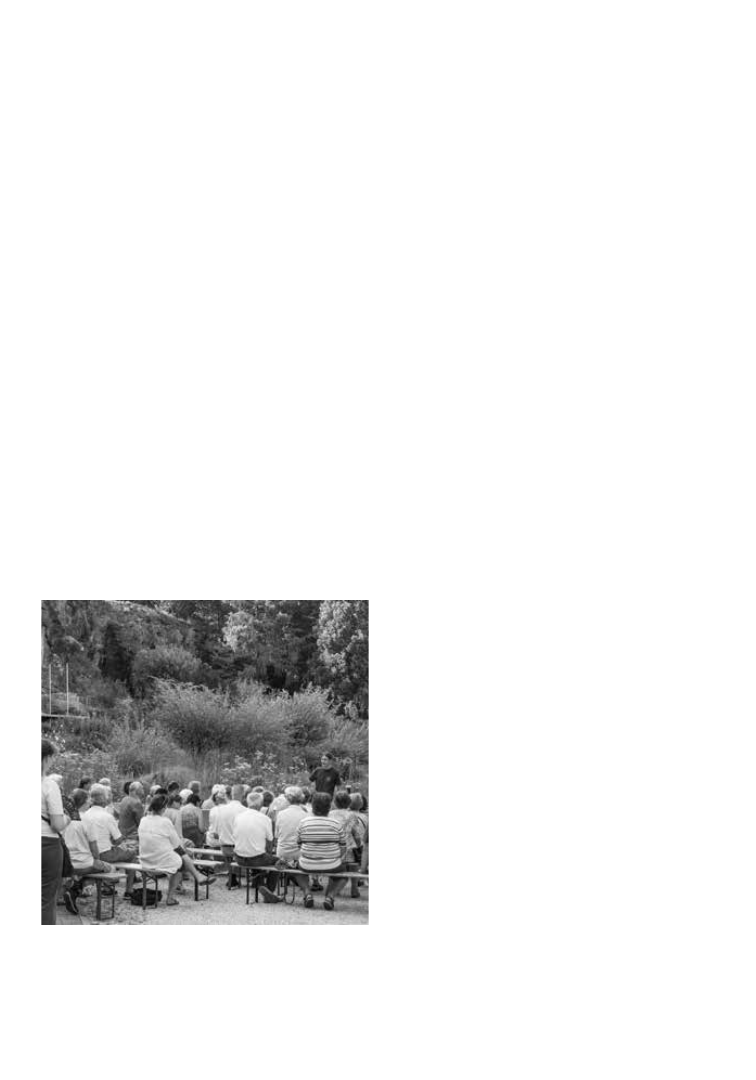
PSB 64 (3) 2018
149
external universities and publishing the
botanical journal Wulfenia (with a Journal
Impact Factor of 1.171) turned out to be a very
helpful working tool. In several cases, it led
to reduction of external pressure to close the
botanical garden, which allowed increasing
the quality of collections and infrastructure
during that time (Eberwein, 2004).
Motivated by this success, we started a
special lecture series in the botanical garden
in summer 2004. This series is a bit unusual,
because we have no lecture room, no protection
against bad weather, and no educational
infrastructure except a flip-chart and of
course many plants and ideas (Figure 1). Our
demands on this series can be summarized
as: steadily bringing botanical knowledge to
the public without fee in an attractive garden
in all weathers, imparting topics of current
interest as well as unknown and unexpected
fields of botany and ethnobotany, giving vivid
talks without computers (see Link-Pérez et al.,
2017) and never repeating a talk or topic. Up
to now, we have given more than 260 different
talks, and the number of listeners per talk
increased from 10 to 20 to sometimes more
than 80.
The Botanical Advocacy Leadership Grant is
a remarkable tribute to all who contributed to
the success of the talks. And it allowed us to
replace a very old and defective video camera
that was used in combination with a TV for
educational purposes until about six years
ago. We decided to buy a modern camera
that can be used without any computer. The
camera is directly connected to a screen via
HDMI, and only a second cable for power
supply is needed. Technical equipment should
not become the focus of attention, and a talk
should never be restricted by operation of
gadgets. We added an adapter to the camera
(c-mount), which allows using lenses of
SLR-cameras. Lenses with manual aperture
and a broad manual focusing ring work fine.
Aperture is preselected to f/5.6 - f/11 in order
to have a broader range of sharpness without
using additional light as well as working
distance (depending on magnification). Small
parts of plants (e.g., flowers, parts of flowers
or small seeds and fruits) can easily be placed
below the lens with minimal focusing and
without completely losing eye contact with
the listeners. Passing small objects through
the audience during a talk turned out to be
counterproductive, because objects reach
back rows much too late and listeners have
no connection between object and the topic
anymore. Showing small objects via camera
and TV during the talk with direct context
to the speech is a very fine solution. Use
of camera and TV is limited by contrast
and reflections of the screen, lighting of the
object and, in our case, by rainy weather. So, a
technical check of the equipment on location
Figure 1. Lecture about the genus Tagetes in
the Botanical Garden Klagenfurt, given by Felix
Schlatti, with 56 attendees. (Photo credit: Ro-
land K. Eberwein)
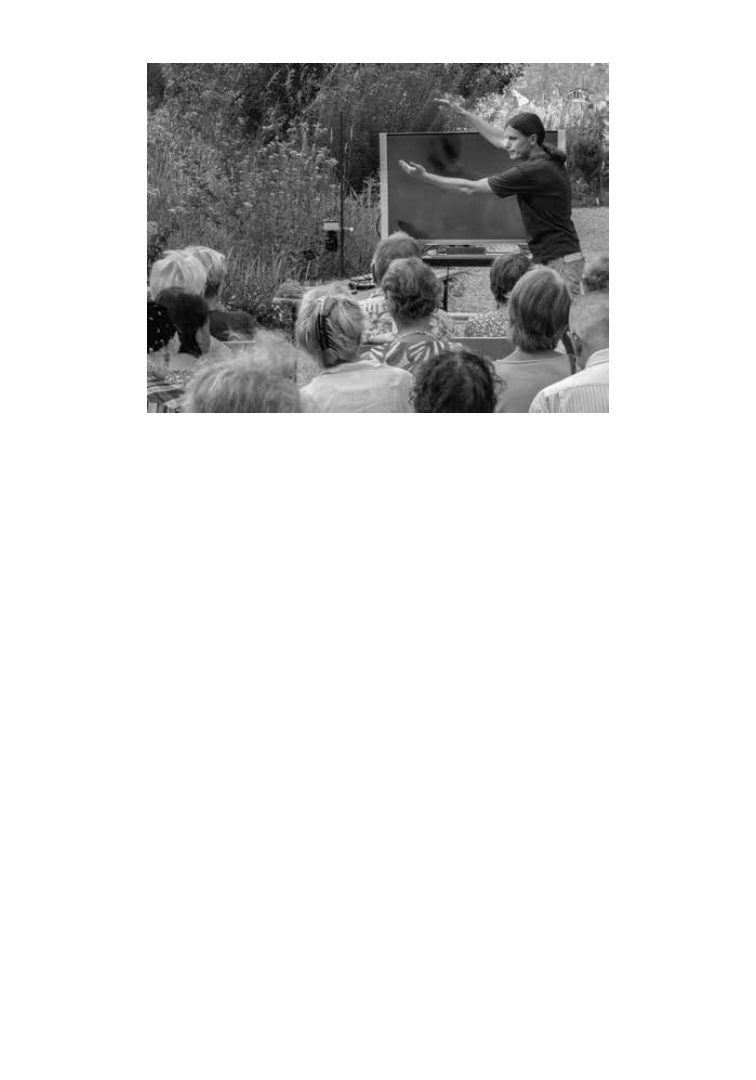
PSB 64 (3) 2018
150
prior to preparation of the lecture is strongly
recommended. Our audience enjoys the new
camera and has provided very nice feedback.
The Botanical Advocacy Leadership Grant
directed great attention of the press toward
the botanical garden, and a large report about
grant, camera, and lecture series excellently
promotes our activities and strengthens the
position of the Carinthian Botanic Center for
coming negotiations.
Literature Cited
Eberwein, R. K. 2004. Education in botanic gar-
dens? A case study of a “Potemkin’s Village” in
Carinthia (Austria). In: Novikov, V. S., D. N. Ka-
vtaradze, A. K. Timonin, V. V. Murashov, and A.
V. Sherabkov. [eds.]: Fundamental problems of
botany and botanical educations: Problems and
perspectives. Abstracts of International Scientif-
ic Conference on 200-anniversary of the Dept. of
Higher Plants of MSU (Moscow, 26-30 January
2004): 154-155. KMK Scientific Press Ltd, Mos-
cow.
Eberwein, R. K. 2011. A closed book? The botan-
ical garden in Klagenfurt is a museum. Museum
Aktuell 180: 14-17. [In German]
International Council of Museums (ICOM). https://
icom.museum/en/activities/standards-guidelines/
museum-definition/ [Accessed: 2018-08-13]
Link-Pérez, M., R. Povilus, and J. McDaniel.
2017. Cutting the cord: tips for computer-free
presentation skills. Plant Science Bulletin 63(3):
158-164.
Figure 2. Felix Schlatti uses the new video camera to demonstrate the shape of ligulate flowers.
(Photo credit: Roland K. Eberwein)

PSB 64 (3) 2018
151
This summer, the Botanical Society of
America established a new section devoted to
the professional development of faculty, and
future faculty, at higher education institutions
that fit the NSF Research at Undergrad
Institutions (RUI) criteria*. Examples of
such institutions include liberal arts colleges,
community colleges, and universities with
Master’s students and few PhD students.
Primarily Undergraduate Institutions (PUIs)
share unique opportunities and challenges.
Professors at PUIs give students invaluable
research experience in the classroom and
research labs and prepare them for further
degrees and/or professions. Some PUIs also
have extraordinarily diverse student bodies
where early exposure to hands-on research
experience can be particularly influential.
Such faculty also face distinct challenges. We
balance significant teaching responsibilities
while maintaining active research programs
predominantly with undergraduate
researchers who have diverse interests and
backgrounds. We may be the only person
within a general biology department who
studies and teaches about plants. Within our
institutions, communicating about the value
of botany, and how it fits into a broader biology
or liberal arts curriculum, may take special
effort. Networks outside of our institutions are
crucial.
We estimate that a majority of institutions
represented in the BSA are PUIs, and we have
received a feedback from many colleagues that
establishing such a network of botanists across
our institutions would benefit many.
At BOTANY 2018, the steering committee
led a well-attended and productive half-day
workshop focusing on the PUI job application
process. Our panel represented a diversity of
PUI institutions. We discussed the nature of
our jobs, our institutions, our students, and
what it is like to apply for and successfully
negotiate a faculty position. The 14 participants
included current PUI faculty, people on the
job market, postdocs, and students at PUIs.
An additional 24 people attended an informal
reception near the end of the workshop for
a discussion on broader goals and future
professional development opportunities of the
PUI Plant Network. Attendees were uniformly
enthusiastic about establishing a permanent
forum to share resources, develop further
workshops, and establish mentor relationships
between folks at similar stages of their careers
and across those stages.
We’ve created a section that will maintain and
expand a primarily online professional network
throughout the year. The PUI Plant Network
BSA section is an appropriate mechanism
to establish a sustainable PUI group, and we
expect that it will grow rapidly due to the high
number of PUI faculty members of BSA.
Primarily Undergraduate
Institution (PUI) Plant Network:
The BSA’s Newest Section
By Maggie Hanes (Eastern Michigan
University) and Rachel S. Jabaily
(Colorado College)

PSB 64 (3) 2018
152
Moving forward
We plan to host a workshop at the BOTANY
conferences annually, with rotating topics.
Future ideas include: (1) conducting research
and publishing with undergraduates, (2) a
field trip with considerations and tips for
leading class field trips from the pros, (3)
best practices for R1 PIs for preparing your
students and post-docs for careers at PUIs,
and (4) getting funded at a PUI.
We will hold an annual business meeting
at BOTANY conferences to promote
involvement, propose ideas, review issues,
and select leadership. The steering committee
currently includes: Rachel Jabaily (Colorado
College), Maggie Hanes (Eastern Michigan
University), Chris Martine (Bucknell
University), Mike Moore (Oberlin College),
and Mackenzie Taylor (Creighton University).
Membership in the section
is inclusive.
We welcome past, current, and future
faculty and students at PUIs and anyone else
interested in professional development at
PUIs. (A nominal fee of $5 has been set.)
We emphasize that we view the PUI Plant
Network Section as separate from the
Teaching Section because the PUI Plant
Network Section has a focus on professional
issues at PUIs that range far beyond teaching,
and because issues in teaching may apply to
all types of institutions. We look forward
to working with the Teaching Section and
occasionally hosting joint workshops.
For more information, please contact a
member of the steering committee. Also,
please use the hashtag #PUIPlantNetwork in
your social media.
*NSF PUI designation are accredited colleges
and universities, including two year community
colleges, that award Associate’s degrees,
Bachelor’s degrees, and/or Master’s degrees in
NSF supported fields, but have awarded 20 or
fewer PhDs in all NSF supported fields during
the combined previous two academic years.
Figure 1.
The PUI Plant Network reception from BOTANY 2018.

PSB 64 (3) 2018
153
Your social media accounts… hijacked. Your
friends… hit with a barrage of spam. Your
PC… held for ransom. Your money…. gone.
Yep, it’s 2018 and it’s well past time to take
seriously the threats out there on the internet.
It seems that over the last few years, as the
internet and other connected technologies
become more sophisticated and we depend on
them even more, there are more and greater
threats to our data safety than ever. Some of
these have hit quite close to home, impacting
the officers and sectional leaders of the
Botanical Society of America. We would like
to remind all of our members of what to look
for and basic steps to take to protect yourself
from those out there who seek to do us harm.
The basic problem is that there is a lot of
money to be made doing nefarious things
on the internet. Bad actors get big bucks to
spread spam about cheap Ray Bans, take
control of your computers and only release
them for a ransom, or to gain access to your
money through insecure or stolen login
accounts. Here are some examples of the main
approaches they take to do this.
By Rob Brandt
Information and
Technology Director-
Botanical Society of
America
rbrandt@botany.org
Protecting Your Online Presence
Helpful Hints from the BSA’s
Information & Technology Director
Account Hacking
The goal is to find out what your passwords are
to your website accounts. Once they have even
one of your accounts, they will attempt to find
other places where that account information
is used, such as banks, investment companies,
PayPal, Facebook, etc., because many people
use the same login information on many
different websites. They can use a variety of
methods to do this: “dictionary” attacks, where
they try and login at a site they know you use,
using all words in a dictionary or other source
until they find one that works. Or they’ll look
you up on Facebook to learn about you, and
use your pet’s name, your hometown, your
spouse’s name or other information to guess
your password or the security questions
that will allow them to reset your password
themselves.
Phishing
Phishing is when the bad actors try to get
someone—anyone—to respond to a message
that will allow them to get your login
information, credit card numbers, social
security number, etc. They aren’t targeting
you personally, but once they have your
personal information they will do bad things
with it. An example would be a “tech support”
message from Microsoft, Apple, Bank of
America, the IRS, etc. that prompts recipients
to click on a link. The page it takes them to
looks exactly like the real site it pretends to
be, and they are prompted to log in or make

PSB 64 (3) 2018
154
President, and Lucinda the Treasurer. All
this information is publicly available on the
BSA “current officers” website. The phisher
used the e-mail addresses listed on that page.
What’s even more impressive is that this
e-mail is signed by “Andi”, and it’s not evident
on our page that Andrea uses that nickname.
They apparently did other research elsewhere
to find that—perhaps her social media
accounts. It’s important to recognize that no
data breach enabled this attack; it’s all public,
benign information. But it’s put together in a
way that would be totally believable if it were
a normal thing for Andrea to ask Lucinda for
a transfer of funds. (It’s not.) This was a very
clever attack. “Spear phishing” is called that
because it’s very similar to actual spear fishing,
in which the fisher dives, spots a particular
fish, and targets it.
Protecting Ourselves from
Attacks
So how do we protect ourselves from these
attempts to do us harm? Short of unplugging
from the internet, there are a few basic things
we can do to make it difficult for bad actors to
succeed.
Passwords
Use safe passwords, change them fairly often,
and don’t use anything that can be found in
a dictionary or other information about you
online. Obviously don’t use “password” or
“123456” or other silly things. If you do, know
that you are already hacked. Many websites
require you to have a secure password using
certain rules, but by far the most important
thing you can do is to use a pass phrase, not
a pass word. String together a short sentence
that will be easy to remember, and yes, include
a payment. Once you do that, the bad guys
have your information and/or your money. It’s
called “phishing” because it is very much like
real fishing; you put some bait on a hook and
cast it into the water, hoping a fish will bite.
When they bite, you’ve caught your fish.
Spear Phishing
Spear phishing is very much like regular
phishing, except the phisher has his/her eye
on you specifically and are setting bait that
will appeal to you specifically. It takes a great
deal more effort for them to do this, but the
payoff is far higher if it works. I will use an
incident we recently encountered at the BSA
as an example:
From: Patsy Yates <winstonrose00@gmail.com>
Date: Wed, Sep 19, 2018 at 4:00 AM
Subject: Urgent Transaction
To: lmcdade@rsabg.org
Hello Lucinda
Can we make an urgent Transfer of $5,600
today ? So I will forward you the vendor
details for payment. Thanks
Best Regards
Andi Wolfe
This message sent to Lucinda McDade (BSA
Treasurer) purported to be from Andrea Wolfe
(BSA President) asks to transfer $5,600 “today”.
(Lucinda recognized that it was suspicious
immediately and alerted us.) There are a
few items in this e-mail that are impressive,
showing the research the phisher did to make
it appear to be an authentic request. There’s
a genuine relationship between Lucinda and
Andrea, in that they are both on the Board of
the Botanical Society of America. It seems
reasonable that Andrea would request funds
from Lucinda because Andrea is the current

PSB 64 (3) 2018
155
a few odd characters just to make it extra
difficult to guess. You should also update
your passwords from time to time, because
you may not know your password has been
compromised until much later.
Password Managers
Use an encrypted password manager to keep
track of your passwords. Don’t just save
them to a simple file on your computer or
smartphone, because if hackers gain access
to your device, they will then have all your
passwords. One of the first things a hacker
will do on a newly hacked device is search
it for “password” to find everything stored
there. Password Managers are designed to
keep them safe. The data are stored in an
encrypted database, and can only be accessed
if you have a password. Use a different
password on the password manager than the
one you use for the device, so that the hacker
will need to know TWO passwords to get at
your other passwords. There are numerous
password managers available, but one good
one available for many devices, and is free,
is KeePass (https://keepass.info/download.
html). The database format is universal, so
you can keep your password database on all
your devices.
Single Sign-on
Many websites allow you to sign on with an
account from another service. For example
you can sign on with your Facebook, Twitter,
Gmail or Amazon account. There are some
downsides to doing this, but the one huge
advantage is that the site you are using
your Facebook account on does not get your
password. The least trustworthy sites are
the ones from small operators who cannot
afford full-time security specialists. Those
are the sites that get breached the most. It’s
a really good thing if they never even see
your password. The downside of this is that
Facebook and others can then share other less
critical information with the site, such as your
e-mail address, list of friends, etc. When you
first create a new account using your existing
Facebook or other account, you should be
notified of what is being shared; note it and
consider whether it’s an acceptable tradeoff
for you.
Use Plain Text E-mail
We all like nicely formatted e-mail. Hackers
like it even more, because it allows them to
obscure what they are doing, making it more
likely that you will click on some variety of
phishing attack. The previous example of the
spear phishing attack is a perfect example.
Everything looks legitimate except for the
“from” line at the top. The message purported
to be from Andrea Wolfe, but the “from” said:
“From: Patsy Yates <winstonrose00@gmail.
com>.“ In this article, that’s plainly obvious.
But most people pay more attention to the
content of a message than who it’s “from.”
The phisher could have taken an extra step of
changing the “from” to:“From: Andrea Wolfe
<winstonrose00@gmail.com>“ and it would
have been harder for Lucinda to see who it
really was from.
Links in the text are similar. A plain text
e-mail to a phishing site might display a link
such as https://wellsfargo.asldkjalfjhlaksdjf.ru,
whereas a nicely formatted e-mail will simply
show “Wells Fargo”, and you can only see the
URL it points to by hovering your mouse over
it, or (yikes) clicking on it. And once you click
on it, and it looks like a Wells Fargo page, are
you going to look at the URL to make sure

PSB 64 (3) 2018
156
that’s really where you are? Probably not.
As a bonus, recent studies have shown
that plain text e-mails get read more often
than formatted ones. I believe the reason is
that formatted e-mails look too much like
newsletters, and no one reads newsletters
(right?). So there’s additional reason to just
keep it plain. Just say “no” to html e-mail.
Just pay attention!
Be aware that the internet is not a safe place,
and keep your mind engaged when you are
browsing the web or reading your e-mail. The
e-mail to Lucinda failed because it was an odd
request, and she knew it. Think about whether
you were expecting to receive requests for
information, or tasks to perform. Don’t
download files just because someone asks you
to. There’s no shame in verifying that it really
came from whom it claims to be from. Look
at URLs that links send you to, and look at the
“from” on e-mails to be sure they make sense.
The internet can be a dangerous place, just like
anywhere else in the world. But you don’t have
to get hurt if you do the basics to keep yourself
safe. Understand where the dangers are and
what they want to do, keep your sensitive
information safe, use good security measures,
and above all pay attention.

PSB 64 (3) 2018
157
Science and Civic
Participation
Before becoming scientists, we were citizens
of somewhere. As such, we have a basic
civic responsibility to make an informed
vote in our registered locale. What we
may forget in our busy professional lives
is that this is our basic responsibility to ensure
our democratic institutions continue to
operate. As scientists, we can easily overlook
additional civic duties we have earned by
developing our expertise: educating and
engaging with those trying to understand
science-related policy issues, evaluating
policy positions on their empirical merits,
and holding our elected leaders accountable.
The challenges of the 21st century require scientific
solutions, evidence-based decision-making, and
greater civic engagement by scientists. Many of
us are now more inspired than ever to become
involved in our democracy. However, the
multitude of options can be overwhelming,
resulting in inaction. Here, we provide a
framework for participating in civic life as a
scientist in ways that can effect real change.
By Ingrid Jordon-Thaden (University of California Berkeley),
ASPT EPPC Chair, Krissa Skogen (Chicago Botanic Garden),
and Kal Tuominen (Metropolitan State University), BSA PPC
Co-Chairs
Commit to a Satisfying
Connection
Determine the amount of time you can commit
and the type of engagement that is compelling
to you. Then push yourself outside of your
comfort zone, just as you do in other areas of
your life. You will be more effective if you are
realistic about your strengths, interests, and
what you can commit. Few of us will spend
a career in science policy, but most of us can
create time to speak or volunteer at a one-day
event. All efforts are important, no matter
how small!
Evaluate and Hold
Accountable
Scientists with policy experience seem to
share a common refrain: most policymakers
value scientific input, but they don’t always
remember to create a seat at the table for
those who can provide it. Evaluating elected
officials and candidates for office on their
willingness to reserve a seat for us is a deeper
way scientists can support civil society.
Do you know where
candidates in your district
stand on science issues? How
have incumbents voted in
the past? For the midterm
elections, American Institute
of Biological Sciences (AIBS)
has teamed up with 11 other
science-related organizations
to create the Science Debate
2018 questionnaire. Whether
and how candidates respond
Public Policy News

PSB 64 (3) 2018
158
can help us evaluate candidates’ ability to
lead. View candidates’ responses at https://
sciencedebate.org/sciencedebate-index.html.
Don’t see your candidate’s answers? Send an
e-mail encouraging him or her to respond!
Another way to hold candidates accountable
is to attend a town hall or debate and ask
questions about their views on science-related
issues. Questions might relate to government
funding for science, climate change, public
lands, food security, natural disaster
preparedness, or other issues. The goal is to
get candidates to state their positions on the
record.
Educate and Engage
Politics can muddy the waters on scientific
issues for the general public, even when the
weight of evidence is clear to us. Election season
is a great time to educate voters about scientific
consensus and its connection to policy. We can
also educate each other: share what you learn
about candidate positions and voting records with
your peers to help them make an informed vote!
Finally, consider helping a science-savvy candidate
get out the vote. Campaigns need the most
volunteers in the week before the election. Voter
engagement involves calling and knocking on the
doors of likely supporters. Speaking with undecided
voters in a close election can help determine the
outcome! You can practice your pitch during a
brief volunteer training: “As a scientist, I value using
evidence to make policy decisions that impact the
lives of all Americans. [Candidate X] has a track
record of supporting science and using knowledge
and sound reasoning in policy decisions. For
these reasons, I feel they are a strong candidate
for office and encourage you to vote for them
on November 6.”
If all of that seems too easy, we have one last
question: have you considered running for
office in 2020?

PSB 64 (3) 2018
159
Just about 2 1/2 weeks before the start of
our annual conference this year, staff at
the Botanical Society of America received
word—via Twitter—that at least two of our
members were denied U.S. visas and were
unable to attend our BOTANY 2018 meeting
in Rochester, MN. The conference is a unique
and welcoming venue where botanists share
current research, develop collaborations,
establish and strengthen networks, and
generally enjoy the camaraderie of the plant
science community. We knew the travel ban
would affect the scientific community, but
until we saw their tweets, we did not know how
many plant scientists would miss our meeting.
As soon as we learned of their plights, we leapt
into action to figure out how we could help
them to participate.
As with many professional conferences at
two weeks out, the sessions’ agendas had
already been carefully arranged, which made
the creation of a separate “remote presenter”
session unlikely. However, we knew we could
and should allow our missing attendees to
present their work remotely; we just needed
to work out the details. The BSA does have
How the BSA Helped Members
Affected by the the U.S. Travel
Ban at BOTANY 2018
a Zoom Video Communications account,
which has been consistently reliable and
effective for remote meetings and training
webinars for our organization. Therefore
we were confident we could pull in our two
international participants—one in Canada,
whose Ph.D. was completed on the west coast
of the United States, and one in Denmark,
who was slated to present work completed at
the Smithsonian in Washington, D.C.—via
Zoom.
Preparation
To get started, we needed to make sure that
our remote presenters felt comfortable with
Zoom. We knew that the transition from local
to remote presenter and back again could be
tricky, especially with the tight timetable for
each session. In light of this, one week prior
to their sessions and three days before the
start of the conference, we held a practice ses-
sion with both scientists to allow them time
to practice using the Zoom platform - finding
and adjusting the video and audio controls,
sharing their screens, etc. Each presentation
looked good and worked smoothly during the
practice sessions, and each presenter noted
and set the proper microphone and camera
settings for the real deal.
Once the BSA staff were at the Mayo Clinic
Civic Center, in Rochester, MN, we set up
practice Zoom meetings to establish the
appropriate settings on the computers to be
used in each room. The one caveat, we knew,
would be the internet connection, because
By Jodi Creasap Gee, PhD
BSA Education Technology
Coordinator
E-mail:
JCreasapGee@botany.org

PSB 64 (3) 2018
160
we were using Wifi and not the hardwired
connection. There was a very real chance that
the remote presentations would hit a snag
with an internet connection that could be
laggy due to excessive use. After our on-site
practice run looked good, we felt ready to roll
with the presentations.
Delivery
The reality of the situation was that we needed
to use the hard-wired internet connection
in the session rooms to guarantee that there
would be no interruptions to the remote
presentations, which is what happened with
the first presenter. Her audio became garbled,
and the slides were pixelated. We quickly
overcame the issue by tethering the room
computer to a phone’s hotspot for the duration
of the 15-minute presentation. The second
presentation went a little more smoothly, and
we immediately starting making notes on
what to do in 2019, in case we need to address
this issue in the future.
Outlook
Several of us have brainstormed about options
and possibilities for subsequent meetings,
and we are determined to be prepared for the
possibility of remote presentations. While
our ultimate goal is to develop a protocol for
remote presenters denied U.S. visas, we do
have a few ideas of what we can do better next
year.
First and foremost, remote presenters need
more practice ahead of time. This means they
should run through their presentations at least
once prior to the actual session time. Because
our scientific program contains 15-minute
talks, we need to improve our efficiency in
this capacity to ensure that presenters are
comfortable with the platform and can use it
with great ease.
Due to the transition time from local to remote
and vice versa, remote presenters should be
scheduled at the beginning or the end of the
session.
This one seems like a no-brainer, but
establishing a signal to give the presenter a 5-,
3-, and 1-minute warning is critical. No one
likes to cut anyone off, and it feels especially
rude when the person being cut off isn’t even
in the room. Surprisingly, in our case, the
chat box of the Zoom platform was not quite
enough to get the presenter’s attention.
Most importantly, we need to accept that
the U.S. travel ban will affect the foreseeable
future of scientific congress in the United
States, and we need to be diligent in keeping
our international colleagues in the scientific
community. The Botanical Society of America
is taking on this challenge, and we hope
that our fellow botanists know that we have
not abandoned them or their efforts and
collaborations.
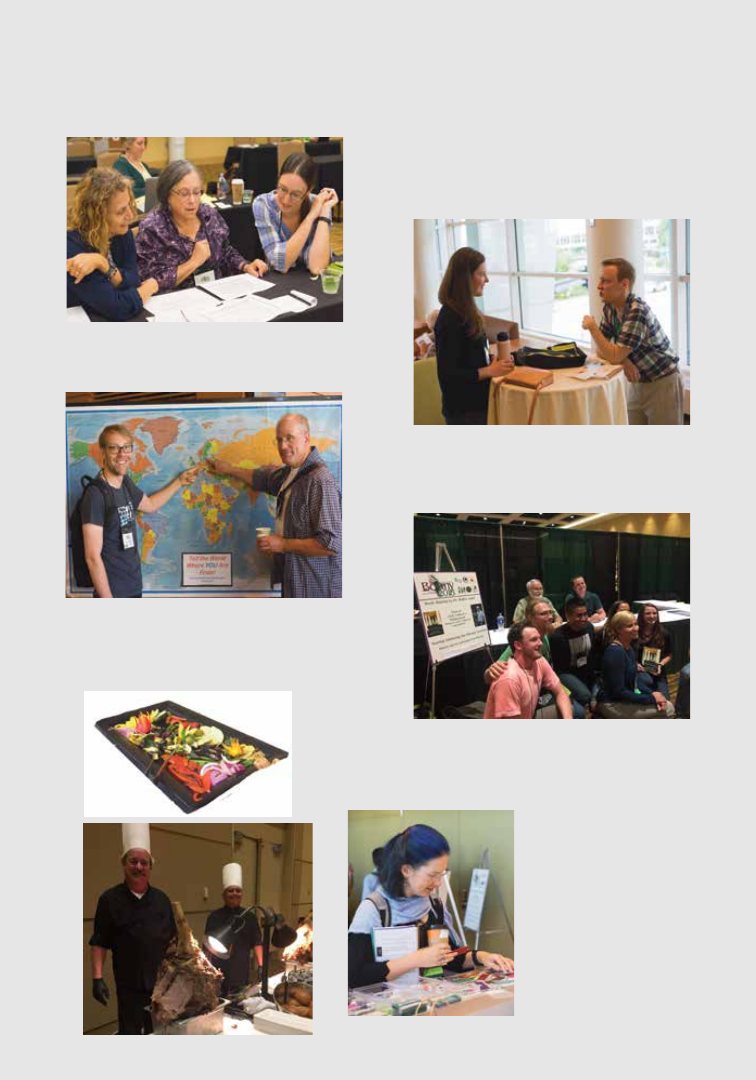
PSB 64 (3) 2018
161
Botany 2018 - in your words.....
comments from the post-conference survey!
Fantastic meeting this year. the
energy was phenomenal
Another great conference with a lot
of interesting talks.
Great! This year's food (breakfast, snacks,
opening/closing reception) was A+
Botany is my fav conference.
Everyone is so nice
and supportive
I thought that over-
all this was one of
the better
Botany conferences
that I have attended.
Being around all the "plant people" at
Botany is so much fun!
I always enjoy this meeting
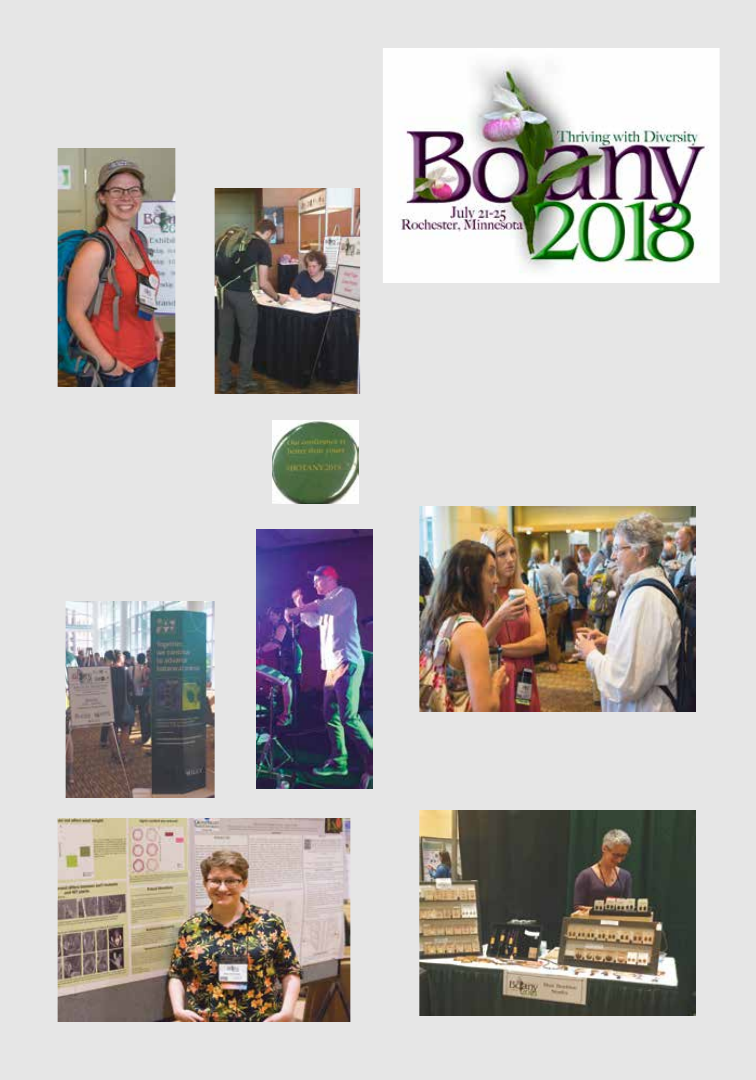
PSB 64 (3) 2018
162
Botany 2018 was my first con-
ference and I absolutely loved
it. Everything was very orga-
nized, there was a lot of diversi-
ty within the presentations, and
there were lots of social
and networking opportunities.
I thought the diversity of
science was great.
I love the atmosphere of
this conference.
Everybody is friendly
and it is a nice and in-
spiring environment.
I am looking forward
for the next one
Botany conferences have the most
friendly people, I really enjoy
attending these conferences.
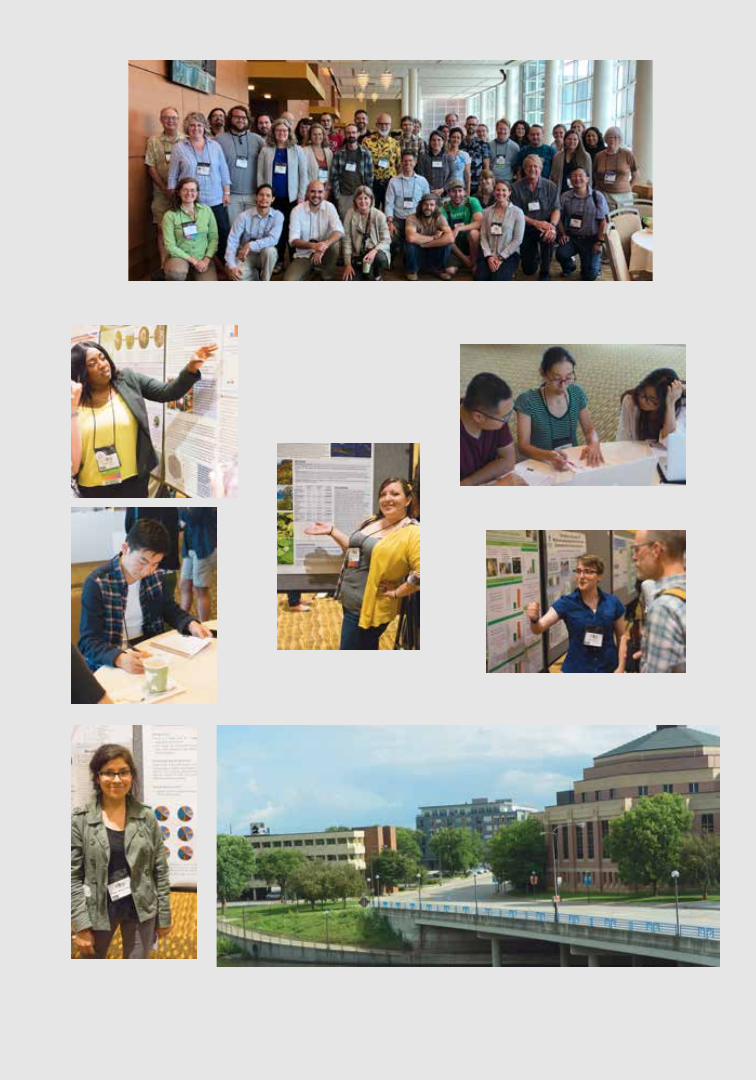
PSB 64 (3) 2018
163
California Botanists gather for breakfast!
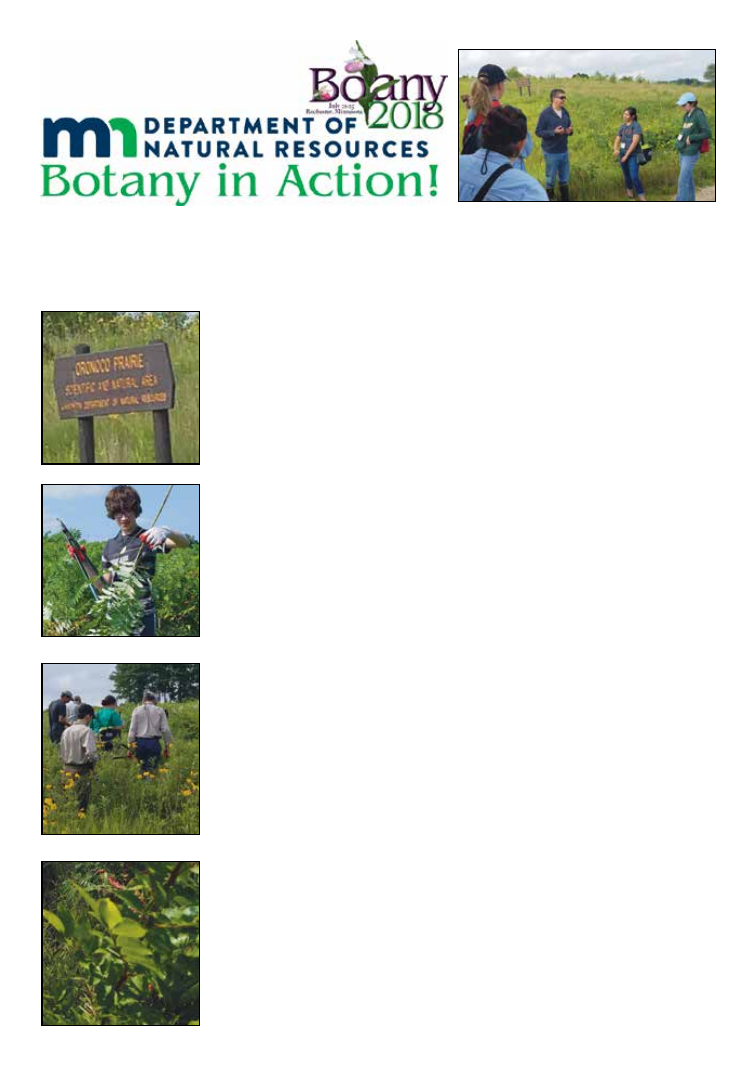
PSB 64 (3) 2018
164
For the past several years, the conference has participated in a volunteer project to give back to
our host city. On Sunday of the conference a number of dedicated souls board a bus and go off
to do some good! They get a commemorative t-shirt, a lunch, a water bottle, and a feeling of
being a do-gooder! Here is an account of this year's project!
Volunteering for the Botany In Action outing this summer started
with a 20-minute bus ride from the conference center to a protected
area that the Minnesota Department of Natural Resources is
restoring to something resembling its appearance and composition
before the arrival of Messrs P. Bunyan, J. Appleseed, and J. Deere.
Two state conservationists met us there and gave us a short talk
on the history of the vegetation of the area and on the techniques
that Minnesota is using to foster the native flora. The area in
front of us, one of low hills and ridges formerly partly forested
and partly more open and shrub-dominated, had not received the
undivided attention of the three gentlemen named above, but had
nevertheless been significantly altered over the last two centuries.
Our job was to remove as many individuals of sumac (Rhus glabra L.)
as we could from one of the hillsides. As the conservation officials
explained to us, sumac, although a native species, has become
invasive in some more-or-less intact ecological zones, crowding
out other native species restricted to these zones. We were given
gloves and provided with sturdy loppers, long-handled cutters
that easily slice through any stem less than 2 inches diameter,
and then spaced ourselves a few yards apart at the base of the
shrub-and-grass-covered hill and started hunting for 1- to 4-foot
tall shrubs with compound leaves and glaucous lower surfaces.
It was a hot day, but everyone worked at his/her own pace, and by
noon we had nearly reached the top of the hill, leaving behind us
hundreds of prone, silver-green victims. At that point we went
downhill to the stack of lunchboxes, the bus back to town, and to the
DNR’s assurances that we’d made a real contribution to the labor-
intensive work of suppressing the invasive sumac.
-
Gordon
McPherson
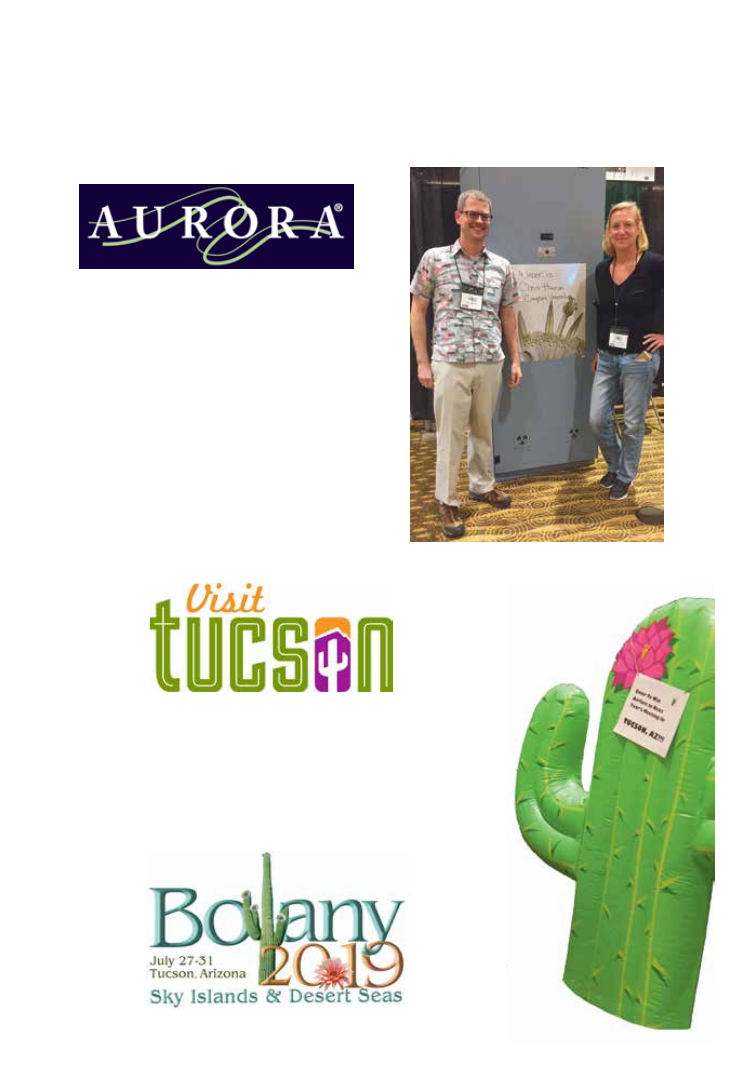
PSB 64 (3) 2018
165
And the winner is.....
With many thanks to Aurora Storage,
Chris Havron of Campbell University
was the winner of the
Herbarium Cabinet raffle at Botany 2018
Visit Tucson raffled off free airfare to the
Botany 2019 conference.
Martin Kalfatovic of the Smithsonian is the winner!
See you all in Tucson!

166
Harvard University Bullard Fellowships in Forest Research
Annually Harvard University awards a limited number of Bullard Fellowships to individuals in
biological, social, physical and political sciences, and the arts to promote advanced study or the
integration of subjects pertaining to forested ecosystems. The program seeks to allow mid-career
individuals to develop their own scientific and professional growth by utilizing the resources
and interacting with personnel in any department within Harvard University. In recent years
Bullard Fellows have been associated with the Harvard Forest, Department of Organismic and
Evolutionary Biology, and the J. F. Kennedy School of Government and have worked in areas of
ecology, forest management, policy, and conservation. Stipends up to $60,000 are available for
periods ranging from six months to one year and are not intended for travel, graduate students,
or recent post-doctoral candidates. Applications from international scientists, women, and
minorities are encouraged. Additional information is available on the Harvard Forest website
at http://harvardforest.fas.harvard.edu. Annual deadline for applications is January 15.
ANNOUNCEMENTS
FROM THE
PSB
ARCHIVES
60 years ago: BSA publications have always been an important venue for sharing methodology. In 1958,
F.W. Went describes the Mobile Desert Laboratory as a tool for studying the biology of desert plants. Today this
article might appear in Applications in Plant Sciences.
“During the last fifteen years I had been studying problems concerning desert plants. I found that their
germination occurred only under very special conditions which did not prevail every year and very often did
not occur in the same locality more than once every five to ten years. . .
To overcome the problems of a fixed location, a mobile desert laboratory was designed, partly on the basis
of the car park of the Land Research and Regional Surveys Division of the Commonwealth Scientific and Indus-
trial Research Organization in Australia and partly on the truck-based ecological laboratories which had been
surveying the Sahara desert. Through the generosity of Mrs. Pearl McManus of Palm Springs these plans could
be realized and in the autumn of 1956 the first trial runs were made. In the intervening 2 years the laboratory
has proven its effectiveness and now a short description of its facilities can be given. -Went, F.W. “A Mobile
Desert Laboratory “ PSB 4(6): 1-3
50 years ago: The Pelton Award in Experimental Plant Morphology was established. “The Conservation
and Research Foundation has established the Jeanette Siron Pelton Award in Experimental Plant Morphology.
This award, honoring the memory of Jeanette Siron Pelton, will consist of a $1,000 premium to be given not
more often than annually to a person selected for his sustained and imaginative productivity in the field of
experimental plant morphology. The field may be broadly defined to include the subcellular, cellular and or-
ganismal levels of complexity. The award will not be restricted as to sex, nationality or society affiliation of the
recipient, nor as to the language in which his work is published. -PSB 14(4): 4
[Note: The Editor believes that the use of only the masculine pronoun in a sentence directly stating that the
award will not be restricted as to sex highlights the need for the careful use of gender-neutral language.]

167
T
he publication process can be especial-
ly daunting for new authors who must
navigate the intricate submission steps and
the “mystery” of peer-review. Early career
authors are also under substantial pressure to
publish to develop their professional portfolio.
Is there anything that new authors can do to
maximize the chance that their article will be
accepted? The answer is, “Yes!” The following
tips and suggestions are based on a workshop
held by a panel of editors and reviewers at the
BOTANY 2018 meeting in Rochester, Minne-
sota, on July 22, 2018.
The Editorial Perspective
In order for your manuscript to be accepted
and published, you, the author, must first
understand what editors are looking for.
Because more manuscripts are submitted to
How to Publish Your Research:
Tips for Junior Researchers
journals than can be published, editors have
to carefully discriminate among submitted
manuscripts to identify those of high quality
that also match the scope and audience of
the journal. Understanding what editors are
looking for will greatly increase your chances
of having your manuscript selected for peer
review and possibly publication.
Upon receiving a manuscript, an editor
immediately asks two questions. Your goal is
to convince the editor that the answer to these
two questions is yes.
1. Is the paper appropriate for the journal?
• As an author, you need to do your background
research on the journal to make sure it is a good
match for your manuscript.
• Know your target journal: Does your manu-
script align with its aims and scope?
Written with assistance and input from Pamela K. Diggle, Amy McPherson, Beth Parada,
Richard Hund, Loren H. Rieseberg, J. Chris Pires, Stacey D. Smith, and William E. Friedman
SPECIAL FEATURES
By Theresa Culley
Department of Biological Sciences, University of
Cincinnati, 614 Rieveschl Hall, Cincinnati, OH
45221-0006
E-mail: theresa.culley@uc.edu, Tel: 513-556-9705

PSB 64 (3) 2018
168
• What types of papers have already been pub-
lished there? Are they similar to yours?
• How are existing papers framed? What is the
context of their work?
• Who is the audience of your paper? Is this jour-
nal one where your work would be read and
cited?
• Look at the editorial board; is there a
member with the necessary expertise to
handle your paper?
2. Should the manuscript go out for review?
To answer this question, the editor will look at
the Title, Abstract, and Cover Letter.
• The title should be succinct and descriptive (ap-
proximately 16 or so words).
• The abstract must justify the study and explain
why it is needed and interesting; often this is the
only text that the editor will review (and not the
entire manuscript).
• Is the abstract, and the paper itself, in compre-
hensible English? Is it evident that the author
has worked hard to polish the writing?
• The cover letter is critical to communicate the
importance of the study to the editor, who may
not have expertise in your particular field of
study. Its purpose is to (1) tell the editor why
your paper is suitable for the journal, and (2) ex-
plain how the work advances the field. It should
not merely reiterate the abstract, but must an-
swer the following questions regarding your
manuscript:
What are the questions addressed or
hypotheses tested?
What is the major contribution of your
paper to your discipline?
How is this contribution of interest to
the readership of the journal?
Tips for the Editorial
Process
Based on our combined experiences of
over 160 years serving as editors, authors,
and reviewers for a variety of journals, we
developed the following tips to maximize the
possibility of acceptance of a manuscript in a
peer-reviewed scientific journal.
A. Pre-Publication
• Wait until you have generated a substantial
data set with a thorough analysis before submit-
ting to a high-impact journal. Although there
may be lots of pressure to publish, resist the urge
to publish several small, frivolous papers (some-
times known as “least publishable units”) just
to increase your publication rate. At the same
time, you do not need to include everything in a
single paper; reviewers will not want to read an
entire thesis with an abundance of supplemen-
tal tables. Instead, editors and reviewers want to
see a big “take-home” message condensed with-
in a cohesive, concise paper.
• Take ownership of your research and consider
how it will appeal to the general public, even
while you are still doing the study. If appropri-
ate, take video and photos and keep a detailed
journal of your research; this is especially valu-
able if your article will eventually be promoted
on social media.
B. Finding the Right Journal
• Submit to the right journal: Carefully review
the aims and scope of the journal, and look at
other examples of what has been recently pub-
lished. Is the journal the right “home” for your
paper? Will it reach your intended audience?
What is the average turnaround time? How is
the journal perceived in your field? You can
aim high for a specific journal, but always have

PSB 64 (3) 2018
169
a back-up plan of other journals to consider if
your manuscript is not sent for peer review or
not accepted at the journal of your first choice.
• If you are unsure if the journal is the right “fit”,
ask! Contact the editorial office with any ques-
tions about whether your manuscript is appro-
priate, providing a compelling argument of why
you think it is, and including at least the title and
abstract. The editors may be able to offer advice
for submitting a successful manuscript—or of-
fer suggestions for alternative outlets for your
work. This could save you time and trouble.
• Avoid predatory journals. In the search for an
ideal journal, be aware of and avoid for-profit,
online-only journals that promise rapid pub-
lication but have low quality. The purpose of
these journals is solely for their own financial
benefit, often charging either very low ($50-
$60 US) or very high ($2000-$5000) fees. In
addition, predatory journals typically advertise
rapid publication, but their peer review is often
a sham; such journals are not indexed in ma-
jor services such as Web of Science. Predatory
journals devalue science and can be detrimental
to individual professional advancement; hiring
and promotion committees are increasingly not
accepting articles in predatory journals. Simi-
larly, authors now need to think about whether
articles they cite are from these sham journals.
Predatory journals can be identified using
Beall’s List (https://beallslist.weebly.com) or Ca-
bell’s Blacklist (https://www2.cabells.com). Au-
thors can also identify predatory journals using
common red flags (see Culley, 2018). One ca-
veat is that some new journals (especially in de-
veloping countries) may be unfairly identified
as predatory, so you need to carefully research
your choice of a journal.
C. Preparing Your Paper for Submission
• Follow directions in the Instructions for Au-
thors for your chosen journal and prepare your
paper as carefully as possible, especially if there
are word limits, required formats to follow for
particular article types, or other requirements
(e.g., structured abstracts, minimum number of
key words, data accessibility statements, author
contribution paragraphs). Manuscripts may be
returned without review if there are too many
deviations from the author guidelines.
• Seek feedback from others. Make sure that
your paper has been thoroughly vetted by other
readers (such as fellow members of your labora-
tory) for content as well as for presentation. Ty-
pos, misspellings, and grammatical and punctu-
ation errors signal to editors and reviewers that
the paper is sloppy, and they may be disinclined
to rate it highly (or in some cases, may even re-
fuse to review it). A well-prepared and carefully
written paper will keep editors and reviewers
more favorably disposed toward your paper so
they can focus on the paper’s content; this can
speed up the review process.
• If you have any questions, contact the edito-
rial office. They are there to help you. The ed-
itorial staff works with all other individuals in
the process (reviewers, editors, readers, the pro-
duction team that will compose your article for
publication, etc.), and they are a good resource
for helping you succeed in the publication pro-
cess.
• Know your audience. In particular, write the
paper with your reviewers and readers already
in mind. What would you think if you were re-
viewing this paper? As a reader, what informa-
tion would you really like to know?
• Tell a good story to hook readers and persuade
them to read further. Make the paper interest-
ing to non-specialists in your field or those who
work with different taxa. This may require that
you think broadly beyond your own study sys-
tem. Write your paper in such a way that people
outside of your immediate area can appreciate
it and apply what they have learned to other

PSB 64 (3) 2018
170
systems. Address a consequential question in
plant biology, evolution, ecology, or conserva-
tion that is relevant beyond your study taxon.
This is where hard work on the introduction
and discussion, with strong literature referenc-
es, will pay off. How do your specific findings
illuminate a broader set of questions or ongoing
intellectual debates?
• Use the most up-to-date and appropriate an-
alytical procedures. Some papers may be re-
jected simply because the analysis is perceived
as not being as rigorous as it could have been.
Reviewers will expect you to justify your choices
of analytical methods and statistical tests, and
provide a detailed description of each. Be sure
to look at similar papers in your target journal
to see how the data were analyzed.
• Generate great figures! A carefully constructed
and effective figure can often communicate a
difficult concept or result more easily and con-
cisely than text. Figures make papers aestheti-
cally interesting and appealing to reviewers and
readers alike.
• Make sure your data are archived and public-
ly accessible. This is increasingly being required
by many peer-reviewed journals and serves to
advance your field (see Culley, 2017).
D. Submitting Your Paper
• Prepare your cover letter with care. If you
have never done this before, ask other research-
ers for examples of cover letters from their ac-
cepted papers, especially for the journal that you
are targeting. See above for more information.
• Suggest five appropriate reviewers and not
just the obvious ones in your references, if the
journal allows reviewer suggestions. This helps
the editor find reviewers in a timely manner to
speed the review process. Be sure that none of
your suggested reviewers have conflicts of inter-
est (e.g., a former or current mentor or advisor).
If you are unsure, do not hesitate to ask an editor.
• Look at the Associate Editors of the journal
and suggest someone who might be appro-
priate to handle for your paper—that also helps
facilitate the process.
• Once you have submitted your paper—con-
gratulations! Now the wait begins. Be patient,
but also do not be afraid to “check in” with the
editorial office if the review process seems to be
taking a long time.
E. After Peer Review
• After receiving your reviews, take a deep breath,
and wait at least a day before responding if they
are negative (and longer is probably better). In
some cases, you may understandably be upset,
but wait until you can consider the reviewers’
comments objectively. Immediate responses
in the heat of the moment do not generally fare
well with the editorial staff and the reviewers.
Once you have completed your revision, con-
struct a careful cover letter that provides a de-
tailed description of how you responded to each
point raised in the reviews. If you disagree with
a reviewer’s request or criticism and choose not
to make a change to the manuscript, carefully
explain your reasoning (see next bullet point).
Point-by-point responses, even when you do
not wish to make a change in an area, make the
evaluation of your revision more efficient.
• The reviewer is always right (even if they are not
actually right). If your paper was not accepted
but revisions are requested, look carefully at the
reviewer comments. If you disagree with any
comment, provide a constructive and polite
response; remember that the original reviewer
may be asked by the editor for his or her assess-
ment of your response. Even if you disagree
with a comment, try to understand what the
reviewer’s issue might be to determine what ef-
fort is needed (i.e., put yourself in the reviewer’s
shoes); make at least some effort to address it.
One effective response is to modify the text for

PSB 64 (3) 2018
171
clarity if there appears to have been some confu-
sion. Remember that the review process allows
you to benefit from the expertise of your review-
ers, who have typically invested significant time
and effort to help you publish the best possible
version of your research.
• Revise with the fewest number of changes. A
drastic change to one part on the manuscript
may inadvertently affect the flow and compre-
hension of the rest of the paper. Thus, always be
sure to read your paper from start to finish af-
ter you have completed your revisions to make
sure that everything still flows and makes sense.
Also, double-check tables and figures to make
sure they agree with the revised text.
F. Post Publication
• Put together a press package using information
you gathered earlier. This could include a lay-
man’s summary of your study, as well as suitable,
non-stock images and graphics. Journalists
often choose to write about papers because of
great pictures!
• Promote on social media. Don’t be afraid to
tweet an announcement about your new paper!
Ask the journal staff what they might do to also
help promote your article.
If you carefully follow these tips, you’ll soon
be on your way to a strong publication record.
Although the process of publishing your work
can be arduous, the combination of your
efforts along with the those of the reviewers
and the editors will ensure that the final article
is of high quality and high impact. Thus, our
overall message here is: Don’t Give Up. Even
if your paper is rejected from a journal, think
carefully and objectively about why, make
appropriate modifications, and submit to
another journal. Also, there is considerable
stochasticity in the review process, so
remember the old adage “Try, Try Again.” The
experience publishing your work will not only
build your skills as a communicator, but will
strengthen your science, which benefits the
entire community.
Literature Cited
Culley, T. 2017. The frontier of data discoverabil-
ity: Why we need to share our data. Applications
in Plant Sciences 5(10): 1700111. https://onlineli-
brary.wiley.com/doi/abs/10.3732/apps.1700111
Culley, T. 2018. How to Avoid Predatory Journals
When Publishing Your Work. Plant Science Bul-
letin 64(2): 96-111.
https://botany.org/file.php?file=SiteAssets/
publications/psb/issues/PSB-2018-64-2.pdf

PSB 64 (3) 2018
172
I
n A Short History of Botany in the United
States, Ewan designated the period from
1797 to 1818 as “the Barton Epoch.” This was
primarily for his botanical textbook, the first
published in America, (Barton, 1803). But
Benjamin Smith Barton (1766-1815) was also
known as a teacher who “taught Baldwin,
Darlington, Ives, Horsfield, and many less
well remembered students. He played decisive
roles in the lives of William Bartram, [Fred-
erick] Pursh, and [Thomas] Nuttall” (Ewan,
1969, p. 38). He also taught David Hosack,
who went on to teach Botany and Materia
Medica in New York (Sundberg, 2011). Barton
helped to make Philadelphia one of the cen-
ters of botany in the United States. He pub-
lished extensively in many aspects of natural
history and hoped to publish a Flora of North
America. He had a particular interest in Na-
tive Americans, their language, and their uses
of plants, which could be incorporated into
Materia Medica (see publications list in Ewan
and Ewan, 2007). He shared many of these
interests with Thomas Jefferson and thus was
charged to train Meriwether Lewis in natural
history in preparation for the voyage of dis-
covery. In fact, Jefferson sent his grandson,
Thomas Jefferson Randolph, to Philadelphia
to study natural history and botany with Bar-
ton (Ewan and Ewan, 2007, pp. 787-788). One
of Barton’s most outstanding graduates was
William Darlington (1782-1863). Upon his
graduation Dr. Darlington collected a quan-
tity of rare seeds at the Calcutta Botanical
Garden and distributed them to a number of
American botanists including Barton, Hosack
in New York and David Ramsey in Charles-
ton, South Carolina (Ewan and Ewan, 2007,
pp. 556-558). He later collected and published
extensively on the plants of Chester County,
Pennsylvania. Darlington, the student, is the
primary source for this paper.
In 2011 I summarized Barton’s pivotal role
in American Botanical education (Figure
1). Briefly, Barton, who was born in 1766
in Lancaster, PA, enrolled in the College of
Philadelphia in 1785 hoping to study botany
under Linnaeus’ student, Adam Kuhn.
However, Kuhn no longer taught botany and
the following year Barton left for Edinburgh.
But again, his botanical interests were foiled.
Dr. John Hope, Professor of Botany, who
had studied under de Jussieu in Paris and
was a proponent of the new
Linnean System, died shortly
after Barton arrived. However,
Hope had established a five-
acre botanic garden that he used
extensively for teaching and that
contained many plants provided
by John and William Bartram of
Philadelphia. Barton was familiar
with many of these plants and no
doubt appreciated the benefits of
Barton’s College Botany at the
University of Pennsylvania, 1804
By Marsh Sundberg
Department of Biology
Emporia State University
Emporia, KS 66801
E-mail: msundber@emporia.edu
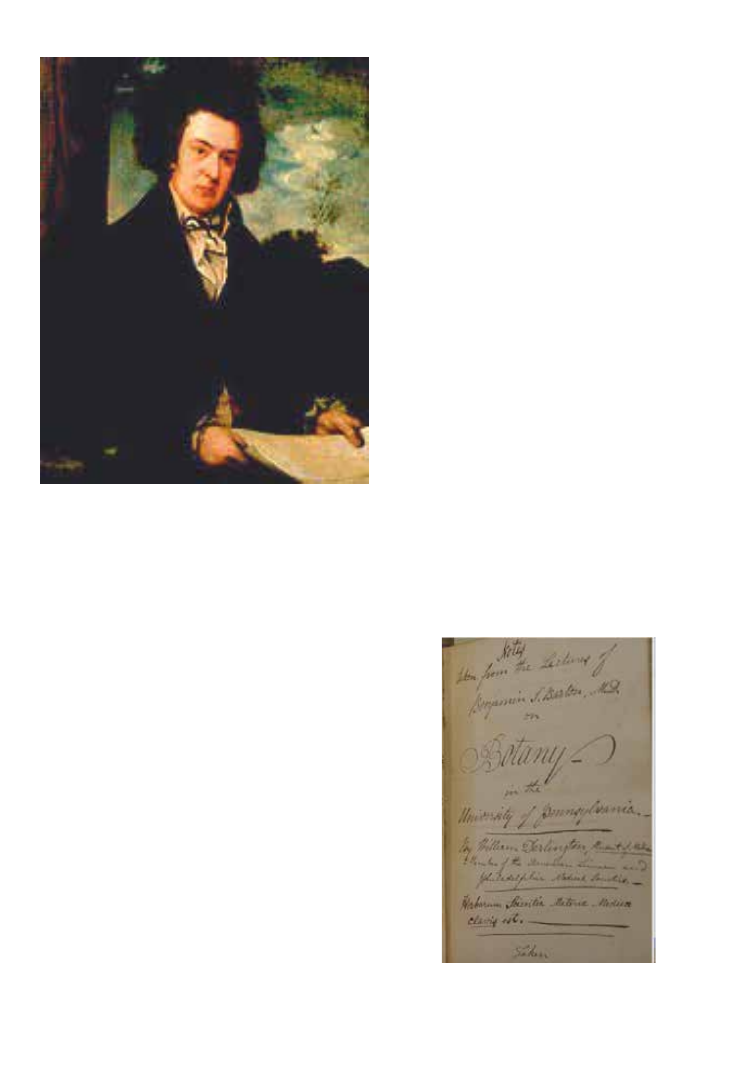
PSB 64 (3) 2018
173
this garden for learning botany, yet after three
years of study he left the University without
a degree (Ewan and Ewan, 2007; Sundberg,
2011). He arranged to take an honorary
degree from the University of Keil (see Ewan
and Ewan, 2007, pp. XV, 844, correction of
Barton and Barton, 1836) in the fall of 1789
and was immediately elected Professor of
Natural History and Botany at the College of
Philadelphia upon his return to Philadelphia
later that year (Barton, 1900). This despite
the admission that “I have never attended
any lectures, however imperfect, on Natural
History, or Botany” (Barton, 1807). Two years
later the College merged with the University
of Pennsylvania and his appointment was
confirmed. He taught botany every spring until
his death in 1815 (Barton and Barton, 1836).
Thirty-four years later, his student, William
Darlington, reminisced, “Professor Barton,
in those days, occasionally gave a course of
Lectures on Natural History and Botany, to
small classes in the University of Pennsylvania
(one of which courses, in 1803-1804, the
writer had the privilege of attending): and
there can be no doubt that he did more than
any of his contemporaries, diffusing a taste for
the natural sciences, among the young men
who then resorted to that school” (Darlington,
1849, p. 24). We remember our favorite
teachers for the impact they made on our lives,
but we don’t always remember specific dates;
Darlington had the right academic year, but
his hardbound course notebook dates from
April 3 through June 7, 1804 for the Botany
course. Like many students today he used
the same notebook for several courses—the
first half contains his notes from Dr. Barton’s
1802/3 Natural History lectures.
Barton’s Botany
Registration was by subscription and students
purchased a ticket to attend the course (Figure
2). In 1808, Thomas Jefferson paid $12
(approximately $240 today) for his grandson’s
Figure 1. Benjamin Smith Barton. With per-
mission of the American Philosophical Society.
Figure 2. Title page from Darlington’s Bota-
ny notebook in the rare book collection of the
University of Kansas. Photo by the author.

PSB 64 (3) 2018
174
ticket to Barton’s botany class (Ewan and Ewan,
2007, p. 787). During the first day of lecture,
April 3, 1804, Barton presented an overview of
the design and extent of the course (Table 1).
It would be primarily a lecture/demonstration
course with several field trips. It would meet
three to five days a week, but rather irregularly:
7 Mondays; 8 Tuesdays; 5 Wednesdays; 7
Thursdays; 8 Fridays; and 3 Saturdays from
Tuesday April 3 through Friday, June 7. At
the end of Volume 1 of the second edition
(1812), Barton notes, “The Botanical lectures
commence, annually between the 10
th
and 16
th
of April, and continue two months. Including
the excursions, the Professor delivers at least
four lectures every week.” Presumably classes
were in the morning, as Darlington makes
note that their field trip on Tuesday, May
15, was in the afternoon. The course was
divided into four main units: natural history
(but confined to the botanical branch),
plant structure, plant physiology and the
sexual system, and plant classification. “This
beautiful branch of natural history [botany] he
[Barton] calls the Key of the Materia Medica”
(Darlington, 1804, p. 3). This obviously made
an impression on the young student who went
back to the title page of his notes and beneath
his name “By William Darlington, Student of
Medicine, Member of the American Linnean
and Philadelphia Medical Societies” added the
phrase “Herbarum Scientia Materia Medica
clavis est“ [Plant science is the key to Materia
Medica] (Figure 3).
Barton’s newly published textbook was
certainly available for use in the course (Figure
4). Although some European botanists were
critical of the work, for occasional errors and
lack of scientific detail, William Hooker (later
the Royal Botanic Garden, Kew’s first director)
noted that “though rather diffuse in style, [the
text] is full of entertaining anecdotes: and the
April 3,
T Introduction
5, Th Affinities of plants and animals
6, F Affinities (cont)
11, W Roots
12, Th Radix, Herba @ Fructifuication
13, F Herbs
16, M Leaves
17, T Leaves (cont)
19, Th Bracts
21, Sa Fruits
23, M Flowers
24, T Flowers (cont)
27, F Pistil
28, Sa Doctrine of sexes
30, M Flowers
May 1,
T Sex in Palms
2, W Sex (cont)
3, Th Opposition to the sexual system
4, F Vegetable irritability
7, M Irritability (cont)
8, T Double flowers
9, W Seed germination
11, F Classification, Sexual System - Monandria -
Triandria
12, Sa did not go to class – celebrated acquisition of
Louisiana (covered Tetrandria - Hexandria)
14, M Classification- Heptancria - Enneandria (9
stamens)
15, T No lecture – visit Hamilton's garden
17, Th Classification Decandria – Icosandria (cont)
18, F Classification - Polyandria
21, M Classification - Didynamia
22, T Classification - Tetrahynamia
24, Th Classification - Monadelphia
25, F Classification - Diadelphia
29, T Classification - Polydelphia
30, W Classification - Syngenesia
June 1,
F Classification, Gynandria
4, M Classification, Monoecia
5, T Dioecia
6, W NO CLASS – Graduation Day (Dr. Medicine)
7, F Polygamia, Cryptogamia and Fungi.
Table 1. Botany Course Syllabus, 1804, recon-
structed from William Darlington's Lecture
Notebook.
references and terms being all made applicable
to American plants, it must have done much
towards recommending the study of botany
in that country” (Hooker, 1825, p. 271).
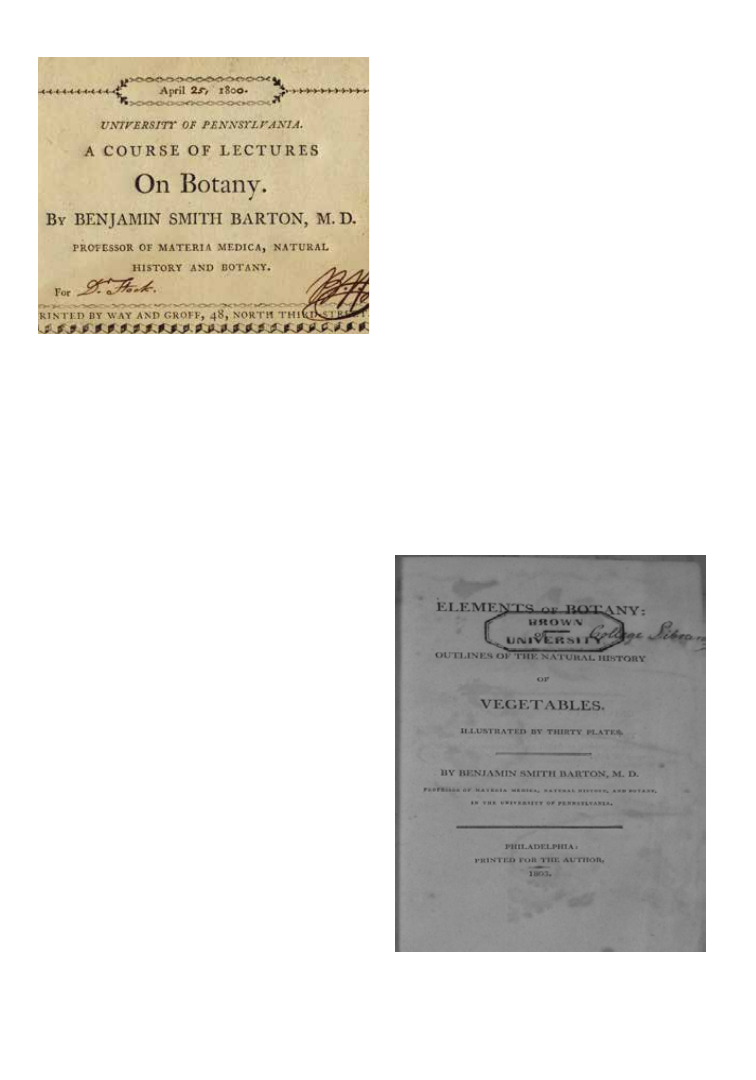
PSB 64 (3) 2018
175
Twice in his notes, Darlington commented
that the lecture “…was principally read from
his Elements…” It is not clear if Barton used
his 1803 self-printed first edition, or the
1804 London edition. It is also not clear if
Darlington had his own copy, but I suspect he
did. During the first three days of the course
his notes are extensive, and the material
covered was not included in the text (although
a discussion of the affinities of animals and
plants was scattered in two sections of his 1812
second edition part one and two additional
places in part two). Later, in the sections on
plant anatomy and physiology, the notes are
primarily a page or two of high points and
anecdotes related by Barton; in the last section
on classification, notes are mostly limited to
the names of families covered in lecture. On
two occasions Darlington noted that, “Dr. B’s
fourth lecture was principally a recital of the
first section of his Elements, illustrated by the
demonstration of the various kinds of roots, by
living specimens” (p. 19); and “It [the lecture]
was principally read from his Elements –and
illustrated by specimens” (p. 69) (Darlington,
1804). In addition, in his 1845 “Memorials,”
he commented, “Though somewhat diffuse,
it [Elements] was a useful and dependable
performance” (Darlington, 1845). It is
interesting to note that Darlington wrote his
notes on only the right side of facing pages
assigning each a sequential odd number—a
note-taking method I still recommend
so students have a place for calculations,
questions, comments, and critique (Sundberg,
2009).
So, if Barton was not reading the lecture
from his textbook, what was he doing? A
fairly extensive collection of Barton’s medical
course notes is housed at The Historical
Society of Pennsylvania Archives. Curiously,
many of the pages with medical notes on
one side have botany lecture notes on the
other. For instance, in the folder “Absorbant
System,” two sheets have botanical notes on
Figure 3. Ticket for 1800 botany course by
Benjamin Smith Barton from the Archives
of the American Philosophical Society. Note
that Hock is not listed as a pupil of Barton
who received his M.D. degree. (Ewan and
Ewan, 2007, 926). Photo by the author.
Figure 4. Title page, Elements of Botany, 1
st
edition from the John Hay Library, Brown
University. Photo by the author.
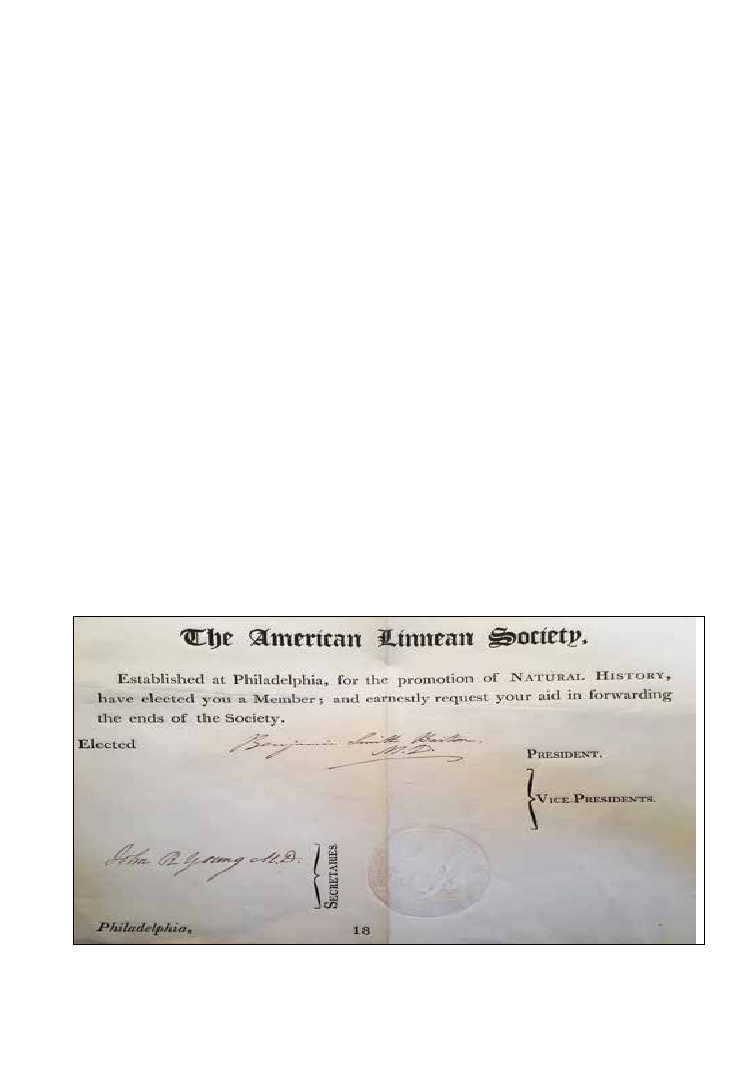
PSB 64 (3) 2018
176
the back: one describing alkali fertilizers and
the other horizontal root systems. The folder
“Absorption, Cutaneous” includes notes on
tuberous roots and perpendicular roots.
These notes summarize three of the five types
of roots discussed in his text, and while some
of the specific examples are the same (e.g., Iris
and Hops are included both in the text and his
notes), other examples are in one place or the
other. For example, he gives Cinquifoil as an
example only in his lecture notes, but may-
apple is only in the text (Barton, 1813, folder
A-B). On the back of lecture notes in the
Cynachetrachialis folder are botanical notes
on medicinal uses of the plants of the Family
Alliaceae as well as Sanguinaria canadensis
and Polygala Senega. An explanation of the
use of Indigo as a remedy is on the back side
of an American Linnaean Society certificate
(Figure 5). He also made use of many extra
printed pages (or tear sheets from surplus
books?) of his first edition botany text for
his medical lectures (Figure 6; Barton, 1813,
Folder C). In a memorandum dated August
5, 1814, Barton complained that some of his
“…memorandums, notices, &c., written upon
loose scraps of paper, in my usual way, were
mislaid, and could not, without some trouble,
be discovered…” (Ewan and Ewan, 2007, p.
909).
What was Barton like as a lecturer? According
to the biographical sketch by Middleton,
Barton’s greatest assets as a teacher were his
infectious “earnest and excited enthusiasm”
and his encouragement for students to “teach
themselves” (Middleton, 1936, p. 480). His
nephew’s comments about Barton’s teaching
style seem somewhat mixed. “As a medical
teacher, he was eloquent, instructive, and
when occasion called for it quite pathetic.
His voice was good, though attenuated,
penetrating, and sometimes rather sharp
—his enunciation clear and distinct—his
pronunciation constrained, and his emphasis,
owing to his remarkable kind of punctuation,
and a desire to be perspicuously understood,
was studied, forced, and often inappropriate.
Figure 5. American Linnean Society membership certificate, with notes on Indigo as a remedy
on the back side, from the Benjamin Smith Barton papers, Violet Delafield Collection, Ameri-
can Philosophical Society. Photo by the author.
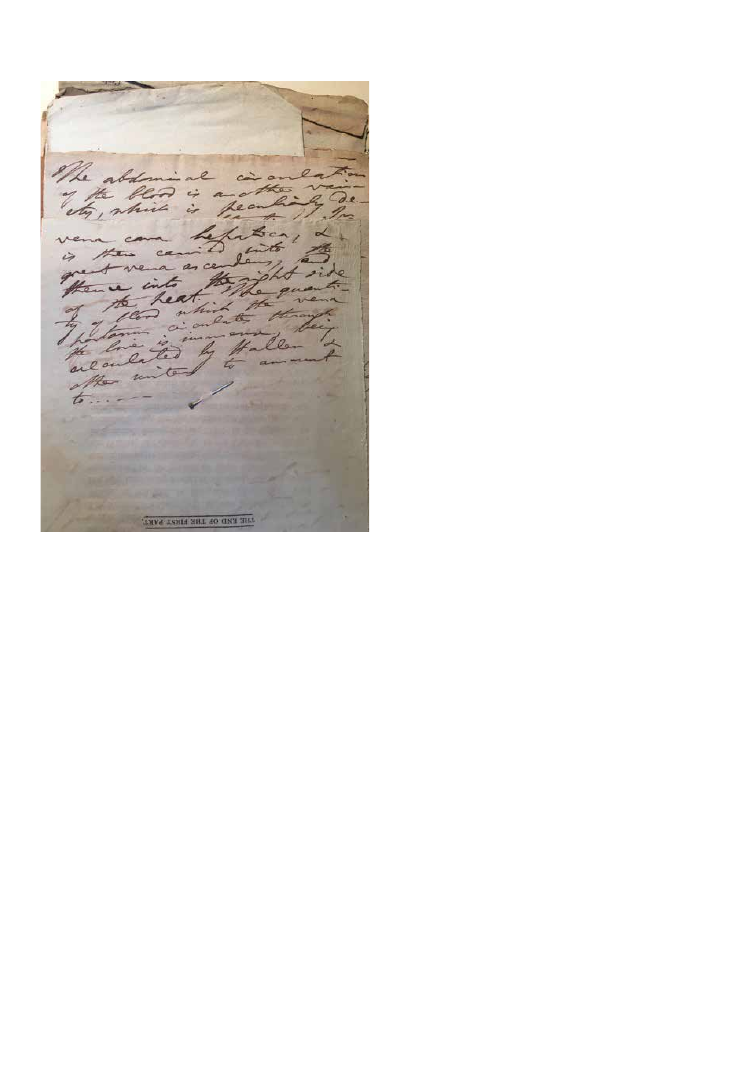
PSB 64 (3) 2018
177
In his lectures, his diction was cacophonous
and unpleasant” (Barton and Barton, 1836).
Barton always brought fresh examples to the
classroom to use in illustrating his lectures,
but he also brought his classes into the field.
The most common destination was Bartram’s
Garden, across the Schuylkill about 5 miles
from campus, which was visited twice by the
1804 class. Barton visited the Garden often,
but only a dozen miscellaneous notes of plant
flowering times between April 15, 1791 and
June 17, 1816 document these visits (Barton
Papers; Figure 7). Eight of these notes were
from dates that could be associated with
class visits. The others were from August,
September, or October. Furthermore, all but
two of the plant illustrations in the Elements
were originals by William Bartram. The
other commonly visited garden was William
Hamilton’s “Woodlands,” which was also
visited by the 1804 class. Other venues were
Landreth’s garden, along either the Schuylkill
or Delaware Rivers, or further afield. The field
trips were a course highlight for students.
According to Charles Wikins Short, an 1814
student in Darlington’s last botany class, “In
these excursions we reduce to actual practice
on any plant that presents those doctrines
which we have heard during the week – It is
indeed. a highly delightful study but I believe
that our venerable and eminent preceptor
would make anything so. I have seen him take
up a poplar leaf which I had trodden on, and
though destitute of every source of enquiry,
and talk most earnestly and eloquently for a
quarter of an hour on it...” (Short, 1814).
Darlington’s Notes
Natural History: Similarity of
Animals and Plants
As noted previously, the first lecture was
primarily course housekeeping and an
explanation of the rationale for natural
history, and particularly botany, in the medical
curriculum. It provided the background for
understanding Materia Medica, which was a
primary component of medical training. The
next two lectures, April 5 and 6, elaborated
on the affinities between plants and animals
and commanded four pages of notes each,
by far the most extensive elaboration in the
notebook. This information is not contained
in Barton’s Elements nor in any of his published
writings listed in Ewan and Ewan (2007).
Figure 6. Repurposed page from Elements
of Botany used for lecture notes—p. 145, end
of the first part from the Historical Society of
Pennsylvania archives, Philadelphia. Photo
by the author.
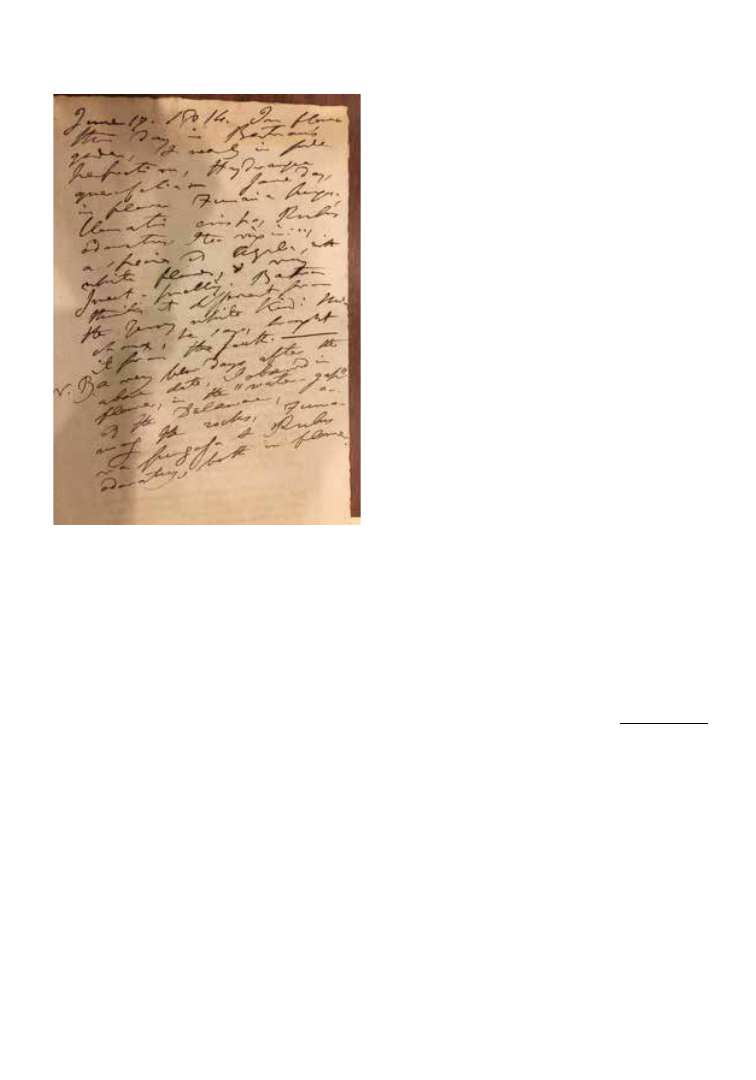
PSB 64 (3) 2018
178
Barton’s teaching was similar to his writing
style in the Elements; he would state a claim
by some authority, then go on to provide
supporting or contrary evidence, based on his
own observations, or published observations
of others. This was intriguing for students,
like Darlington, but seemed disjointed to
other botanists. One interesting example was
his use of poke berry juice (a natural dye he
used for tracking diffusion in tissues [Barton,
1814. Elements, Vol 2, p. 22]) in tubers to
demonstrate accelerated absorption following
application of camphor and nitre [potassium
nitrate]).
Barton went on to say that all animals can
produce some heat independent of the
atmosphere, but that some plants can do the
same. The example he cites was an experiment
by John Hunter (Table 2) who noticed that
ice forms on a dead branch faster than on a
living branch (Darlington, 1804, p. 9). What
about breathing? Animals have various
respiratory organs including the spiracles of
insects. Barton noted that it has been proved
that if you cover the spiracles with oil, the
insect will die in the same way that if you
cover the trachea [stomata] of leaves with
oil, they will die as well. (This was actually an
experiment performed by Erasmus Darwin,
1791, Vegetable Respiration, Note XXXVII,
part I, p. 102.) Furthermore, Barton explained
that Joseph Priestley demonstrated that plants
gave off “pure air, and supposed that the two
kingdoms of animals and vegetables labored
reciprocally for each other” (Darlington,
1804, p. 9). The only animal organ that does
not appear to have a plant counterpart is
the stomach. “Vegetables have no stomach,
properly so called” (Darlington, 1804, p. 11).
The focus of lecture three was the affinities
between plant and animal reproduction.
Hermaphrodites are found among both plants
and animals “...although some philosophers,
more squeamish than wise, have wished
to abolish the term from Dictionaries”
(Darlington, 1804, p. 13). There are also some
animals and plants with no sex. Just as horses
and asses form hybrid mules, hybrid offspring
can be produced by the union of different
plants, for example mullein and tobacco
(Darlington, 1804, p. 13). Johann Hedwig
thought that the true distinction between
plants and animals was that the stamens
(male organs) of plants always die and drop
off after producing pollen for insemination,
whereas this does not happen in animals. But
Barton noted that Samuel Hearne claimed
that the Hudson’s Bay hare “sheds its penis
Figure 7. June 17, 1814 notes on plants flow-
ering in Bartram's Garden from the Barton
Papers, Delafield Collection, American Phil-
osophical Society. Photo by the author.

PSB 64 (3) 2018
179
• Moreland (1703) – pollen fertilizes ovule
• Johannes Hedwig (1730-1799) – sex in cryptogams
• Antonie Philips van Leeuwenhoek (1632-1723) – sex in
animalicules
• Joseph Pitton Tournefort (1656-1708) – rejected Linnean
system
• Giulio Pontedera (1688-1757) – rejected Linnean system
• Antoine Laurent de Jussieu (1748-1836) – maple pollen said
to be hollow
• Aristotle (384 BC-322 BC) – pollen necessary to fertilize
palms
• Fredrick Hasselquist (1722-1752) – Arabs pollinate date
palms
• John Hope (1725-1786) – produced hybrid poppy
• Abbe Francisco Javier Clavigero (1731-1787) – some in-
stances of the propagation of mules
• William Smellie (1740-1795) – argued against sexual sys-
tem
• James Logan (1674-1751) – American botanist saw pollen
in style of maize
Lectures 19-22
• Charles Bonnet (1720-1793) – categorized motions of
plants
• Felice De Fontana (1730-1805) – categorized motions of
plant
• Erasmus Darwin – Loves of Plants, Canto 1, Lines 51-56;
double flowers
• Lord Kaimes (1696-1782)
• Linnaeus – flowers open and close at certain times
• John Walker (1731-1803) – Magnolia seeds must pass
through digestive tract before germination
• Friedrich Alexander von Humboldt (1769-1859) – light not
essential for color of vegetables
• Thomas Jefferson (1743-1826) – vegetable thermometer
Lectures 23-37
• Linnaeus – sexual system
• Frederick Burckhardt – proposes sexual system before Linnaeus
• Note: I have not found De Sexu Plantarum by this author, as
per Darlington’s notes, but:
• De Sexu Plantarum, Adam Zaluzansky, 1592, 1604.
• De Sexu Plantarum epistola, Rudolf Camerarius, 1694
• Pythagoras (570 BC – 495 BC) – legumes produce bitter
honey
• Bruce – legumes produce bitter honey
• Minnick ? – fungi form by crystallization
Lectures 2-3 Affinities between Plants and Animals
• Joachin Jungius (1587-1657) – plants lack sensation, cannot
move
• Herman Boerhaave (1668-1738) – plants cannot move
• Lazzaro Spallazoni (1729-1799) – plants are racemose animals
• Joseph Pitton de Tournefort (1656-1708) – plants have roots by
which they are nourished
• James E. Smith (1759-1828) – plants are organized bodies devel-
oped by nutrition and that produce secretions
• Carolus Linnaeus (1707-1778) – stones grow, plants grow and
live, animals grow, live and feel
• Albrecht von Haller (1708-1777) – irritability is peculiar to an-
imals
• John Hunter (1728-1793) – a living branch produces heat, but
only animals have a stomach
• Joseph Priestley (1733-1804) – plants give off pure air (oxygen)
• Edward Tyson (1651-1708) – animals have an alimentary canal
• Alexander Monro 1st (1697-1767) – some animals have no
heart
• Johann Hedwig (1745-1792) – male organs of plants always
die and drop off after impregnation but those of animals do not
• Samuel Hearne (1745-1792) – Hudson's Bay hare sheds its pe-
nis after use
Lectures 4-13 Roots, stems, leaves, and flowers
• Sir John Hill (1714-1775) – author of "The Vegetable System"
• Anonymous "French Botanist" proved Viscum is a parasite
• Linnaeus
• Horace Benedict de Saussur (1740-1799) – rete muscosum in
plant leaves
• Caspar Friedrich Wolfe (1734-1794) – blood becomes red
when oxygenated
• Claude Louis Berthollet (1748-1822) – leaf color change in au-
tumn due to oxygenation
• Erasmus Darwin (1731-1802) – bracts oxygenate the sap go-
ing to flowers
• Charles Louis L'Heritier de Brutelle (1746-1800) – pistils of
peach and other fruits freeze before stamens
Lectures 14-18 Doctrine of sexuality in plants
• Linnaeus
• Empedocles (495 BC - 444 BC) – plants have different sexes
• Andrea Cesalphinus (1519-1603) – female plants fertile,
male plants sterile
• John Ray (1627-1705) – anthers are male organ
• Neahmiah Grew (1641-1712) – Plants have sexuality
• Rudolph Jakob Camerius (1665-1721) – experiments on
sex in hemp and maize
Table 2. Scientists referenced by Barton during his lectures (birth and death) and topic con-
sidered by Barton. Number of citations is inversely related to topical coverage in Barton's
Elements of Botany.

PSB 64 (3) 2018
180
after coition... the testes of fowls are known to
diminish after the season of love” (Darlington,
1804, p. 15). “Both plants and animals, as far as
we can get see, are similar in all respects. Both
plants & animals are blindly led by the laws of
nature. Man himself is as blindly led by those
Laws as the simplest vegetable” (Darlington,
1804, p. 15). After spending another page
and a half describing chemical similarities
between plants and animals, Darlington
summarizes: “Dr. B. does not deny that there
may be a difference; but he says it is not yet
discovered” (Darlington, 1804, p. 19).
Structure of Flowering
Plants
“Dr. B’s fourth Lecture was principally a recital
of the first section of his Elements; illustrated
by the demonstration of the various kinds of
roots, by living specimens” (Darlington, 1804,
p. 9). After a brief review of Natural History,
and some elaboration of the difference
between geology and minerology, most of the
lecture covered roots. Darlington notes that it
is important to remember that the Bulbosa are
generally active plants but boiling “deprives
them of their active qualities” (Darlington,
1804, p. 11).
In the fifth lecture, Barton quickly diverges
into commentary. For instance, while in many
plants, the fructification is very evident, as in
the apple and other trees, in the case of ferns it
is not so—instead, they are on the back sides
of leaves. Later, “Dr. B. lays it down as a rule,
that the tendency of all plants is to become
perennial” (Darlington, 1804, p. 21). This is
often an adaptation to climate—genera that
are herbaceous in the north are frequently
woody and perennial in warmer climes. On
parasitic plants, “Linnaeus called a parasitic
plant Hillia parasitica, after Sir John Hill,
who was a great flatterer and parasite of the
nobility of his time” (Darlington, 1804, p. 23).
According to Barton, Tillandsia usneoides is a
parasitic plant that is used by upholsterers to
fill matrasses. “A French Botanist has proved
that viscum, a parasite, does receive a part of
its nourishment from the plant supporting
it. He put an apple tree limb into pokeberry
juice, in such a manner that the viscum
roots did not touch it. The limb absorbed it,
and it appeared in every part of the viscum”
(Darlington, 1804, pp. 23-25).
Similar commentaries perfuse Barton’s
lectures on stems and leaves. “As physicians we
should remember that all culmiferous plants,
with the exception of Lolium, are nutritious . . .
whenever we meet a culmiferous plant, we may
conclude with safety, 999 times in 1000, that it
is nutritious” (Darlington, 1804, p. 25). Leaves,
according to Barton, are “...compressed and
extended petioles...” continuous with the
layers of the stem. He goes on to describe a
maceration technique to visualize venation by
soaking the leaves for 10 to 15 days in warm
water in the sun and, when it becomes pulpy,
pressing it between two sheets of muslin. When
the sheets are separated, the parenchyma
adheres to the muslin and the skeleton of veins
remains. However, “Caterpillars make the
best skeletons of leaves” (Darlington, 1804, p.
29). Barton goes on to say that some plants,
like Ilex, have two layers of reticulate vessels
and an orange leaf has three. “Dr. B. thinks
those vessels are real absorbents. Leaves are
respiratory organs, or the Lungs of vegetables”
(Darlington, 1804, p. 29).
According to Barton, oxygen has a special role
in animals for inducing irritability because,
as shown in chick development by Caspar
Friedrich Wolfe (1734-1794), blood does not

PSB 64 (3) 2018
181
turn red until it is oxygenated and only then
does the embryo begin to respond—that
oxygen imparts irritability “...is likely probably
the same in vegetables” (Darlington, 1804,
p. 29). Barton explains that the largest leaves
on any plant growing in the United States are
those of Magnolia growing in North Carolina,
which can be up to 30 inches long, but these
are small compared to various palms. Barton
went on to explain that Claude Louis Berthollet
attributed leaf color change in the autumn to “a
preternatural absorption of oxygene [sic].” But
Darlington notes: “Dr. Barton is not satisfied
with this explanation but says it is well worth
inquiring into. The same species of plants
always assume the same color at the same
time. The defoliation of those plants, in our
country, which are Evergreen in temperate,
equable ones, is owing to the vicissitudes of
climate” (Darlington, 1804, p. 29).
According to Barton, the action of tendrils
demonstrates that “Plants have real
Intelligence.” Not only does the direction of
coiling, left or right, remain constant within
a species, but the Hops plant will always seek
out the nearest support, even if it is in less
light (Darlington, 1804, p. 31). “In Sarracenia
the leaves are hollow, to collect water for the
support of the plant. They demand much
water, & are never found without” (Darlington,
1804, p. 31). Yet in his extensive description
of this plant (Barton, 1803, pp. 301-305,
caption to Fig. 1), Barton explains that while
it was thought that the hollow leaves served
as water reservoirs, “I have not yet made the
experiment, but the experiment would I think
show, that our plant would flourish very well,
were we to close the openings of the ascidia,
and completely prevent them from receiving
any supply of water from external sources”
(p. 302). Unfortunately, this wonderful
description of the pitchers, collecting and
digesting insects, frogs, and other small
animals, was deleted from all subsequent
editions.
Barton attributes to Darwin (1791) that the
function of bracts “is to assist in the perfection
of the flower to oxygenate the sap. In a species
of Euphorbia, the bractes [sic] become red
immediately upon the expansion of the flower
– said to be from the absorption of oxygene
[sic]” (Darlington, 1804, p. 33). Barton
distinguishes between leaf buds, flower buds,
and buds containing both, and he thinks
that most buds are the latter but flowers do
not appear “because there is not sufficient
vegetating power” (Darlington, 1804, p. 33).
He also says that it was generally believed that
when trees begin to grow in the spring, it is
from the top down, but that it is now known
that sap begins to flow from the bottom of the
tree.
Lecture 10 begins the section on reproduction,
and the next three lectures, on floral parts,
are brief in Darlington’s notes: “...for good
accounts of which, see his [Barton’s] Elements
of Botany” (Darlington, 1804, p. 35).
According to Barton, Linnaeus is too broad
in his definition of nectary, which Barton
thinks should only be applied to parts that
“secrete a honied liquor.” Concerning the
style, it is hollow in many plants but never
hollow in others. In these, Barton produced
an opening by applying camphor, musk, or a
small amount of alcohol—another example of
plant sensitivity.
The Sexual System
Lectures 14-16 again stimulate extensive note-
taking as Barton discusses the “Doctrine of
the Sexes of Plants” (Darlington, 1804, p. 37).
This begins with an extensive history of the
study of sexuality in plants, beginning with

PSB 64 (3) 2018
182
Empedocles who, according to Aristotle, said
plants were of different sexes. According to
Barton, Andrea Cesalpinus [sic] was the first
to understand the true nature of plant sexuality
and who “first taught Botany with precision
and system” (Darlington, 1804, p. 39). While
Neahmiah Grew was the first to ascribe male
function to the anthers, “...Camerarius was the
first who proved it by his own experiments”
(Darlington, 1804, p. 39). On the other hand,
Joseph Pitton Tournefort and Giulio Pontedera
both denied the sexuality of plants. Linnaeus
resolved the issue in 1703 with multiple
arguments: (1) Procendentia, pollen is shed
while the flower is most vigorous and before
the fruit forms, (2) Situs, stamens are placed
where pollen can be shed onto the pistil, (3)
Tempus, anthers release pollen at the same
time pistils are receptive, (4) Loculamenta,
cellular nature of the pollen, (5) Pluvia, the
closing or drooping of flowers at night or
before a rain to protect the pollen, (6) Fumus,
drying of pollen in city smoke—thought not
to be of much importance by Barton, and
(7) Figura, pollen is of similar shape. “The
granules of the maple are said by Jussieu to be
hollow; and that when they come in contact
with the moisture of the stigma, they burst and
give out their fovilla—here we see another use
of the moisture, besides that of holding the
pollen” (Darlington, 1804, p. 43).
Barton appears to begin the next lecture with
a brief review of the previous day stating that
there are the same number of cells in the ovule
as there are in the future seed (a validation of
Linnaeus’ Locumenta?). Linnaeus’ arguments
continue: (8) Castratis, if the anthers are
removed, no seeds are produced or they
will abort, (9) oculus; visible pollen on the
stigma prior to fruit and seed production of
the pistil, (10) Proportis, the flower stands
erect when the stamens are the longest, and
(11) Locus, having the anthers situated above
the pistil in legumes. Barton notes that this
position is reversed in pines where female
cones are above the males, but here pollen is
produced in such abundance as to cover the
ground. “Dr. B. thinks the showers of Sulphur
mentioned in the Scriptures, consisted of the
pollen of the pines. In Sweden this pollen is
mistaken for Sulphur, by the ignorant, to this
day” (Darlington, 1804, p. 45).
Barton again appears to begin the next class
with a review of wind pollination, but then
diverges to discuss palms. The sexual nature
of palms was known to Aristotle and that
if pollen is shaken onto the female organs,
seeds will quickly ripen. Palms grow in warm
countries and not north of Charleston, South
Carolina, in the U.S. “A female Date tree
which was 70 years old, and had never borne
fruit, was impregnated with pollen 9 days old
—it bore fruit in consequence... Hasselquist
saw the Arabs climb the female palms with
male branches in their hands, with which they
powder the females, and thereby impregnate
them. The Arabs told Hasselquist that they
kept an unopened, or unprotruded spadix,
or bunch of male flowers, over year, in case
the other should fail” (Darlington, 1804, p.
45). Barton goes on to explain that the figs in
the United States do not produce viable seed
because “we do not have that insect which is
known to impregnate the females in France,
Portugal” (Darlington, 1804, pp. 47-49).
Linnaeus’ 12th argument is Flora Submersa, an
example of which is Vallisneria Spiralis, which
has female flowers on a long stalk that reaches
the surface and male flowers on short stalks
that release their pollen to float to the surface
and fertilize the females. Linnaeus’ next
argument is a summary of the sexual system.
In many flowers, such as several species of
Saxifrage, Ruta graveolens, and Tobacco, the

PSB 64 (3) 2018
183
stamens approach the pistil, release their
pollen, then return to their former position.
“The Weeping Willow of our country is only
the female of that plant; and a seed from it has
never been known to germinate. The Male has
never been even in Europe until the French
lately brought it there from Egypt.”
Linnaeus’ last argument is the formation
of hybrids. He thinks that “all species are
the product of the copulation of different
genera. Dr. B. does not adopt this opinion
in its full extent...” (Darlington, 1804, p. 51).
The rest of this lecture contains examples of
plant hybridization. For example, John Ray
described a gardener who sold collyflower
[sic] seed to a man who planted them near
cabbage and a hybrid was produced. The man
filed suit and recovered damages. “We know
150 hybrid vegetables” (Darlington, 1804, p.
53).
Lecture 18 consisted of arguments opposed
to the sexual system, primarily by William
Smellie in his Philosophy of Natural History.
Bartram counters every argument by Smellie,
and Bartram’s position is clear: “The Anti
Sexualists acknowledge their ignorance of the
use, or final cause of the generative organs of
plants, while the Sexualists explain it.”
Plant Irritability
Lectures 19 and 20 consider plant irritability,
a topic not directly covered in the textbook.
He begins with plant movements, particularly
of stamens, and makes a distinction between
voluntary and involuntary movement. As
an example of the former, Barton describes
geranium with 5 straight and 5 reflexed
stamens. The straight stamens release their
pollen first, and then the reflexed stamens
extend themselves and release their pollen.
Common barberry is an example of the latter
because when the stamens are irritated, they
immediately approach the pistil and discharge
their pollen. He cites Erasmus Darwin for
examples where the stamens are shorter than
the carpels (Darwin, 1791, Loves of the plants,
Canto 1, line 51-56). Roots demonstrate
considerable irritability, as do the sleep
movements of leaves. Mimosa is particularly
noteworthy for their response to contact. “Dr.
B has seen them contract from the influence
of the odor of musk; which shows that it is not
owing to the mechanical impulse” (Darlington,
1804, p. 61). The glandular part at the joint is
the site of this response. Yet, these leaves will
not respond to burning with a lens as long as
the glandular part is not affected.
Barton then proceeds to discuss seeds. Some
plants, like turnip, germinate early while
others, such as parsley, are very late. “Hence
the vulgar proverb in England, that ‘parsley
seed goes nine times to the Devil before it
comes up!’” (Darlington, 1804, p. 63). The
radical always grows down toward the earth
and the plumule grows upward.
The following two lectures continued on
the topic of seeds, but now principally read
from Elements. Barton notes that neither the
Burdock, scattered by burs, nor Dandelion,
scattered by its pappus, are native to America
but are scattered widely. According to John
Walker, Magnolia seeds would not germinate
in Europe until they passed through the gut of
Turkeys. Barton said he could not germinate
Ginseng until he feed seeds to Dunghill
fowls. He notes that Friedrich Alexander
von Humboldt demonstrated that some
mushrooms grow in mines, without light, and
finally states, “The Vegetable Thermometer, as
Mr. Jefferson calls it, is the best criterion of the
nature of a climate” (Darlington, 1804, p. 67).

PSB 64 (3) 2018
184
Plant Taxonomy
The rest of the course was a taxonomic
survey of plants using Linnaeus’ Sexual
System. Barton begins by noting that prior
to Linnaeus, Frederick Burckhardt published
an essay De Sexu Plantarum that “...says that
the Doctrine of the Sexes is fully established
– that the roots, leaves, fruits, etc. Afford
objectionable, and often fallacious criteria
for classification; and asks if a better one may
not be established upon the male organs;
and the ordinal divisions upon the female
organs?” (Darlington, 1804, p. 67). Barton
says Linnaeus “undoubtedly saw the paper”
but never acknowledged Burckhardt.
Darlington skipped class on May 12 to take
part in a celebration of the Louisiana Purchase,
but Barton taught the class as usual. On the
15th the class went to Hamilton’s garden in
the afternoon (Table 1). Darlington notes that
this is the third trip taken by the class; the
other two were to Bartram’s Garden. On the
18th, Barton mentions that the bulbous root
of Ranunculus bulbosus causes blisters but is
used to treat palsy and chronic rheumatism.
Boiling removes the toxin (Darlington, 1804,
p. 71). On May 24, Barton described a hollow
Plantanus he saw growing on the bank of the
Ohio River that was so large, “...two men rode
round abreast on horseback, in the hollow if it.”
And the next day, when discussing legumes,
he stated, “this class furnishes a very flatulent
alimentary product” (Darlington, 1804, p.
75). On May 30, when describing composites,
Barton said “...the middle states of the U.
States, would contain more syngenesious [sic]
plants than ten times as much space of any
other part of the world” (Huntington, 1804,
p. 77). Concerning maize, “The Zea mays was
never seen growing in a wild state, since the
memory of man – or, if it do grow wild, it has
been so altered by cultivation that we do not
know it. We do not know its native country –
neither do we know the native country of the
Wheat, the Barley, nor the Rye. One species
of the Wheat, however has been seen growing
wild in Persia. The Hickories are peculiar
to our country” (Darlington, 1804, p. 79).
On June 6, there was no lecture because of
commencement and the awarding of Doctor
of Medicine degrees. Finally, the last day, June
7, covered the fungi, after which, “Dr. Barton
bade us a polite, & perhaps a Last Adieu. Finis
Notarum” (Darlington, 1804, p. 79).
Conclusions
Barton’s primary recognition is as a teacher
who promoted botany and the botanical
research of his students and collaborators
and, I will argue, remains an excellent role
model for professors of botany today. In
many ways his approach to teaching was
similar to Amos Eaton’s, and both chose to
use Linnaeus’ sexual system of classification
for the ease with which it could be employed,
despite their recognition of the merits of
Jussieu’s Natural System (Ewan and Ewan,
2007, p. 829; Sundberg, 2011). Even in the
first edition of the Elements, Barton notes that
Linnaeus’ Sexual System will be “deserted”
for a more natural one (Barton, 1803, p. 189).
Thomas Jefferson, who shared much botany
with Barton, seems to summarize it well. “I
adhere to the Linnaean because it is sufficient
as a groundwork; admits of supplementary
insertions, as new productions are discovered,
and mainly because it has got into so general
use that it will not be easy to displace it” (Ewan
and Ewan, 2007, p. 567). A major difference
between Barton and Eaton’s approaches was
that Barton’s students, all male, were preparing
for careers in medicine whereas Eaton

PSB 64 (3) 2018
185
encouraged men and women to study botany
for the sake of science (Sundberg, 2011). It
appears that Barton was taking great pains to
highlight the similarities between the plants
his students were studying in botany and the
human biology they focused on during the
rest of their medical training. Eaton did not
have this concern.
Traits drawing comment from former
students were especially Barton’s infectious
enthusiasm for the subject and ability to
apply instruction to the local flora and to
medicine. His textbook, the first botany
textbook published in America, illustrates his
understanding of the field and familiarity with
the work of his European contemporaries
and predecessors. Yet, it was not adopted by
others in America, presumably because of his
frequent injection of opinion, commentary,
and asides. The class notebook of one of these,
William Darlington, provides much insight
into Barton’s pedagogy. Lectures were not
pure recitation from his textbook, although
in some instances he resorted to this when
the goal was to present salient information as
concisely as possible, such as the terminology
relating to the structure of parts or the
classification of species. In such instances,
Darlington’s notes are brief, and he simply
refers to Barton’s Elements. Some topics were
not covered in the text at all, or only briefly,
such as the commonalities between plants and
animals, and plant irritability, and some were
of controversial topics still unresolved, or only
recently resolved, such as sexuality in plants
and the sexual system of Linnaeus. On these
topics Darlington’s notes are extensive and
Barton makes extensive citation of the works
of others. You can almost feel that Darlington
felt he was being brought into the company
of botanical scientists and their research. The
fact that this was an elective course, but that
it still “made and paid” every year of Barton’s
tenure, speaks to the popularity of the course
and its instructor.
Acknowledgements
I thank the reading room staffs at: The
American Philosophical Society, Philadelphia;
The Historical Society of Pennsylvania
Archives, Philadelphia; and The Spencer
Library, Rare Books Room, University of
Kansas, and two anonymous reviewers.
Literature Cited
Barton, B. S. 1900. Collections for an essay to-
wards a Materia Medica of the United States.
1798, 1804. Bulletin of the Lloyd Library of Bota-
ny, Pharmacy, and Materia Medica. 1 (Reproduc-
tion series 1): 1-10.
Barton, B. S. 1803. Elements of Botany or Out-
lines of the Natural History of Vegetables. Phila-
delphia, Printed for the author.
Barton, B. S. 1804. Elements of Botany or Out-
lines of the Natural History of Vegetables. Lon-
don. Printed for J. Johnson, St. Paul’s Churchyard
by I. Gold, Shoe Lane.
Barton, B. S. 1807. A discourse on some of the
principle desiderata in natural history and on the
best means of promoting the study of this science
in the United States. Philadelphia, Denham &
Town.
Barton, B. S. 1812. Elements of Botany or Out-
lines of the Natural history of Vegetables. 2
nd
Edi-
tion. Volume 1. Volume 2, 1814. Philadelphia.
Printed for the author.
Barton, B. S. 1813-1815. Lecture notes: A-B.
C-D. The Historical Society of Pennsylvania Ar-
chives, Collection 1623. Philadelphia.

PSB 64 (3) 2018
186
Barton, B. S. and W. P. C. Barton. 1836. Elements
of Botany or Outlines of the Natural history of
Vegetables, new edition revised and condensed
with an account of the life of the author.
Barton Papers. Benjamin Smith Barton papers.
Violetta Delafield collection, American Philo-
sophical Society. Mss. B.B.284d. Series II, Bar-
ton Notes. Lectures on Botany, Botanical Notes
#1 - #12.
Bartram, W. 1783. Catalogue of American Trees,
Shrubs, and Herbaceous Plants, most of which
are now growing, and produce ripe seed in John
Bartram’s Garden, near Philadelphia.
Bartram, W. 1807. A Catalogue of Trees, Shrubs,
and Herbaceous Plants, Indigenous to the United
States of America; Cultivated and Disposed of by
John Bartram & Son at their Botanical Garden,
Kingsess, near Philadelphia: to which is added a
Catalogue of foreign plants, collected from Var-
ious Parts of the Globe. Bartram and Reynolds,
Philadelphia.
Darlington, W. 1804. Notes taken from the Lec-
tures of Benjamin S. Barton, M.D. on Botany in
the University of Pennsylvania. Darlington (Wil-
liam) papers, University of Kansas, Spencer Li-
brary, MS C154.
Darlington, W. 1849. Memorials of John Bartram
and Humphry Marshall; with notices of their bo-
tanical contemporaries. Philadelphia: Lindsay &
Blakiston.
Darwin, E. 1791. The Botanic Garden: A Poem,
in two parts. Part I. The economy of vegetation.
Part II. The loves of the plants. with Philosophical
Notes. J. Johnson, London.
Ewan, J. 1969. A short history of Botany in the
United States. Hafner Publishing Company, New
York.
Ewan, J., and N. D. Ewan. 2007. Benjamin Smith
Barton: Naturalist and Physician in Jeffersonian
America. Missouri Botanical Garden Press, St.
Louis
Hooker, W. J. 1825. On the botany of America.
American Journal of Science. 9: 263-284.
Middleton, W. S. 1936. Benjamin Smith Barton.
Annals of Medical History new series 8: 477-491.
Short, C. W. 1814. Letter to John Cleaves Short.
Library of Congress, Manuscript Division, Wash-
ington, D.C.
Smellie, W. 1808. The Philosophy of Natural His-
tory. Thomas & Tappan & Samuel Bragg. Dover,
New Hampshire.
Sundberg, M. D. 2009. Botany 213, Biology of
Plants. Printed by author, Emporia, Kansas.
Sundberg, M. D. 2011. Botanical education in the
United States: Part 1, The impact of Linnaeus and
the foundations of modern pedagogy. Plant Sci-
ence Bulletin. 57: 134-158.

187
SCIENCE EDUCATION
By Dr. Catrina Adams,
Education Director
BSA Science Education News and Notes
serves as an update about the BSA’s educa-
tion efforts and the broader education scene.
We invite you to submit news items or ideas
for future features. Contact Catrina Adams,
Education Director, at cadams@botany.org.
“I think simply working with the teachers really
helped me understand how students think
about photosynthesis. This way, as a mentor
and liaison, I can help the students with
misconceptions and provide useful feedback as
they develop their own projects.”
“It’s really easy to just tell people the answer. It’s
actually much harder to slow down and wait
for them to come to it on their own.”
“I used to make a lot of assumptions about high
school education…now I know what they learn
in high school. I know what to expect when they
enter college.”
“I now use many of those things back in my class
here in the university…for example how to ask
questions that will trigger students to answer
in a deeper way…so I changed the way I asked
questions so students get more opportunities to
express themselves.”
Digging Deeper Fellows from the NSF-
funded Digging Deeper research project
report that the experience increased their
understanding of what effective teaching
looks like, increased their understanding of
what students experience in high school, and
gave them ideas for how to improve their own
science teaching.
Teachers also report how valuable they found
opportunities to interact with mentors during
the workshop.
“Carrying out the project on the PlantingScience
website and corresponding with the mentors via
the website was incredibly helpful, especially
because our project didn’t get the results
we expected…We learned that we had to
communicate really clearly, that it was super
fun when our mentors talked to us, and got a
sense of how our kids would feel.”
Early-Career Scientist
PlantingScience Liaisons Both Help
and Benefit from Interactions with
Secondary Teachers and Their Students
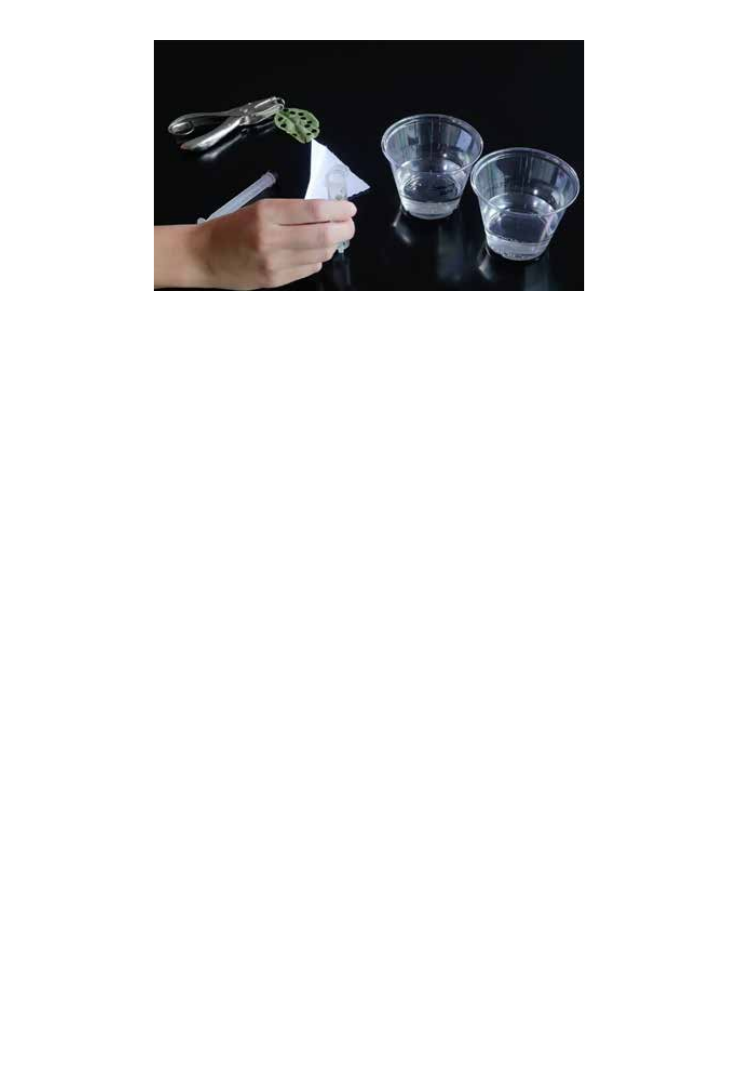
188
“The time we spent working with the
mentors really helped build relationships and
collaboration.”
During and after the workshop, Digging
Deeper Fellows were involved in developing
new resources for students and mentors. The
first of these new resources are being released
this fall, including a PlantingScience mentor
tips video (https://vimeo.com/293044208)
and a humorous video explaining the leaf disk
flotation method used in PlantingScience’s
Power of Sunlight photosynthesis and
respiration investigation theme (https://
vimeo.com/293030333) (Figure 1).
The 45 scientists who participated in Digging
Deeper are part of a larger cohort of graduate
students and postdocs who make up our
Master Plant Science Team (MPST). These
scientists serve as mentors to teams of students
and as liaisons for secondary school teachers.
They help teachers make mentor matches for
their teams and ensure good communication
between a teacher and his or her mentors, as
well as stepping in to help keep all the student/
scientist conversations going strong. BSA is
Figure 1. Screenshot from a video covering what is needed to conduct leaf disk flotation experi-
ments. Developed by Digging Deeper Fellows, the video will be used to support the Power of Sun-
light photosynthesis and respiration module, but can also serve as a stand-alone resource for AP
biology students and others who will use the technique.
supporting the following 23 scientists on the
MPST for 2018-2019:
Ioana Anghel, Alina Avanesyan, Liming Cai,
Ghana S. Challa, Foong Lian Chee, Mason
Kamalani Chock, Aayudh Das, Kelsey Fisher,
Laura Klein, Joshua Kraft, Jill Marzolino,
Angela McDonnell, Molly Ng, Funmilola
Mabel Ojo, Mischa Olson, Carlos J. Pasiche-
Lisboa, Kelly Pfeiler, Christina Scara, Jaime
Schwoch, Elizabeth Scott, Nicolette Sipperly,
Elizabeth Stunz, and Lauren Elizabeth
Whitehurst.
These graduate students and post-docs help
high school teachers to teach more plant
biology in the classroom, which is so essential
to capturing student interest and increasing
appreciation for plants. Please thank them for
their service to the field!
Learn more about the benefits and
requirements of being on the Master Plant
Science Team and consider joining next year’s
MPST cohort of graduate students and post-
docs: https://plantingscience.org/joinmpst.
Applications will open at the end of this
academic year.

PSB 64 (3) 2018
189
You don’t have to be an early-career scientist
to mentor with PlantingScience! We are
looking for scientists of all career stages to
volunteer, and you can choose which sessions
you are available to mentor. Sign up to mentor
here: https://plantingscience.org/mentorjoin/
mentorjoinmain.
We are also recruiting middle and high school
teachers to participate in PlantingScience with
their classes. The program is free to teachers; we
provide basic materials and online mentoring
support. Please direct prospective teachers
here to learn more: https://plantingscience.
org/psteachers/joinplantingscience.
First Cohort of BSA
Education Scholars Named
for Successful Completion of
“Plants by the Numbers”
Faculty Mentoring Network
Congratulations are due to the following
eight faculty members who have successfully
completed the first BSA-sponsored Faculty
Mentoring Network (FMN) and earned the
title of BSA Education Scholars:
Merrilee Anderson of Mount Aloysius College,
Leah Dudley of East Central University, Jenny
Hazlehurst of the University of California
Riverside, Maryann Herman of St. John Fisher
College, Christopher Ivey of California State
University - Chico, Jessica Joyner of CUNY
Brooklyn College, Brian Shmaefsky of Lone Star
College – Kingwood, and Gregory Zimmerman
of Lake Superior State University.
These faculty worked together to customize and
implement education modules on a range of
botanical topics drawn from the PlantED digital
library (https://PlantED.botany.org). Every
other week over the spring they met in facilitated
virtual sessions to collaborate with and support
others in the network. During the summer they
submitted teaching notes to enhance selected
resources within the PlantED library.
You may have seen BSA Education Scholar
Christopher Ivey’s poster presentation at
BOTANY 2018 where he shared a test of the
effectiveness of the new laboratory exercises
on his students’ understanding of phylogenetic
analysis and trophic interactions, including
his experiences with participating in the FMN.
Do you have an effective teaching activity to
share with peers? Phil Gibson, editor of the
PlantED digital library and past-chair of the
Education Committee, is soliciting submissions
of high-quality education resources for peer-
review and publication in the PlantED library.
Have something to submit? You can get started
here: https://planted.botany.org/EcoEdDL_
SubmissionInstructions.
We are also looking for new reviewers to
help with the digital library. You can sign up
to volunteer as a reviewer by first creating
an account on PlantED and then using this
form to enter your PlantED username and
some information about your background
and the types of resources you would be
comfortable reviewing: https://goo.gl/forms/
BaEKmmRdCH0QLSUd2.
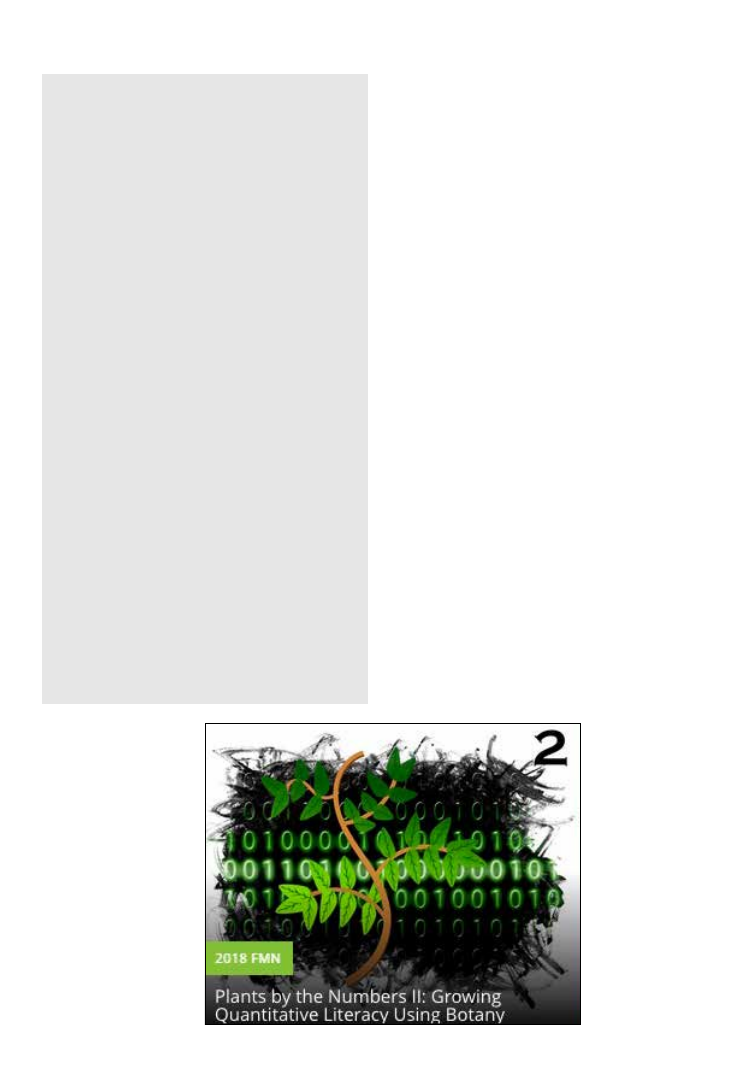
PSB 64 (3) 2018
190
Upcoming Education
Conferences
Life Discovery – Doing Science Education
Conference, March 21-23, 2019:
Microbiomes to Ecosystems: Evolution and
Biodiversity across Scale, Space, and Time
BSA co-sponsors the Life Discovery – Doing
Science Education Conference, a stand-
alone education conference for high school
and undergraduate biology educators. This
is an interactive conference with many
opportunities to network and share ideas with
colleagues interested in biology education. The
call for proposals for Education Roundtables
is still open, so please consider joining us in
Gainesville, Florida!
For more information and to see the request for
proposals, please visit: http://www.esa.org/ldc.
What is a QUBES Faculty
Mentoring Network?
Imagine meeting biweekly over a semester
with a small group of educators around a
common interest—exploring new ideas
or classroom activities, sharing what has
worked and what hasn’t, and gaining some
credit for your teaching scholarship. That is
the Faculty Mentoring Network model.
Faculty Mentoring Networks (FMNs) are
designed to fit into the busy schedules
of college faculty, and provide support
and guidance “just in time” during the
implementation of course changes.
By capitalizing on the experience of a
mentor and peers, FMNs provide a bridge
between pedagogical theory and actionable
classroom practice.
A second Plants by the Numbers Faculty
Mentoring Network kicks off this fall
on QUBEShub.org with a new cohort of
interested faculty.
You can view new and upcoming FMN
opportunities here: https://qubeshub.org/
community/fmns#new.

191
STUDENT SECTION
By Chelsea Pretz and Min Ya
BSA Student Representatives
Scientific societies have been an integral part
in moving science forward. For example,
letters as early as the 17th century between
prominent scientists created what was
considered an “invisible college,” connecting
inquisitive minds throughout Europe. Shortly
after that, this “invisible college” became the
Royal Society. This is just one society that has
connected scientists with a common space
to share ideas. Scientific societies may have
changed over time, but one thing has remained
the same: they are a beneficial resource for its
members.
Botanical Society of America has been a
society since 1893, and since then, there have
been many changes within the field. In general,
botany departments have decreased in size in
the past years or are now non-existent. The
field of botany has expanded and much of the
approaches are now molecular—an important
reason to have a large scale “university” to
share ideas and current research. BSA’s goal
is to stay relevant in this changing scientific
environment and reflect the processes in the
current society. In this upcoming year, BSA
has expanded the amount of money that will
be given to graduate research, from $500
to $2000. Although this will decrease the
number of people who will receive the grants,
it will increase the research impact of those
recipients. This increase will allow students to
fund not just a part of the collection trip, but
the whole thing, or at least some preliminary
sequence data. While societies help promote
research by providing funds, it is also a place
for networking, setting up collaborations,
and sharing research progress. As budding
researchers, the BSA’s annual BOTANY
conference is a place for students to share
their ideas and get feedback to improve their
research, as the support is set up to be an
inclusive environment for everyone and their
ideas.
BSA has made inclusivity a priority over
the past few years. This past year was the
PLANTS Program’s eighth year, the third
annual LGBQT Mixer, and the second annual
Why Do Scientific Societies Matter?
How, As a Student,
Can I Benefit from Them?
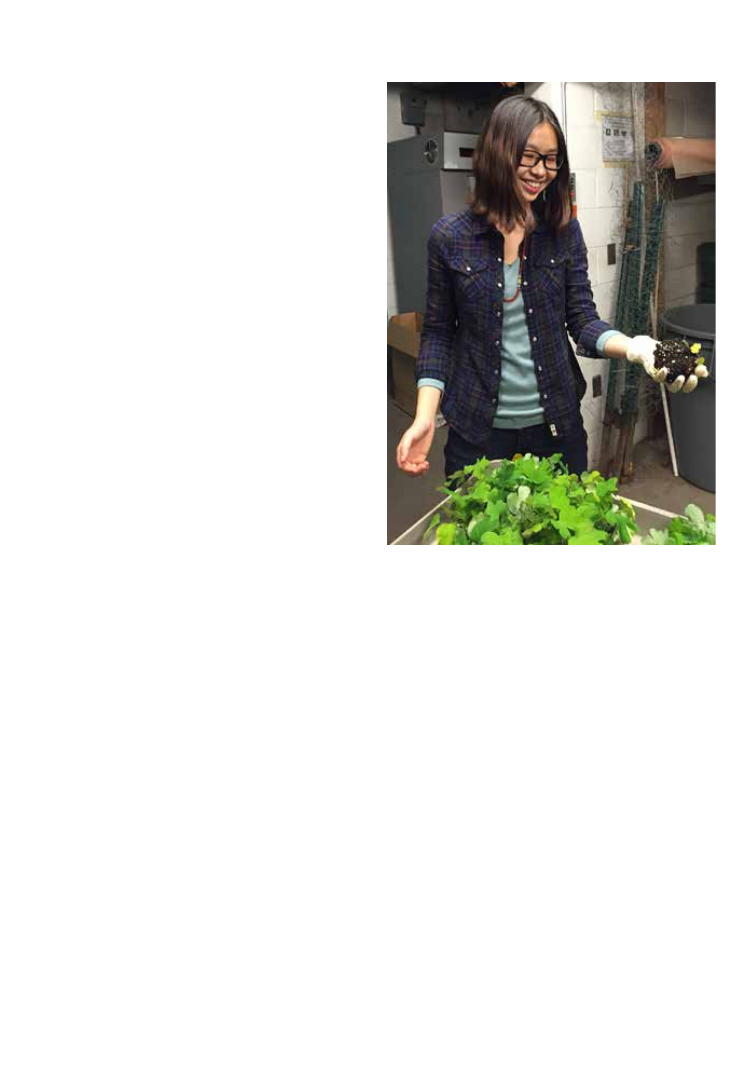
PSB 64 (3) 2018
192
Undergraduate Mixer at BOTANY. This past
year, BSA made it a priority to update its code
of conduct. In light of the #MeToo movement,
it is important to make sure the everyone is
welcomed and feels safe to conduct research
and contribute to the field of botany. Although
there has been growth in the society, more
needs to be done; as a student member, you
can make that difference!
Students are encouraged to get engaged in the
society. Every BSA committee—whether for
grants, investments, education, development,
and more—is required to have a student
representative on it. Holding this position
is not just a good life experience, but also a
chance to shape BSA in away that is beneficial
in these changing times. To find out more
about BSA benefits, go to https://botany.
org/home/membership/member-benefits.
html.
Getting to Know your New
Student Representative,
Min Ya
When did you join BSA and what motivated
you to do so?
I became a student member of BSA in
2015. I was just starting graduate school
that summer and was trying to navigate
through all the professional organizations
and societies to decide which ones I should
join. Very soon, I was overwhelmed by the
number of societies there are that seemed to
be related to my field, so I turned to my PI
Elena Kramer for recommendation. BSA was
the very first society that Elena recommended
to me, and she also kindly offered me a gift
membership. Very quickly, I became a big
Min Ya, Kramer Lab, Department of Organis-
mic and Evolutionary Biology, Harvard Uni-
versity
fan of BSA. For example, botany.org became
a “dictionary” to me, and I can’t remember
how many times I have visited the website
to look for information regarding careers in
plant sciences, outreach in plant sciences,
funding opportunities, trainings, or just
random fun facts about weird plants. During
my first botany conference, BOTANY 2016, I
was also so pleasantly surprised that anyone
who wanted to give a talk could indeed give
a talk and appreciated this fact a lot as there
aren’t many opportunities for junior graduate
students and undergrads to present in the same
session with very experienced professors. I
met so many interesting people, learnt so
much about different fields of plant sciences,

PSB 64 (3) 2018
193
got endless inspiration about my work and
career, and visited so many awesome places
during BOTANY conferences—it became
something I’m really looking forward to every
summer.
What motivated you to run for the position
of Student Representative to the Board of
Directors?
A number of reasons motivated me to run for
the position. Firstly, I was very fortunate and
was awarded a number of research awards and
travel awards by BSA, which was extremely
encouraging to me as a young scientist. I would
love to make my own effort to help the society
to grow and glow and help more students to
have positive experiences like mine with BSA.
Secondly, former student rep Becky Povilus,
a very close friend and a role model of mine,
very patiently explained to me the duties and
expectations of student reps of BSA, and I
made sure to know what I might be facing
and something I could contribute to before
I decided to run for the position. Thirdly,
since my undergrad, I have lived and studied
in China, Japan, Sweden, Germany, France,
and the United States, and I am hopeful that
my international experience could bring
something new to BSA if I became a student
rep. Particularly, I have experienced many
struggles that any international student would
have, and
I believe my personal experiences
will help me to communicate and connect
well with all the non-U.S. members of the BSA
community, and hopefully also building up
(both academic and non-academic) resources
in the society that international members
can refer to. On the other hand, now it’s the
fourth year for me living in the States, and I
hope my experiences and perspectives will
help the society to expand outside of the
United States and establish more international
collaborations.
Lastly, I am a hopeless plant
lover and plant blindness is something that
really drives me crazy. Becoming a student
rep of BSA will be the very first step for me
to learn and strategize how to cure plant
blindness outside of our communities.
What is your research about?
Meristem, meristem, meristem—the
foundation of plant development and the
thing that makes plants so different from
others. I love everything about plant evo-
devo, but I really have a soft spot for anything
related to meristems. Using the beautiful
Columbine flowers (Aquilegia), I’m exploring
one important aspect regarding meristem
during my graduate school: How is the natural
variation in floral meristem proliferation
controlled at the evolutionary level? Unlike
the vegetative meristem, floral meristems are
always determinant—the stem cell activity will
be shut down at a specific time point during
primordium initiation, and that’s why every
flower only makes a finite number of floral
organs. Floral meristems of some flowers
proliferate for a long time, so that many whorls
of floral organs are made in a flower, but floral
meristems of some flowers only proliferate
for a very short period, resulting in very few
whorls of floral organs. This difference in the
timing of floral meristem termination lays the
foundation of a large part of floral diversity we
see in nature, but we have very little idea of
how it is controlled both developmentally and
evolutionarily.
Aquilegia is a very good model for tackling
this question as it already has a sequenced
and annotated genome and established
functional tools, and different species have a
high degree of interfertility and their flowers
have identical numbers of all floral organs
except for stamens. Therefore, the variation in
the duration of floral meristem proliferation

PSB 64 (3) 2018
194
can be well represented by the variation of
stamen whorl numbers.
I’m absolutely in
love with my research and feel very grateful
for the fact that it’s a nice integration of
molecular lab work, computational analysis,
histology and microscopy, and morphological
characterization. It allows me to spend a lot of
time with my plants, documenting their details
at all levels, from macroscopic to microscopic.
What sorts of hobbies do you have?
I like hiking and kayaking, and spending time
with plants (literally). I like drawing, mostly
watercolor of plants (no, there’s no such thing
as too much plants). I love traveling and I’m
flying between Asia, Europe and America
very often. I like learning languages, and I
used to make subtitles for Japanese animes.
Music is also a big part of my life. I go to a
lot of concerts (and Boston is a great place
for concerts), most often hardcore metal and
heavy metal bands, and underground local
bands. I have been playing piano since I was 5
years old, and I still practice religiously every
week—especially after a hard day of work,
nothing comforts me more than putting my
fingers on piano keys.
Building an Intentionally
Inclusive Community
One of our main goals moving forward is to
focus on building an intentionally inclusive
community for student members of the BSA.
If you have any questions, concerns, sugges-
tions, or comments about how we can make
a more inclusive community, please reach
out to either Chelsea Pretz (chelsea.pretz@
colorado.edu) or Min Ya (yamin@g.harvard.
edu)—or use our new BSA Student Represen-
tative e-mail: bsastudent@botany.org. Follow
us on Twitter at @Botanical_!
Quick notes on the
BOTANY 2018 conference
We would like to extend a thank you to every-
one who attended BOTANY 2018 in Roches-
ter, Minnesota! From our perspective, the con-
ference was filled with great workshops and
mixers geared toward the student membership
of the society as well as great talks given by
students, faculty, and alumni. More impor-
tantly, approximately 30% of the conference
attendees were students—a number that has
gradually increased throughout BSA’s history.
During our “Careers in Botany” Student Lun-
cheon, we were inspired by Susan Pell that
there are many different paths in botany. We
also had a two wonderfully executed work-
shops! During the Job Search Transparency:
Learning the Unwritten Rules to Land your
Dream Job, panelists Rob Labort, Jason Cant-
ley, Allison Miller, and Ya Yang enlightened
us with advice such as on how to be prepared
for the next stages in life. Amanda Grusz led
a group of students on the workshop The El-
evator Speech: Crafting an Effective Pitch
that Highlights your Research and Illustrates
the Broader Impacts. This explored how to
catch people’s attention in just a short period.
Overall, our student-oriented events were a
success, and we loved having the opportunity
to meet everyone at the student mixer, which
was hosted at the Grand Rounds in downtown
Rochester. We look forward to seeing all of
you again, or getting to know you for the first
time, at BOTANY 2019 in Tucson, Arizona,
July 27-31!
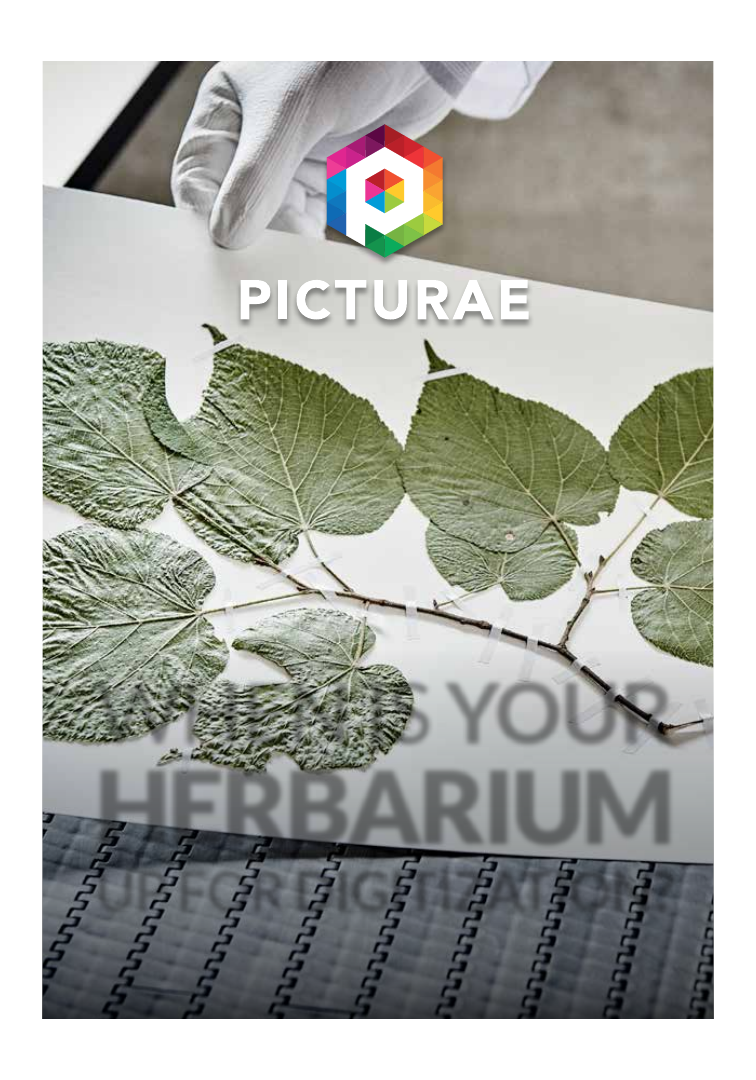
www.digitalherbarium.com
WHEN IS YOUR
HERBARIUM
UP FOR DIGITIZATION?
picturae-herbarium-7x9.indd 1
18/06/2018 09:04
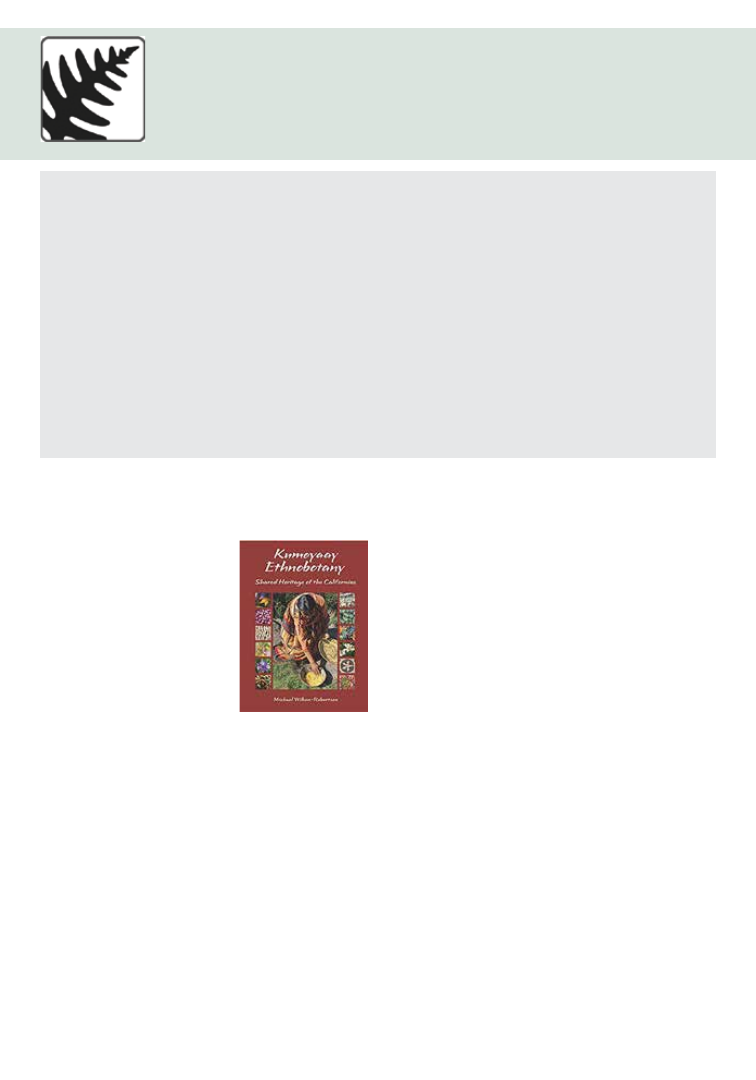
196
BOOK REVIEWS
Economic Botany
Kumeyaay Ethnobotany Shared Heritage of the Californias ........................................................196
American Eden: David Hosack, Botany, and Medicine in the Garden
of the Early Republic ..............................................................................................................................................197
Rhododendron ..........................................................................................................................................................198
Sunflowers ...................................................................................................................................................................199
Physiological
Gravitational Biology I: Gravity Sensing and Graviorientation in
Microorganisms and Plants ................................................................................................................................201
Systematics
The Plants of Jordan: an Annotated Checklist .....................................................................................204
Kumeyaay Ethnobotany:
Shared Heritage of the
Californias
Michael Wilken-Robertson
2018.
ISBN: 978-1-94138-430-5
Softcover, US$29.95. 282 pp. +
xxix
Sunbelt Publications, Inc.,
Rancho La Puerta.
The Kumeyaay are Native Americans living
on both sides of the United States–Mexican
border in Baja California. The author is
an anthropologist, so the reader has the
advantage of an anthropological insight into
the Kumeyaay way of life. This is a region where
the culture and plant uses of the indigenous
people are being eroded by development.
Thankfully, this book documents the uses of
plants and how they are prepared.
Following the introductory chapters dealing
with prehistory, contemporary landscapes,
language, and methods, the botanical heart of
the book discusses 47 plants and their utility.
These are all well illustrated with clear full-
color images showing diagnostic features of
the plants as well as stages in the preparation
of foods, fibers, dyes, medicines, arrows, and
construction materials.
Like the rest of the book, species treatments are
well written and detailed enough to repeat the
processes of food, dye, and basket preparation.
I am interested in the use of acorns for food, so
I appreciated the unit dealing with coast live
oak (Quercus agrifolia). After the oak seeds
are ground in the querns carved in boulders,
the resultant meal is boiled and strained. This
is added to meat dishes or eaten on its own
as a gruel. The leftover matter solidifies in a
kind of gel that resembles mok, the traditional
Korean delicacy made from Q. dentata.
Another fascinating food is derived indirectly
from the chaparral ash, Fraxinus parryi. The
army worm (a caterpillar from the family
ECONOMIC BOTANY

PSB 64 (3) 2018
197
Noctuidae) is eaten and prepared like the
mopane worm (Gonimbrasia belina) that is so
widespread in southern Africa. The mopane
worm feeds mainly on Colophospermum
mopane. In both cases the caterpillar is
eviscerated by squeezing, then dried.
Less interesting but with more gustatory
appeal are species of cherries and a lengthy
section of agave. For a book dealing with
ethnobotany, one could wish for more specific
identifications than Salix spp. and Quercus
spp.
This well-produced book ends on challenging
but encouraging chapters with the author’s
reflections, a discussion of sustainability, and
developing public interest in the culture and its
ethnobotany. One can’t help but wonder how
many other cultures and their ethnobotany
would benefit from a book like this.
-Lytton John Musselman, Department of
Biological Sciences, Old Dominion University,
Norfolk, Virginia 23529-0266
American Eden: David
Hosack, Botany, and
Medicine in the Garden
of the Early Republic
Victoria Johnson
2018.
ISBN-13: 978-1-63149-419-2
Hardcover; US $29.95. 480 pp.
Liveright Publishing Corporation, New York, NY, USA
The cast and characters of early U. S. history
have recently regained fame associated with
the success of the hit musical Hamilton. One
plotline not featured on Broadway is that
of David Hosack, a prominent doctor and
botanist in New York City during this period,
and his struggles to create the first botanical
garden in America. In American Eden: David
Hosack, Botany, and Medicine in the Garden
of the Early Republic, Victoria Johnson, Ph.D.
in sociology and associate professor in urban
policy and planning at Hunter College, paints
a dynamic picture of the social, political,
economic, and personal threads that tied
Hosack’s botanical quest to the early history
of the nation.
This historical work tells the tale of Hosack as
an individual in the context of the scientific and
political scene in which he was entrenched.
Hosack was born before the Revolutionary
War but came of age as the nation did. Johnson
details his early life, education, professional
and civic engagements, and medical and
scientific journey. Inspired by medicine and
the use of plants in contemporary remedies
and their utility as a teaching tool, he sought
to establish America’s first botanical garden,
the Elgin Botanic Garden, in New York City
where the Rockefeller Center now sits.
The book is structured around the timeline of
Hosack’s life while providing insights into the
cultural, economic, and political background
that both drove and hindered his progress.
Johnson draws upon primary resources
from Hosack, his contemporaries, family,
and friends, many of whom are recognizable
as prominent figures during that time. She
details his educational journey both home and
abroad, where he mingled with prominent
British scientists, and his return to New York
where he established his medical practice.
Hosack made numerous contributions to
medicine, but perhaps his most famed act as
a doctor was treating Alexander Hamilton
after the duel with Aaron Burr. In addition
to his profession as an attending physician,
he held professorships in botany, natural
history, midwifery, and surgery, a breadth
of accomplishments and titles near unheard
of today. Hosack’s desire to establish his
botanical garden continued to be a driving
force for many years, through times of peace
and war, personal and political strife, and
financial distress and luxury. Although this

PSB 64 (3) 2018
198
in. Those with a penchant for either of these
themes, as well as medicine and the arts and
sciences more broadly, will find pieces to
relish in this book!
-Nora Mitchell, Department of Biology, Uni-
versity of New Mexico, Albuquerque, New
Mexico, USA
Rhododendron
Richard Milne
2017.
ISBN: 978-1-78023-815-9
Hardcover, £16.00. 236 pp,
Reaktion Books Ltd.,
London
It’s timely to be reading
Richard Milne’s Rhododendron while enjoying
the peak flowering season for azaleas and
rhododendrons in New York City. Milne, an
evolutionary biologist and environmentalist
at University of Edinburgh, presents an
utterly charming adventure story that surveys
the many ways by which rhododendrons
have influenced human cultures, as well as
their diversity and evolution. Milne’s writing
is easily read, sprinkled with dry humor, as
exemplified by these imaginative chapter
titles.
“Sex and the Single Rhododendron” explores
the promiscuous behavior of rhododendrons
because each of the 1000 species can cross with
many other rhododendron species. Milne
personifies their toxic dark side in the role
of “femme fatale” and with links to departed
souls and cuckoos.
“The Fall and Rise of Azalea” follows
the constantly changing classification of
rhododendrons and azaleas. Milne emphasizes
the important point that taxonomy is opinion,
amenable to disagreement. Recent results of
investigations with DNA enable scientists to
path meanders and may not be as climactic as
a fictional story, the reader will be drawn to
Hosack and his persistence.
The botanical focus is a uniting thread
throughout this book. Among the primary
resources and catalogs that Johnson weaves
into a storyline are mentions of innumerable
plant species, both North American and
exotic, as sources of medicine, collection,
and overall fascination. The botanist will
delight in the writings of prominent political
figures that mention species by both common
and scientific name. Hosack even had loose
ties to Lewis and Clark; the reader can only
imagine how exciting the discovery (to those
of European descent) of a whole continent of
plants must have been!
Throughout the book there are themes
recognizable and relevant to science and
society today. These include Hosack’s struggles
to obtain funding for his garden, both from
government and private sources, and the
difficulties he encountered in justifying
botanical science and its uses to the public
and medical community. Hosack also had
numerous international collaborations, not
only receiving part of his education abroad,
but also hosting visiting scholars from Europe
and exchanging seed collections with people
from all over the world to boost his collection
of exotic plants. He even proposed an early
citizen science effort for the collection of local
plants through the New-York State Society
for the Promotion of Agriculture, Arts, and
Manufactures, although his attempt was
unsuccessful.
Overall, Johnson presents an engaging and
well-written insight into a little-known, yet
highly influential, doctor and botanist of early
America. This book reads like a story, but
with rich details focusing on the historical
and botanical context that Hosack worked

PSB 64 (3) 2018
199
follow rhododendron evolution, even assisting
scientists to understand continental drift.
“Rhododendromania” reveals the history of
how botanists, merchants, missionaries, and
other early explorers became plant collectors,
trying to satisfy the tastes of sponsors who
were eager to obtain novel plants, especially
rhododendrons.
“Glasshouse Sensations” demonstrates how
the beauty of the approximately 250 species
of tropical rhododendrons, the Vireyas,
led to an intense interest in greenhouse
rhododendrons. Spice merchants brought
back Vireya rhododendrons that captured the
attention of nurseries. The development of the
Wardian case, an early version of a terrarium,
enabled merchants and botanists to transport
live plants.
“Home of the Rhododendrons” investigates
the extensive knowledge and appreciation of
rhododendrons in China. Once China opened
its borders to traders in the mid-18
th
century,
explorers, missionaries, and merchants arrived
in China, steadily discovering new species.
Plant collectors became intent on bringing
back seed for their sponsors in Europe and
North America. Explorers have also found
fossil records that provide a timeline to the
evolution of rhododendrons. Botanists have
matched fossil evidence with DNA studies
to follow the evolution and migration of
rhododendrons over millennia. Once Mao
assumed power, foreign exploration closed
until botanists in the West were able to open
collaborations with Chinese botanists, leading
to joint plant exploration by Western and
Chinese botanists that continues today.
“Potions, Petals and Poisons” depicts the
toxicity of rhododendrons from antiquity
to present, involving poisoning livestock;
eliminating bedbugs, mice, fleas, and lice;
irritating eyes if burned; and intoxicating
humans—its narcotic honey was even used
in warfare. Rhododendrons were an herbal
remedy, now confirmed by modern medicine.
Prior to the Reformation, gruit ales were made
with R. tomentosum and R. groenlandicum for
their intoxicating effects, a practice banned
entirely in Germany in 1855.
“The Tears of the Cuckoo” follows the impact
of rhododendrons on culture. This is especially
true in southwest China, where the Yi people
hold the Torch Festival, offering rhododendron
flowers to their Flower God. Every year, at the
height of the rhododendron flowering season,
these minority peoples will wear festive
costumes, light a fire, sing and dance, and
warmly welcome guests. Milne enumerates
Chinese folktales linking rhododendron with
tragedy and death. Chinese legends describe
a tragic figure that turns into a cuckoo, whose
song recalls its tragic life, and whose mouth
spills blood, which emerges as rhododendrons.
“Black Sheep: The Tale of Rhododendron
ponticum“ is a high point of the book. R.
ponticum has run wild across the British
countryside; it easily establishes itself in areas
where the soil is disturbed. Today, R. ponticum
is an even greater problem since it is a carrier
of Phytophthera ramorum, sudden oak death.
The negative economic and ecological impact
has led to controversial efforts to eradicate R.
ponticum.
“Conservation, Collections and the
Future” examines the ecological status of
rhododendrons and forecasts their potential
future plight. Increasingly, when botanical
explorers return to previously collected
locations, rhododendron species are no longer
found. Rhododendrons are being cleared to
make room for agricultural development.
Not only are known species disappearing, but
many species that had not yet been discovered
are believed to be destroyed as well. The

PSB 64 (3) 2018
200
effort of plant collectors to bring these
species to other parts of the world for study
provides a safety net for select species but
eliminates natural evolution that could occur
in the wild. Fortunately, the habitat of some
rhododendrons is in areas where agricultural
development is not practical. Milne stresses
that today, “rules restrict collection” and closes
with cautionary comments about climate
change—of major significance to Milne—
concluding: “The future of rhododendrons, as
with so much else, is in our hands.”
Rhododendron is the eighteenth volume
in Reaktion’s superb series devoted to
“integrating horticultural and botanical
writing with a broader account of the cultural
and social impact of trees, plants and flowers.”
Compared with Tulip, another volume from
this series (see review on page 85 of the Fall
2017 issue of Plant Science Bulletin (63(3)),
this coverage displays depth and originality;
it will delight botanists, gardeners, and
history buffs. Following standard design for
this Reaktion series, the book is well-bound
with stitched pages; printed on high-quality
paper stock; offers 70 color plates, 30 halftone
color illustrations, a timeline, table of groups
within Rhododendron, a short list of further
reading, a list of associations and websites,
acknowledgments and meticulous photo
acknowledgments, a 7-page index, and floral
end papers, here in eye-catching seafoam
green. Rhododendron is a thoughtful and well-
researched book based on Milne’s extensive
study of the genus, evident from the 24 pages
of references accompanying the chapters.
Milne’s writing is clear, his arguments amply
documented, and his style thoroughly
captivating.
–Dorothea Bedigian, Research Associate, Missou-
ri Botanical Garden, St. Louis, Missouri, USA
Sunflowers
Stephen A. Harris
2018.
ISBN: 978-1-78023-926-2
Hardcover; US$27.00. 256 pp.
Reaktion Books, London, U.K.
Two images of sunflowers
come to mind. First, large fields of giant
flowers in western Kansas—although this
scene repeats itself in many states of the upper
Midwest in the summer. These fields are
impressive because all the heads of the flowers
face the same way due to solar tracking.
Sunflowers are one of several plant species
that exhibit this behavior by turning to face
the sun, and these movements are also termed
heliotropism, a complex response to daily
environmental cycles (Vandenbrink et al.,
2014). Although this phenomenon has been
well known for a long time, many questions
about the precise mechanisms remain
unanswered.
My second thought about sunflowers is the
tremendous circumnutation, or helical organ
movement, that occurs in young seedlings
(Kiss, 2006). One of the first scientists to
characterize circumnutation is Charles
Darwin in his monograph Power of Movement
in Plants (Darwin and Darwin, 1880). These
dramatic movements can be easily captured
in time lapse photography (for example, see
http://circumnutation.umcs.lublin.pl/en.html
and https://youtu.be/eKo5F87A8a0).
This book, written for the general reader, is
part of a series that integrates botanical work
into a broader social and historical context.
All books in the series have a single word title
(e.g., apple, cactus, oak, etc.) as well as chapter
titles that are single words.

PSB 64 (3) 2018
201
Chapter One in Sunflowers is titled “Amazing”
and gives a broad introduction to this
fascinating plant group. Although the focus is
on sunflowers (Helianthus annuus), the book
considers the larger group of the Asteraceae
family. The author, Stephen Harris, is the Druce
Curator of the Oxford University Herbaria
and a research lecturer in the Department of
Plant Sciences at Oxford.
Harris considers the controversies around the
mechanisms of circumnutation, namely that
the theory proposed by Darwin and Darwin
in 1880 (that circumnutation had an internal
driving force in plants) has been questioned
by scientists performing recent spaceflight
experiments. However, the author does not
discuss the most up-to-date work on the
mechanisms of solar tracking in sunflowers.
In the chapter on “Surviving,” Harris considers
how various members of the Asteraceae have
adopted and survived in hostile environments
such as those found in high altitudes. Other
stressful locales considered are arid areas
with significant water stress and fire-prone
ecosystems.
In “Curing,” the medical properties of this
plant group are outlined, and in “Feeding”
the food and culinary value of sunflowers
are discussed. The chapter on “Profiting”
continues this theme and expands it to the
economic value of sunflowers and its relatives.
Helianthus annuus is one of the few crops to
have been domesticated in North America
(about 5000 years ago). Sunflower seeds and
commercial oilseeds have economic relevance,
and their histories as an oil crop in Europe,
Russia, and the United States are chronicled.
The book is beautifully illustrated with many
images of sunflowers and other Asteraceae
in natural settings along with herbarium
photographs. The broader culture is
considered with images such as paintings by
Vincent van Gogh and photos of sunflowers
on stamps throughout the world. This book
is reasonably priced and will be enjoyed by
professional and amateur botanists as well
as by horticulturalists. In summary: a very
enjoyable read.
Literature Cited
Darwin, C., and F. Darwin. 1880. The Power
of Movement in Plants. John Murray Publishers,
London.
Kiss, J. Z. 2006. Up, down, and all around: how
plants sense and respond to environmental stim-
uli. Proceedings of the National Academy of Sci-
ences (USA) 103: 829-830.
Vandenbrink, J. P., E. A. Brown, S. L. Harmer, and
B. K. Blackman. 2014. Turning heads: the biol-
ogy of solar tracking in sunflower. Plant Science
224: 20-26.
-John Z. Kiss, Department of Biology,
UNC-Greensboro, Greensboro NC 27402
PHYSIOLOGY
Gravitational Biology
I: Gravity Sensing
and Graviorientation
in Microorganisms
and Plants (Springer
Briefs in Space Life
Sciences)
Markus Braun, Maik Böh-
mer, Donat-Peter Häder,
Ruth Hemmersbach, and Klaus Palme
2018. ISBN-13: 978-3-31993-893-6
Paperback, US $69.99; 122 pages
Springer
Due to their stationary nature, plants have
evolved mechanisms that help them to adapt
to changes in their surrounding environment.

PSB 64 (3) 2018
202
Tropisms, directed growth movements in
response to external stimuli, help ensure the
survival of the plant (Vandenbrink et al.,
2014). Gravitropism, which is the directed
growth of plants in response to the gravity
vector, is one of the most important factors in
plant development. In addition, since gravity
has been ubiquitous and unchanging on Earth,
the ability to sense and respond to gravity has
been key throughout evolutionary history.
This book provides eight chapters that serve as
review articles on the topics of gravity sensing
and response in plants and microorganisms.
Thus, in addition to gravitropism in plants,
the topic of gravitaxis, or movement of
unicellular organisms in response to gravity,
is also considered. Typically, but not always,
gravitaxis occurs in the form of swimming in
a water column. Most of the chapters provide
an up-to-date literature review (i.e., references
current to 2017 or 2018).
The authors are experts in the fields of space
biology, plant gravitropism, and gravitaxis
research in microorganisms. Interestingly,
they all work in Germany and are associated
with the German space agency, the
DLR (Deutsches Zentrum für Luft- und
Raumfahrt). In some ways, although the
authors clearly have significant expertise, it
may have been desirable to have some experts
from outside of Germany.
The first chapter provides an overview and
offers some important definitions of the
major terms in these fields of gravitational
research. The second chapter considers
important tools in gravitational biology
including microgravity and microgravity
simulators. The gravity effects on objects
are reduced or eliminated during the state of
“free fall” or microgravity. Methods to achieve
microgravity include the use of drop towers,
parabolic flights of airplanes, sounding
rockets, and, of course, orbiting space vehicles
such as the International Space Station. In
addition to true microgravity, biologists have
developed methods to simulate microgravity
by using devices such as clinostats and random
positioning machines (see also Brungs et al.,
2016).
This second chapter also considers the
importance of investigations in reduced
gravity. There have been numerous studies
on plant growth and development in the
microgravity environment of low Earth orbit
since the beginning of human spaceflight
(Vandenbrink and Kiss, 2016). In contrast,
we know little about plant behavior in reduced
(sometimes termed fractional) gravity
environments (less than the nominal 1g that
occurs on Earth). Since international space
agencies have cited human exploration of the
moon/Mars as long-term goals, it is important
to understand plant biology at the lunar
(0.17g) and Martian levels of gravity (0.38g) as
plants are likely to be part of bioregenerative
life support systems on these missions (Kiss,
2014).
The third chapter focuses on gravitaxis in
ciliates and flagellates. Much of the interesting
working on gravity thresholds has been
performed with the alga Euglena, both in
space and on the ground. The authors of this
chapter also report on work that is relevant for
understanding biology at the reduced gravity
levels that were considered in more detail in
the previous chapter.
Tip growing unicellular system of rhizoids
of the alga Chara is the subject of Chapter
4. Chara rhizoids have been used in many
spaceflight experiments and related ground
research to study gravity sensing and signal
transduction. The figures in this chapter
are particularly useful to understanding the
concepts in terms of the role of the cytoskeleton
in gravitropism pathways. In addition, the use
of microgravity to unravel signaling pathways

PSB 64 (3) 2018
203
is clearly delineated and summarized.
Chapter 5 considers gravitropism in fungi,
mosses, and ferns, but it is short and not
very comprehensive. There are far better
recent reviews of these interesting topics (e.g.,
Corrochano and Galland, 2016).
The next two chapters (6 and 7) focus on the
cellular and molecular aspects of gravitropism,
respectively. In some ways, these components
overlap, and this distinction is somewhat
arbitrary. The diagrams in Chapter 6 are
particularly helpful in terms of summarizing
the knowledge about the cell biology and
physiology of tropisms. Topics covered
include the starch-statolith hypothesis, the
role of actin in sensing and response, and
secondary messenger molecules. Given
its central role in asymmetrical gravitropic
growth, the physiology and transport of auxin
are analyzed. The topic of auxin biology and
transport is further considered in Chapter 7
as well the relationship between auxin and
other plant growth regulators. In Chapter
7, the author also discusses the effects of
microgravity and altered gravity on the plant
transciptome but misses some recent articles
on this important, emerging topic (e.g., Kwon
et al., 2015).
The last chapter focuses on bioregenerative
life support systems in space research. This
short chapter provides a limited introduction
to this interesting area that will be important
for long-range space travel.
Overall, I found this volume to be a well-written
introduction to the topics of gravitropism,
gravitaxis, and plant space biology. The book
is recommended for new graduate students
in the field of gravitational and space biology
of plants and will provide a great overview to
this group. I can also imagine this collection
of review articles to be a useful supplement
in an advanced plant physiology or plant
developmental biology class.
Literature Cited
Brungs, S., M. Egli, S. L. Wuest, P. C. Christianen,
J. J. Van Loon, T. J. Anh, R. Hemmersbach. 2016.
Facilities for simulation of microgravity in the
ESA ground-based facility programme. Micro-
gravity Science and Technology 28: 191-203.
Corrochano, L. M. and P. Galland. 2016. Pho-
tomorphogenesis and gravitropism in fungi. In:
Wendland J. (ed.) Growth, Differentiation and
Sexuality. The Mycota, vol I. (Third Edition)
Springer, Heidelberg.
Kiss, J. Z. 2014. Plant biology in reduced gravi-
ty on the Moon and Mars. Plant Biology 16(S1):
12–17.
Kwon, T., J. A. Sparks, J. Nakashima, S. N. Allen,
Y. Tang, and E. B. Blancaflor. 2015. Transcrip-
tional response of Arabidopsis seedlings during
spaceflight reveals peroxidase and cell wall re-
modeling genes associated with root hair devel-
opment. American Journal of Botany 102: 21-35.
Vandenbrink, J. P. and J. Z. Kiss. 2016. Space, the
final frontier: a critical review of recent experi-
ments performed in microgravity. Plant Science
243: 115–119.
Vandenbrink, J. P., J. Z. Kiss, R. Herranz, and F.
J. Medina. 2014. Light and gravity signals syner-
gize in modulating plant development. Frontiers
in Plant Science 5: 563.
-John Z. Kiss, Department of Biology,
UNC-Greensboro, Greensboro NC 27402

PSB 64 (3) 2018
204
SYSTEMATICS
The Plants of
Jordan: An Annotated
Checklist
Hatem Taifour and Ahmed
El-Oqlah (edited by Shahi-
na A. Ghazanfar)
2017. ISBN 978-1-84246-
641-4
Paperback, US $57.38. 162
pp. + x
Royal Botanic Gardens,
Kew
The flora of the Levant has been intensively
studied for many years beginning with
the ground-breaking 1896 flora of George
Edward Post (Musselman, 2006). Plants of
Jordan follows that tradition of quality and
rigor established by Post. His research is still
relevant. In fact, the authors of the present
work include a survey of his material hosted
at the Post Herbarium of the American
University of Beirut.
Having taught plant identification at the
University of Jordan, I may be prejudiced in
my enthusiasm for this publication. The book
draws upon the extensive floristic research
of Daoud Al-Eisawi, personnel of the Royal
Society for the Conservation of Nature, as
well as the authors’ and editor’s work. This is a
collaborative effort between the Royal Botanic
Garden of Jordan and Royal Botanic Gardens,
Kew.
It is edited by Kew botanist Shahina Ghazanfar,
herself an expert on Middle East floristics; her
editing skill is evident. After a foreword by
one of the Jordanian royal family, there are
concise and informative sections on floristics,
vegetation types, and biogeography. Floristic
data were garnered from regional herbaria
and databases as well as fieldwork.
The bulk of the book, of course, is the
annotated checklist, which helpfully follows
the family delineations of the Angiosperm
Phylogeny Group. Nomenclature and
synonymy are included along with occasional
notes. There is little or no distribution data
and location information varies wildly in
detail. For example, some entries simply cite
publications, some refer to databases, and
some are as detailed as “500 m after first turn
to Al Ketteh village.” While this approach
documents occurrence, it could confuse
anyone interested in distribution of plants.
Nerium oleander, for example, is documented
from the Irbid area (in the extreme north of the
country) but is common in wadis throughout
much of Jordan. A detailed bibliography
including non-archival material concludes the
book.
The size of the well-bound book (6 × 0.6 ×
9.2 inches [15.24 × 0.15 × 23.39 cm) makes it
well-suited for field use.
If I were to teach plant identification again in
Jordan, this would be the textbook. The Plants
of Jordan is an essential resource for anyone
with an interest in the flora Jordan or Middle
East and a good example of a modern checklist.
The publication of this long-awaited work will
further the objectives of the collaborators, the
Royal Botanic Garden of Jordan, and Kew to
raise awareness of a threatened flora and the
need for conservation.
Literature Cited
Musselman, L. J. 2006. The botanical activities
of George Edward Post (1838-1909). Archives of
Natural History 33(2): 282-301.
-Lytton John Musselman, Department of
Biological Sciences, Old Dominion University,
Norfolk, VA 23529-0266

The only instrument in the
world that uses Rapid Sensing
™
Technology for fast A-C
i
curves
and survey measurements.
www.licor.com/6800
LI-6800 Portable
Photosynthesis System
Stinziano JR, Morgan PB, Lynch DJ, Saathoff
AJ, McDermitt DK, and Hanson DT. (2017)
The rapid A-C
i
response: photosynthesis in
the phenomic era. Plant, Cell & Environment,
40:1256-1262. doi: 10.1111/pce.12911
See the open access
Rapid A-C
i
Response
(RACiR
™
) Method paper
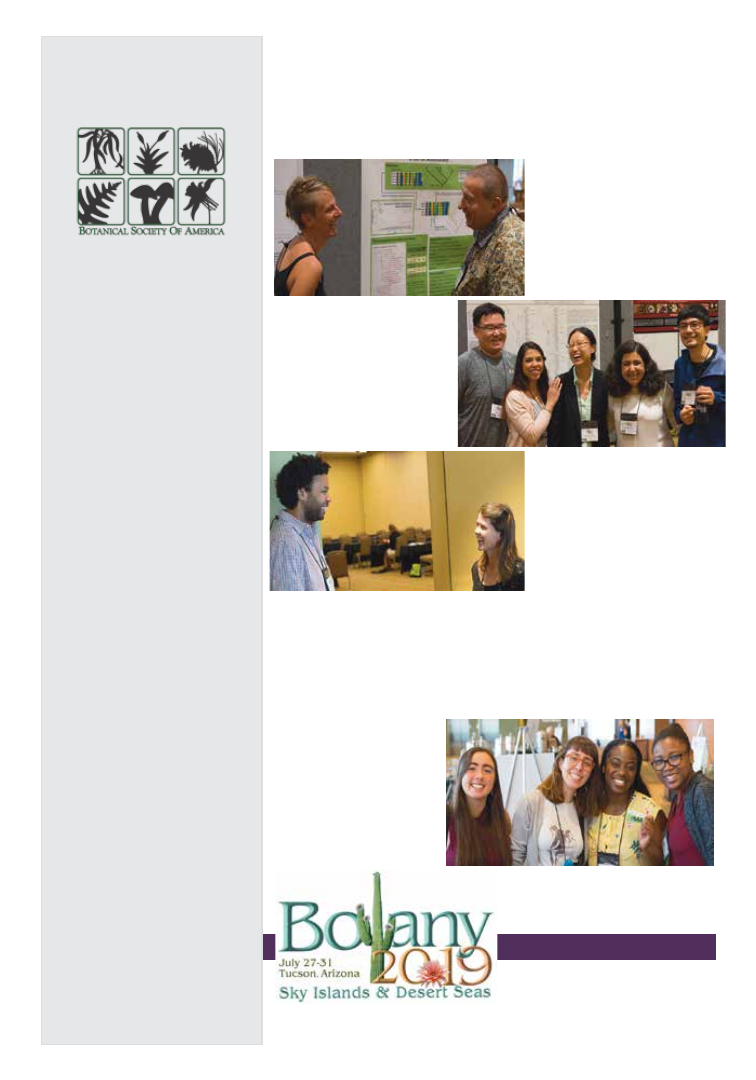
Plant Science Bulletin
Featured Images
The Botanical Society of
America is a membership soci-
ety whose mission is to: pro-
mote botany, the field of basic
science dealing with the study
& inquiry into the form, func-
tion, development, diversity,
reproduction, evolution, & uses
of plants & their interactions
within the biosphere.
ISSN 0032-0919
Published quarterly by
Botanical Society of America, Inc.
4475 Castleman Avenue
St. Louis, MO 63166-0299
Periodicals postage is paid at
St. Louis, MO & additional
mailing offices.
POSTMASTER:
Send address changes to:
Botanical Society of America
Business Office
P.O. Box 299
St. Louis, MO 63166-0299
bsa-manager@botany.org
The yearly subscription rate
of $15 is included
in the membership
Address Editorial Matters (only) to:
Mackenzie Taylor, Editor
Department of Biology
Creighton University
2500 California Plaza
Omaha, NE 68178
Phone 402-280-2157
psb@botany.org
Plant Science Bulletin
Fall 2018 Volume 64 Number 3
BOTANY conferences are known for great speakers,
interesting symposia, and helpful workshops. But the true
spirit of the conferences lies in the unexpected conversations,
the sudden collaborative ideas, and the pure camaraderie
between the attendees.
We can't wait for BOTANY 2019!
